Sites: news | india | latam | brasil | indonesia
Feeds: news | india | latam | brasil | indonesia
topic: Old Growth Forests
Social media activity version | Lean version
Forest and climate scientists fear Biden delay on mature forest protection
- More than 200 forest ecologists and top climate scientists, including Jim Hansen and Michael Mann, have written the Biden administration urging it to quickly move forward on the president’s commitment to protect old-growth and mature forests on federal lands.
- The scientists made an urgent plea for an immediate moratorium on logging federal forests with trees 100 years old or older, many of which remain vulnerable to logging and dozens of timber sales nationally. They also asked for the establishment of substantive federal management standards to protect those forests.
- Federally owned old-growth and mature forests play an outsized role in storing carbon, offering a vital hedge against escalating climate change.
- At stake are 112.8 million acres (45.6 million hectares) of old-growth and mature forest on federal lands, according to a 2023 U.S. Forest Service and Bureau of Land Management inventory — an area larger than California. Less than a quarter of those forests are currently protected against logging.
Forest conservation ‘off-track’ to halt deforestation by 2030: New report
- The world lost 6.6 million hectares (16.3 million acres) of forest, an area larger than Sri Lanka, and deforestation rates increased by 4% in 2022, according to a report published Oct. 24 that tracks commitments to forest conservation.
- The Forest Declaration Assessment is an annual evaluation of deforestation rates against a 2018-2020 deforestation and forest degradation baseline compiled by civil society and research organizations.
- Much of the forest loss occurred in the tropics, and nearly two-thirds of it was in relatively undisturbed primary forests, while forest degradation, more than deforestation, remains a serious problem in temperate and boreal forests.
- Despite being far off the pace to achieve an end to deforestation by 2030, a goal that 145 countries pledged to pursue in 2021, more than 50 countries have cut their deforestation rates and are on track to end deforestation within their borders by the end of the century.
Elephants invade as habitat loss soars in Nigerian forest reserve
- Elephants straying out of Afi River Forest Reserve in the Nigerian state of Cross River are reportedly damaging surrounding farms.
- This uptick in human-wildlife conflict comes as satellite data show continuing and increasing deforestation in the Afi River reserve and other protected areas.
- The habitat in Afi River Forest Reserve provides a crucial corridor that connects critically endangered Cross River gorilla populations in adjacent protected areas.
- As in other Nigerian forest reserves, agriculture, poverty and a lack of monitoring and enforcement resources are driving deforestation in the Afi River reserve.
Poverty-fueled deforestation of Nigerian reserve slashes hope for rare chimps
- Less than 20 year ago, Akure-Ofosu Forest Reserve was regarded as a potential conservation site for endangered Nigeria-Cameroon chimpanzees.
- But between 2001 and 2022, the reserve lost nearly half of its old growth forest cover, a trend that shows no sign of stopping.
- Akure-Ofosu’s forest is being lost due to the proliferation small-scale farms within the reserve.
- Facing an unemployment rate surpassing 50% and a soaring level of poverty, many Nigerians have few options other than to settle in the country’s protected areas and hew farms from forest.
The U.S. has cataloged its forests. Now comes the hard part: Protecting them
- In April 2022, President Biden instructed the U.S. Forest Service and Bureau of Land Management to do a thorough inventory of forested public lands as a part of his climate mitigation strategies to reduce U.S. carbon emissions by 50% by 2030.
- The new study, released April 20, identifies a total of 112.8 million acres of mature and old-growth forests on federal lands across all 50 states, an area larger than the state of California.
- Forest advocates largely heralded the new inventory, so long as it serves as a road map for putting those millions of acres off-limits to logging so the forests and their biodiversity can remain intact to fight climate change.
- The U.S. Forest Service and Bureau of Land Management have long supported logging for timber and other wood products on the majority of lands they oversee. During a 60-day public comment period, forest advocates will argue that all forests in the inventory be fully protected from logging.
Even in recovery, previously logged tropical forests are carbon sources: Study
- Logging of tropical forests may result in more carbon being released into the atmosphere than previously thought, according to new research.
- The study conducted in Malaysian Borneo demonstrates that logged tropical forests are a significant and persistent net source of carbon emissions for at least one decade after disturbance.
- The study authors say the amount of carbon being sequestered across the world’s tropical forests may be considerably lower than currently estimated and recommend a shift toward more sustainable logging practices and better accounting of carbon emissions and uptake.
- As the body of evidence expands demonstrating how human activity is impacting the capacity of forests to mitigate climate change, experts say reducing fossil fuel emissions is paramount.
Study identifies priority forests in Oregon for max conservation benefit
- The coastal temperate rainforests of Oregon are important carbon storage facilities and provide 80% of the state’s drinking water.
- A recent study is the first to combine data on drinking water sources, biodiversity, carbon storage and forest resilience to determine which forests are the highest priority for conservation.
- Most high-priority forests are on federal lands, but only 10% are protected at the highest levels, which forbids logging and other extractive activities.
- Protecting forests is important for carbon storage and water conservation, with the loss of forest cover shown to reduce water supplies by up to 50% compared to maintaining mature forests.
Beef is still coming from protected areas in the Amazon, study shows
- According to a new study, 1.1 million cattle were bought directly from protected areas and another 2.2 million spent at least a portion of their lives grazing in protected areas and Indigenous territories.
- Researchers compiled public records on cattle transit, property boundaries and protected area boundaries between 2013 and 2018. The study period ended in 2018 because, “at the start of 2019, this critical information became less available,” the lead author said.
- Under Brazil’s current President Jair Bolsonaro, who was elected at the start of 2019, the country has seen policies weakening various environmental protections and monitoring agencies, and deforestation has reached its highest levels in 15 years.
- Around 70% of deforestation in the Amazon has been linked to cattle ranching. Meat producers have made commitments to stop sourcing from illegally deforested lands, but a lack of information about where cattle are grazing has allowed many companies to escape accountability.
New study identifies mature forests on U.S. federal lands ripe for protection
- A new mapping study conducted by NGOs finds that older forests in the U.S. make up about 167 million acres, or 36%, of all forests in the contiguous 48 states. About a third of this, or roughly 58 million acres, are on federal lands. The rest are controlled by non-federal entities, including large amounts held by private owners.
- Just 24% of U.S. Forest Service and Bureau of Land Management forests are fully protected, with the rest being at various levels of risk from logging, offering the Biden administration an opportunity to more thoroughly protect far more old-growth and mature forests on federal lands in order to help meet U.S. climate goals.
- The new study identified a challenge inherent in this strategy: The majority of federal lands are in the West, but one of the highest concentrations of U.S. mature and old-growth forests is in the Southeast, where most older forests are on private property. Privately held old-growth and mature forests are poorly protected in the U.S.
- If the U.S. wants to broaden its carbon emission reduction strategy, say researchers, then mature forest conservation should include both federal and private holdings. Private forests could be protected via state regulation, utilizing conservation easements and payments for verifiable carbon offsets, along with land trust acquisition.
New tech aims to track carbon in every tree, boost carbon market integrity
- Climate scientists and data engineers have developed a new digital platform billed as the first-ever global tool for accurately calculating the carbon stored in every tree on the planet.
- Founded on two decades of research and development, the new platform from nonprofit CTrees leverages artificial intelligence-enabled satellite datasets to give users a near-real-time picture of forest carbon storage and emissions around the world.
- With forest protection and restoration at the center of international climate mitigation efforts, CTrees is set to officially launch at COP27 in November, with the overall aim of bringing an unprecedented level of transparency and accountability to climate policy initiatives that rely on forests to offset carbon emissions.
- Forest experts broadly welcome the new platform, but also underscore the risk of assessing forest restoration and conservation projects solely by the amount of carbon sequestered, which can sometimes be a red herring in achieving truly sustainable and equitable forest management.
British Columbia delays promised protections as old growth keeps falling
- Two years after British Columbia’s majority party promised a logging “paradigm shift” to conserve what’s left of the province’s tall old growth forests, Mongabay observed dramatic clear cutting on Vancouver Island in forests slated for protection. Old growth harvesting continues across British Columbia (BC) today.
- The BC minister of land management told Mongabay that the government, in partnership with First Nations, has deferred logging on 1.7 million hectares of old growth forests. But critics contest those numbers and note that much of these deferrals are for scubby alpine forests that aren’t in danger of being logged.
- First Nation leaders have been tasked by the government to determine which old growth forests to protect. This presents Indigenous communities with an economic conundrum, as many tribes will lose much-needed logging revenue if they choose conservation.
- Today, BC has many second-growth tree plantations that give the appearance of vast wooded expanses. But as Mongabay observed in July, these tree farms are “ecological deserts” that store less carbon than tall tree old growth and harbor little biodiversity as BC experiences intensifying climate impacts partly due to decades of overlogging.
In Congo, a carbon sink like no other risks being carved up for oil
- New research has revealed that the peatlands of the Congo Basin are 15% larger than originally thought.
- This area of swampy forest holds an estimated 29 billion metric tons of carbon, which is the amount emitted globally through the burning of fossil fuels in three years.
- Beginning July 28, the government of the Democratic Republic of Congo, where two-thirds of these peatlands lie, will auction off the rights to explore for oil in 27 blocks across the country.
- Scientists and conservationists have criticized the move, which the government says is necessary to fund its operations. Opponents say the blocks overlap with parts of the peatlands, mature rainforest, protected areas, and a UNESCO World Heritage site.
Authorities and Yobin communities clash as deforestation spikes in Indian national park
- Namdapha National Park is India’s third-largest national park and is home to thousands of species, including tigers, clouded leopards and an endemic species of flying squirrel that has only been observed once by scientists.
- Satellite data show deforestation has increased in the park over the last two decades.
- Members of an Indigenous group called the Yobin have been living in portions of the park for generations, but park authorities consider Yobin settlements to be “encroachments” and the main driver of deforestation and poaching in Namdapha National Park
- In the last few months, authorities have destroyed at least eight Yobin settlements inside the park.
End old-growth logging in carbon-rich ‘crown jewel’ of U.S. forests: Study
- A recent study of the Tongass National Forest, the largest in the United States, found that it contains 20% of the carbon held in the entire national forest system.
- In addition to keeping the equivalent of about a year and a half of the U.S.’s greenhouse gas emissions out of the atmosphere, the forest is also home to an array of wildlife, including bald eagles, brown bears and six species of salmon and trout.
- Scientists and conservationists argue that the forest’s old-growth trees that are hundreds of years old should be protected from logging.
- They are also hoping that efforts by the administration of President Joe Biden are successful in banning the construction of new roads in the Tongass.
Opaque infrastructure project ‘a death sentence’ for Cambodia’s Prey Lang Wildlife Sanctuary
- In November 2021, the Cambodian government approved the development of 299 kilometers (186 miles) of 500-kilovolt power lines through Prey Lang Wildlife Sanctuary by Schneitec Northern to link Phnom Penh’s electrical grid to two coal-fired power plants in Laos, following a power purchase agreement signed in October 2019.
The power lines are planned to transect the largest tract of lowland evergreen forest remaining in Southeast Asia, and critics say the project puts at risk at risk one of the country’s largest carbon stocks as well as poses a threat to Prey Lang’s Indigenous residents and two watersheds vital to Tonle Sap Lake, which sustains millions of Cambodians.
- Leaked documents from April 2021 show that the consulting firm that conducted the environmental impact assessment had suggested three possible routes for Schneitec’s power lines, with two alternative routes that skirted the already-deforested eastern and western edges of the protected area respectively. Industry experts have suggested that building power lines through forested terrain can cost between 1.5 and three times as much as through scrubland or flat terrain.
- The power line plans come as satellite data reveal 2021 was the worst year on record for deforestation in Prey Lang and international institutions condemn widespread illegal logging in the protected area.
- This story was supported by the Pulitzer Center’s Rainforest Investigations Network where Gerald Flynn is a fellow
Fossil evidence confirms persistence of prehistoric forests in Brunei
- A recent study published in the journal PeerJ reports the excavation of fossilized leaves from ancient forests at least 4 million years old in Brunei on the island of Borneo.
- More than 80% of the leaves the team found were from the Dipterocarpaceae family, trees that remain dominant today, confirming their long-standing role in anchoring Borneo’s species-rich ecosystems.
- The discovery adds to the urgency to protect these forests from logging or development for agriculture because once they’re gone, they will be difficult to get back, the authors say.
Satellite data brings new insights on what drives Amazon forest loss
- Satellite imagery of the Amazon can now distinguish for the first time between different factors contributing to forest loss.
- The satellite readings show that approximately 1.1 million hectares (2.7 million acres) were deforested in the Brazilian Amazon last year, the highest since 2017.
- In the Amazonian regions of Peru and Colombia, there was significant deforestation, but these were down from previous years.
Large-scale logging in Cambodia’s Prey Lang linked to politically-connected mining operation
- Illegal logging appears to be taking place openly inside a swath of protected forest that authorities in Cambodia have only authorized for a feasibility study for limestone mining. Locals and conservationists say the wood leaves the concession awarded to KP Cement in the Prey Lang Wildlife Sanctuary and is laundered through sawmills owned by Think Biotech.
- It’s not clear why the Cambodian authorities would award a concession in the middle of one of the last remaining swaths of primary forest left in the country, or why they would give it to a company linked to a tycoon with a long history of environmentally destructive activities.
- New data from Global Forest Watch show that 2021 was the worst year on record for deforestation in Prey Lang, with more than 8,000 hectares (20,000 acres) of primary forest lost in what appears to be a trend of increasing destruction.
- This story was supported by the Pulitzer Center’s Rainforest Investigations Network where Gerald Flynn is a fellow
EU Parliament’s Environment Committee urges scale back of biomass burning
- The European Parliament’s Environment Committee this week made strong, but nonbinding, recommendations to put a brake on the EU’s total commitment to burning forest biomass to produce energy. While environmentalists cautiously hailed the decision, the forestry industry condemned it.
- A key recommendation urges that primary woody biomass (that made from whole trees) to produce energy and heat no longer receive government subsidies under the EU’s revised Renewable Energy Directive (RED).
- Another recommendation called for primary woody biomass to no longer be counted toward EU member states’ renewable energy targets. Currently, biomass accounts for 60% of the EU’s renewable energy portfolio, far more than zero-carbon wind and solar.
- The Environment Committee recommendations mark the first time any part of the EU government has questioned the aggressive use of biomass by the EU to meet its Paris Agreement goals. A final decision by the EU on its biomass burning policies is expected in September as part of its revised Renewable Energy Directive.
President Biden signs order aimed at protecting old-growth forests across U.S.
- U.S. President Joe Biden signed an executive order today aimed at protecting old-growth forests on federal lands across the United States.
- Federal agencies are directed to define, inventory and better protect the nation’s oldest trees by leaning into reforestation commitments and employing nature-based solutions to reduce emissions.
- The order is part of the Biden administration’s pledge to end natural forest loss by 2030, while restoring at least an additional 200 million hectares [494 million acres] of forests and other ecosystems.
- The order does not ban the logging of old-growth trees which scientists say is necessary to address deforestation and emissions from the logging industry which emits comparable levels of CO2 to the emissions from coal-burning.
Saving old-growth forests: Q&A with Amazon Watch’s Leila Salazar-López
- A new documentary called “The Last Stand,” released on Earth Day 2022, goes inside the protests against the logging of the Fairy Creek old-growth forests in British Columbia, Canada.
- Leila Salazar-López, executive director of Amazon Watch, an NGO dedicated to fighting deforestation and protecting the rights of Indigenous communities in the world’s biggest rainforest, spoke in the film about the larger implications of cutting down old-growth forests.
- In an interview with Mongabay, Salazar-López talks deforestation in the Amazon, the flaws of carbon offset policies, and the important role that Indigenous and local people play in conserving the last of Earth’s old-growth forests.
Deforestation on the rise as poverty soars in Nigeria
- Akure-Ofosu Forest Reserve was established to help protect what is now one of largest remaining tracts of rainforest in Nigeria, and is home to many species.
- But fire and logging is rampant in the reserve, with satellite data showing it lost 44% of its primary forest cover in just two decades; preliminary data indicate deforestation may be increasing further in 2022.
- Sources say poverty is the driving force behind the deforestation of Akure-Ofosu and other protected areas in Nigeria.
- According to the World Bank, 4 in 10 Nigerians – about 80 million people – were living below in poverty in 2019, with the COVID-19 pandemic pushing another 5 million people below the poverty line by 2022.
Can ecotourism save Cambodia’s ‘ghost parks’?
- Cambodia’s 2021 signing into law of Sub-decree No. 30, which removed official protection from some 127,000 hectares of land formerly included in national parks, reserves and wildlife sanctuaries in Koh Kong province, has conservationists concerned about the ecological integrity of southern Cambodia.
- But experts caution that other protected areas in the country are hardly faring better, claiming that “a lack of commitment and vision, systemic corruption at varies levels and competing interests by state and private actors” is contributing to the rapid degradation of Cambodia’s remaining protected forest.
- There is some agreement between conservationists and government officials that the country does not have the resources to effectively manage its protected areas.
- As a solution, some point to Africa, where public-private ecotourism partnerships have been successful at preserving habitat. But others disagree.
Endangered wildlife face perilous future as vital habitat loses protection in Cambodia
- In March 2021, this imbalance has widened into a chasm as Cambodia’s government signed Sub-decree No. 30 into law, effectively revoking protection from some 127,000 hectares of land in reserves, wildlife sanctuaries and national parks in the southern province of Koh Kong province.
- One of the protected areas affected is Peam Krasop Wildlife Sanctuary, which lost almost a third of its total land area to the sub-decree — meaning these habitats are now for sale.
- Peam Krasop is home to species threatened with extinction, such as the hairy-nosed otter — the world’s rarest otter species — and the fishing cat.
- Researchers say the degradation of these habitats could result in “trophic cascades“ in which the loss of key species destabilizes entire ecosystems , which in turn may lead to further loss.
How a ‘dirty gambling company’ may have set the standard for habitat destruction in Cambodia
- Union Development Group (UDG) is a Chinese company that was granted a 36,000-hectare concession in Cambodia’s Botum Sakor National Park in 2008, followed by an additional 9,100-hectare concession granted in 2011. Much of Botum Sakor National Park’s forests have been cleared by UDG and other companies.
- On Sep. 15, 2020, the United States Treasury Department, sanctioned UDG for “serious human rights abuses and corruption,” noting that UDG had enlisted the support of the Royal Cambodian Armed Forces to evict and harass residents, and also managed to skirt the 10,000-hectare limit on land concessions by “falsely registering as a Cambodian-owned entity.”
- In 2021, the Cambodian government signed into law Sub-decree No. 30, which transformed some 127,000 hectares of protected land in Koh Kong province into state-private land.
- Conservationists, researchers and local residents interviewed by Mongabay worry that the sub-decree will mean that many other parts of Koh Kong province will follow in the destruction of Botum Sakor.
California redwood forest returned to Indigenous guardianship, conservation
- Ownership of a 215-hectare (532-acre) redwood forest along California’s north coast was returned to Sinkyone tribes and has been renamed Tc’ih-Léh-Dûñ.
- The InterTribal Sinkyone Wilderness Council is working with Save the Redwoods League, which donated the land, to protect California’s remaining old-growth forest, along with endangered species such as the northern spotted owl and marbled murrelet.
- The 30-year conservation plan and land transfer deal is funded by the Pacific Gas & Electric Company (PG&E) in order to offset habitat loss that may result from the company’s activities.
- Indigenous forest conservation principles, such as controlled burnings, will be included in the tribal protected area – an inclusion that should be seen in the 30×30 initiative to protect 30% of lands and ocean by 2030, says Save the Redwoods League and the tribal council.
Endangered chimps ‘on the brink’ as Nigerian reserve is razed for agriculture, timber
- As rainforest throughout much of the country has disappeared, Nigeria’s Oluwa Forest Reserve has been a sanctuary for many species, including Nigeria-Cameroon chimpanzees – the rarest chimpanzee subspecies.
- But Oluwa itself has come under increasing deforestation pressure in recent years, losing 14% of its remaining primary forest between 2002 and 2020.
- Oluwa’s deforestation rate appears to be increasing, with several large areas of forest loss occurring in 2021– including in one of the last portions of the reserve known to harbor chimps.
- Agriculture and timber extraction are the main drivers of deforestation in Oluwa; smallholders looking to eke out an existence continue to move into the reserve and illegally clear forest and hunt animals for bushmeat, while plantation companies are staking claims to government-granted concessions.
Agricultural frontier advances in Nicaraguan biosphere reserve
- The Río San Juan Biosphere Reserve in Nicaragua encompasses some 1.8 million hectares, as well as smaller protected areas such as Indio Maíz Biological Reserve, Los Guatuzos Wildlife Refuge, the Fortress of the Immaculate Conception, Bartola Nature Reserve, and the Solentiname Islands.
- The Río San Juan Biosphere Reserve lost around 600,000 hectares of forest between 2011 and 2018.
- Satellite data show forest loss has intensified in the northern and central parts of the reserve since 2018, and only fragmented portions of primary forest remain.
- Sources said that the Ministry of Environment and Natural Resources and the National Forestry Institute are responsible for ensuring the effective conservation of the country’s protected areas, but that they are not currently fulfilling their monitoring duties.
The past, present and future of the Congo peatlands: 10 takeaways from our series
 This is the wrap-up article for our four-part series “The Congo Basin peatlands.” Read Part One, Part Two, Part Three and Part Four. In the first half of December, Mongabay published a four-part series on the peatlands of the Congo Basin. Only in 2017 did a team of Congolese and British scientists discover that a […]
This is the wrap-up article for our four-part series “The Congo Basin peatlands.” Read Part One, Part Two, Part Three and Part Four. In the first half of December, Mongabay published a four-part series on the peatlands of the Congo Basin. Only in 2017 did a team of Congolese and British scientists discover that a […]
Carbon and communities: The future of the Congo Basin peatlands
- Scientific mapping in 2017 revealed that the peatlands of the Cuvette Centrale in the Congo Basin are the largest and most intact in the world’s tropics.
- That initial work, first published in the journal Nature, was just the first step, scientists say, as work continues to understand how the peatlands formed, what threats they face from the climate and industrial uses like agriculture and logging, and how the communities of the region appear to be coexisting sustainably.
- Researchers say investing in studying and protecting the peatlands will benefit the global community as well as people living in the region because the Cuvette Centrale holds a vast repository of carbon.
- Congolese researchers and leaders say they are eager to safeguard the peatlands for the benefit of everyone, but they also say they need support from abroad to do so.
Holding agriculture and logging at bay in the Congo peatlands
- The peatlands of the Congo Basin are perhaps the most intact in the tropics, but threats from logging, agriculture and extractive industries could cause their rapid degradation, scientists say.
- In 2021, the government of the Democratic Republic of Congo (DRC) announced that it was planning to end a moratorium on the issuance of logging concessions that had been in place for nearly two decades.
- The move raised concerns among conservation groups, who say the moratorium should remain in place to protect the DRC’s portion of the world’s second-largest rainforest.
- Today, timber concession boundaries overlap with the peatlands, and though some companies say they won’t cut trees growing on peat, environmental advocates say that any further issuance of logging concessions in the DRC would be irresponsible.
Layers of carbon: The Congo Basin peatlands and oil
- The peatlands of the Congo Basin may be sitting on top of a pool of oil, though exploration has yet to confirm just how big it may be.
- Conservationists and scientists argue that the carbon contained in this England-size area of peat, the largest in the tropics, makes keeping them intact more valuable, not to mention the habitat and resources they provide for the region’s wildlife and people.
- Researchers calculate that the peatlands contain 30 billion metric tons of carbon, or about the amount humans produce in three years.
- As the governments of the Republic of Congo and the Democratic Republic of Congo work to develop their economies, they, along with many policymakers worldwide, argue that the global community has a responsibility to help fund the protection of the peatlands to keep that climate-warming carbon locked away.
The ‘idea’: Uncovering the peatlands of the Congo Basin
- In 2017, a team of scientists from the U.K. and the Republic of Congo announced the discovery of a massive peatland the size of England in the Congo Basin.
- Sometimes called the Cuvette Centrale, this peatland covers 145,529 square kilometers (56,189 square miles) in the northern Republic of Congo and the Democratic Republic of Congo, and holds about 20 times as much carbon as the U.S. releases from burning fossil fuels in a year.
- Today, the Congo Basin peatlands are relatively intact while supporting nearby human communities and a variety of wildlife species, but threats in the form of agriculture, oil and gas exploration and logging loom on the horizon.
- That has led scientists, conservationists and governments to look for ways to protect and better understand the peatlands for the benefit of the people and animals they support and the future of the global climate.
Young forests can help heal tropical aquatic ecosystems: Study
- Microbial communities are important indicators of ecological degradation in the tropics, often reflecting levels of disturbance and contamination in rivers and streams.
- In an attempt to monitor the ecological condition of various streams in central Panama, researchers at the Smithsonian Tropical Research Institute (STRI) assessed the impact of various land usages, such as cattle pasture and secondary forest, on microbial diversity and community structure.
- In less than a decade, researchers say, reforested land allows bacterial communities to recover, highlighting the importance of reforestation for overall ecosystem recovery.
Deforestation soars in Nigeria’s gorilla habitat: ‘We are running out of time’
- Afi River Forest Reserve (ARFR), in eastern Nigeria’s Cross River state, is an important habitat corridor that connects imperiled populations of critically endangered Cross River gorillas.
- But deforestation has been rising both in ARFR and elsewhere in Cross River; satellite data show 2020 was the biggest year for forest loss both in the state and in the reserve since around the turn of the century – and preliminary data for 2021 suggest this year is on track to exceed even 2020.
- Poverty-fueled illegal logging and farming is behind much of the deforestation in ARFR. Resource wars have broken out between communities that have claimed the lives of more than 100, local sources say.
- Authorities say a lack of financial support and threats of violence are limiting their ability to adequately protect what forest remains.
The great Koh Kong land rush: Areas stripped of protection by Cambodian gov’t being bought up
- A regulation issued earlier this year in Cambodia’s Koh Kong province purported to take land from protected areas and grant the land titles to families living in the area.
- But developments since then, and interviews with residents and brokers, paint the scheme as a massive land grab orchestrated by the country’s political elite.
- Politicians and companies have been snapping up the newly degazetted land, among them a firm suspected of being a front for pulpwood giant APP.
- Among those said to be profiting from the land grab is Ly Yong Phat, dubbed “The King of Koh Kong,” a politician and businessman with a long history of quashing the rights of those who occupy land he desires.
Old-growth forests of Pacific Northwest could be key to climate action
- Coastal temperate rainforests are among the rarest ecosystems on Earth, with more than a third of their total remaining global area located in a narrow band in the U.S. and Canadian Pacific Northwest. These are some of the most biodiverse, carbon-dense forests outside the tropics, thus crucial to carbon sequestration.
- “The diversity of life that is all around us is incredibly rare,” a forest ecologist tells Mongabay on a hike in Olympic National Park. “It’s all working together. And there’s not much left here on the Olympic Peninsula or just north of us in British Columbia.”
- British Columbia did the unexpected in 2016 by establishing the Great Bear Rainforest Agreement, protecting 6.4 million hectares (15.8 million acres) of coastal old-growth forest. But elsewhere in the province, 97% of all tall, old-growth forest has been felled for timber and wood pellets. In the U.S., protection outside Olympic National Park is scant.
- New protections are promised, but old-growth logging continues apace. The U.N. says the world must aggressively reduce carbon emissions now, as scientists press the Biden administration to create a national Strategic Carbon Reserve to protect a further 20 million hectares (50 million acres) of mature forested federal lands from logging to help meet U.S. carbon-reduction goals by 2030.
Fires rage in Bolivia’s Chiquitania region
- Authorities are battling an outbreak of wildfires in eastern Bolivia’s Chiquitania region.
- Satellite data show fires have intensified over the past two weeks and are invading protected areas.
- The fires are destroying habitat spared by Bolivia’s extreme fire season of 2019.
- Wildfires in Bolivia are often associated with burning for agriculture, and satellite data and imagery show recent fires on agricultural land that directly preceded nearby blazes that have spread into protected forest.
Deforestation surge continues amid deepening uncertainty in Myanmar
- Satellite data from the University of Maryland show a surge in forest clearing in northern parts of the Tanintharyi region in southern Myanmar, including within a protected area.
- Major drivers of deforestation are commercial oil palm and rubber plantations, small-scale agriculture, and infrastructure development.
- In the region’s south, forest loss is affecting the already fragmented habitat of globally threatened Gurney’s pittas and tigers, among other rare species.
- Meanwhile, activists say the political turmoil following the Feb. 1 military coup has effectively halted community-led forest protection work.
USAID redirects funding in Cambodia as future of Prey Lang Wildlife Sanctuary hangs in the balance
- In June, the United States Agency for International Development (USAID) announced it would be ending its assistance to Cambodian government entities through the USAID Greening Prey Lang project.
- In its statement, the U.S. Embassy in Phnom Penh said the decision is due to continued and unprosecuted illegal logging and wildlife crimes in the protected area, along with efforts by the Cambodian government to “silence and target local communities” and activists. The Cambodian government, however, maintains that the cessation of funding from USAID was due to the ministry having reached capacity to protect Prey Lang without foreign funding.
- Satellite data show Prey Lang has lost nearly 9% of its forest cover over the past five years, and researchers and activists say its remaining forest is being eyed by logging companies.
- While USAID’s decision to stop funding the Cambodian government has been well-received by many academics and environmentalists, there is fear that the move could give the green light to government-supported logging operations.
Nearly 1 million km2 of intact forests menaced by extractives, study finds
- A new report shows that 975,000 km2 (376,500 mi2) of virgin forest, about the size of Egypt, is threatened by mining and oil and gas extraction.
- About 11% of the planet’s intact forests lie within mining concessions and 8% inside oil and gas concessions.
- Their loss spells trouble for efforts to save endangered wildlife, tackle climate change and preserve Indigenous communities inhabiting these undisturbed lands.
- The overlap between concessions and intact forests was the greatest in Central Africa, especially in the Congo Basin, which has seen a surge in extractive activity in recent years.
As soy frenzy grips Brazil, deforestation closes in on Indigenous lands
- A large swath of rainforest has been cleared and was burned on the edge of the Wawi Indigenous Territory in the Brazilian Amazon.
- The fire is one of many being set to clear land for soy cultivation, much of it legally mandated, as demand for the crop sees growers push deeper into the rainforest and even into Indigenous and protected areas.
- Enforcement against forest destruction has been undermined at the federal level, thanks to budget cuts and loosened restrictions by the administration of President Jair Bolsonaro.
- The burning threatens to compound health problems in Indigenous communities amid the COVID-19 pandemic, while the use of agrochemicals on the soy plantations poses longer-term hazards.
Carving up the Cardamoms: Conservationists fear massive land grab in Cambodia
- Conservationists have expressed concern over a recently published regulation that makes nearly 127,000 hectares (313,800 acres) of previously protected land potentially available for sale or rent to politically connected businesses.
- Known as Sub-decree No. 30, the order is ostensibly meant to redistribute land to communities that had previously lost control of it after it was taken over by the Ministry of Environment and conservation NGOs to manage as protected areas.
- But activists and experts point to several features of the regulation — the proximity of some of the requisitioned land to concessions held by powerful magnates; the inclusion of uninhabited primary forest; the opacity of the land-titling process promised to local communities — that suggest it’s another form of land grabbing.
Forest advocates press EU leader to rethink views on biomass and energy
- EU officials are currently working to finalize REDII renewable energy policy revisions and amendments by mid-July for EU parliamentary review. One component of that review is to determine whether forest biomass burning will continue to be considered carbon neutral by the 27 EU member states.
- Current science is clear: burning forest biomass to make energy is not carbon neutral, and the burning of wood pellets is dirtier per unit of electricity than burning coal. But the forestry industry and EU continue defending biomass, prompting an open letter from forest advocates harpooning the policy.
- In the leadup to the updated REDII policy revision proposals, European Commission Exec. VP Frans Timmermans says he truly values forests, but simultaneously believes that cutting them down and burning them to make electricity remains viable climate policy. More than 50% of the EU’s current wood harvest is being burned for energy.
- “Ecocide threatens the survivability of our forests. I certainly don’t underestimate the challenges we face, but still, I believe [burning forest] biomass can play a very useful role in the energy transition,” says Timmermans.
Casinos, condos and sugar cane: How a Cambodian national park is being sold down the river
- Botum Sakor National Park in southern Cambodia has lost at least 30,000 hectares of forest over the past three decades.
- Decades of environmental degradation go back to the late 1990s when the Cambodian government began handing out economic land concessions for the development of commercial plantations and tourist infrastructure.
- NGOs in Cambodia are said to be unwilling to speak out against the destruction of Botum Sakor because they are afraid they will not be allowed to operate in the country if they do.
- The government says economic activity is vital to improve people’s livelihoods and reduce poverty.
Drugs and agriculture cause deforestation to skyrocket at Honduran UNESCO site
- Honduras’ Río Plátano Biosphere Reserve occupies a large portion of the country’s eastern region.
- However, despite official protection and recognition as a UNESCO World Heritage Site, Río Plátano is plagued by deforestation; satellite data show the biosphere reserve lost 13% of its primary forest cover between 2002 and 2020.
- Deforestation shot up in 2020, nearly doubling the amount of forest loss over 2019. 2021 may be another rocky year for the biosphere reserve, with satellite data showing several “unusually high” spikes of clearing activity so far this year.
- Sources say deforestation in the reserve is being driven by logging, agriculture and the drug trade.
Deforestation ramps up in Cambodia’s Keo Seima Wildlife Sanctuary
- The forests of Keo Seima Wildlife Sanctuary boast a plethora of wildlife – including several endangered and recently described species.
- But the habitat these animals depend on is disappearing, with 32% of Keo Seima’s primary forest cleared over past 20 years.
- Recent satellite data suggest 2021 is not starting out well for Keo Seima, with higher numbers of deforestation alerts detected than in years past.
- Major drivers of forest loss in Keo Seima include illegal logging and agriculture.
Leaders make bold climate pledges, but is it ‘all just smoke and mirrors?’: Critics
- Forty nations — producers of 80% of annual carbon emissions — made pledges of heightened climate ambition this week at U.S. President Joe Biden’s Leaders Summit on Climate. But as each head of state took to the podium, climate activists responded by pointing to the abysmal lack of action by those nations.
- As the U.S. promised to halve its emissions by 2030, advocates noted the lack of policies in place to achieve that goal, and the likelihood of intense Republican political resistance. China promised at the summit to eliminate coal plants, but 247 gigawatts of coal power is currently in planning or development stages there.
- The UK, EU, Japan, and South Korea all pledged to do more, but all are committed to burning forest biomass to replace coal — a solution relying on a longstanding carbon accounting error that counts forest biomass as carbon neutral, though scientists say it produces more emissions than coal per unit of electricity made.
- “This summit could be a critical turning point in our fight against climate change, but we have seen ambitious goals before and we have seen them fall flat. Today’s commitments must be followed with effective implementation, and with transparent reporting and accurate carbon accounting,” said one environmental advocate.
With British Columbia’s last old-growth at risk, government falters: Critics
- British Columbia’s ruling New Democratic Party last autumn pledged to conserve 353,000 hectares (1,363 square miles) of old-growth forest. But so far, the NDP has largely failed to act on this pledge, even as forestry companies rush to procure and cut old-growth in the Canadian province.
- Unless the government acts quickly on its commitment, BC’s last old-growth could be gone in as little as 5-10 years say some forest ecologists. In addition, intense logging could mean that Canada is not going to meet its Paris Climate Agreement carbon-reduction goals.
- While the NDP promised a new policy boosting forest perseveration over forestry, critics say that — despite its rhetoric — the government continues to prop up an industry in decline to help rural communities in need of jobs.
- While it’s not now cutting BC old-growth, activists worry over the acquisition by U.K. Drax Group of BC’s largest wood pellet producer, Pinnacle Renewable Energy and its seven BC pellet mills. Drax provides up to 12% of the U.K.’s energy at the world’s largest pellet-burning plant. Its BC exports to Japan are also expected to grow.
Cattle-driven clearing continues in Brazil’s Triunfo do Xingu protected area
- Triunfo do Xingu Environmental Protection Area lies in the ecologically rich Xingu Basin in the Brazilian Amazon and spans some 1.7 million hectares (4.2 million acres) — an area more than half the size of Belgium.
- Despite its protected status, the area has been heavily deforested, losing 476,000 hectares (1.18 million acres) of humid primary forest between 2006 and 2020, according to satellite data from the University of Maryland (UMD), a 32% decrease in total forest cover.
- 2020 saw the highest amount of forest loss since the creation of the protected area, nearly 70,000 hectares (173,000 acres) — an area nearly the size of New York City; preliminary data show clearing of Triunfo do Xingu’s forests has continued into 2021, with “unusually high” levels of deforestation detected the week of March 15.
- Deforestation in the region is largely driven by cattle ranching, and sources say the invasions of Triunfo do Xingu are aided by its remoteness as well as lax enforcement of environmental regulations.
Global forest loss increased in 2020
- The planet lost an area of tree cover larger than the United Kingdom in 2020, including more than 4.2 million hectares of primary tropical forests, according to data released today by the University of Maryland.
- Tree cover loss rose in both the tropics and temperate regions, but the rate of increase in loss was greatest in primary tropical forests, led by rising deforestation and incidence of fire in the Amazon, Earth’s largest rainforest.
- The data, which is now available on World Resource Institute’s Global Forest Watch, indicate that forest loss remained persistently high in the immediate aftermath of the pandemic, but “does not show obvious, systemic shifts in forest loss as a result of the COVID-19 pandemic,” according to WRI.
- Destruction of primary tropical forests, the world’s most biologically diverse ecosystems, released 2.64 billion tons of carbon, an amount equivalent to the annual emissions of 570 million cars.
Dutch to limit forest biomass subsidies, possibly signaling EU sea change
- The Dutch Parliament in February voted to disallow the issuing of new subsidies for 50 planned forest biomass-for-heat plants, a small, but potentially key victory for researchers and activists who say that the burning of forests to make energy is not only not carbon neutral, but is dirtier than burning coal and bad climate policy.
- With public opinion opposing forest biomass as a climate solution now growing in the EU, the decision by the Netherlands could be a bellwether. In June, the EU will review its Renewable Energy Directive (RED II), whether to continue allowing biomass subsidies and not counting biomass emissions at the smokestack.
- Currently, forest biomass burning to make energy is ruled as carbon neutral in the EU, even though a growing body of scientific evidence has shown that it takes many decades until forests regrow for carbon neutrality to be achieved.
- The forestry industry, which continues to see increasing demand for wood pellets, argues that biomass burning is environmentally sustainable and a viable carbon cutting solution compared to coal.
Slash-and-burn farming eats away at a Madagascar haven for endangered lemurs, frogs
- The Ankeniheny-Zahamena Corridor (CAZ), a protected area in Madagascar, has experienced a surge in deforestation in the past five months, driven largely by slash-and-burn agriculture.
- The loss of forest threatens rare and endangered wildlife found nowhere else, including lemurs and frogs and geckos, conservationists say.
- Other factors fueling the deforestation include mining for gemstones and cutting of trees to make charcoal.
- The problem in CAZ is emblematic of a wider trend throughout the central eastern region of Madagascar, in both protected and unprotected areas, where 1.5 million hectares (3.7 million acres) of tree cover has been lost since 2001.
‘A disgrace’: Luxury housing plans threaten Cambodia’s Bokor National Park
- Bokor National Park, also known as Preah Monivong Bokor National Park, sits on the southern coast of Cambodia and is a refuge for many threatened plants and animals, as well as a popular tourist site.
- But conservationists warn Bokor’s habitat is under threat from the development of luxury residential estates that are planned to occupy 19,000 hectares inside the park.
- The park gained official protected status in 1993, yet was awarded to Cambodian tycoon Sok Kong in 2007 as a 99-year concession for $1 billion. In the intervening years, Kong’s company has developed an access road, luxury hotels and condominiums in Bokor.
- Meanwhile sources say international and local NGOs, which ordinarily play a meaningful role in preventing widespread forest loss in Cambodia, have been muzzled in the country.
Will new US EPA head continue his opposition to burning forests for energy?
- Under President Donald Trump the U.S. made moves toward legally enshrining the burning of forest biomass to make energy on an industrial scale as a national policy. That same policy has been embraced by the United Kingdom and European Union, helping them move toward a target of zero carbon emissions — at least on paper.
- However, the carbon neutrality label given to the burning of woody biomass to make energy, first proclaimed under the Kyoto Protocol, then grandfathered into the Paris Climate Agreement, has been found by science over the last decade to be more accurately characterized as a risky carbon accounting loophole.
- Current science says that carbon neutrality achieved from burning wood pellets would take 50-100 years to achieve, time the world doesn’t have to slash its emissions. Further, burning woody biomass is inefficient, and dirtier than coal.
- Michael S. Regan, President Biden’s choice for EPA head, wrestled with the problem of producing wood pellets for use as energy while leading North Carolina’s environmental agency. Now he’ll be contending with the issue on a national and possibly global scale. His past views on the topic are laid out in this story in detail.
The Amazon lost an area of primary forest larger than Israel in 2020, new analysis finds
- The Amazon basin lost more than 2 million hectares of primary forest cover in 2020, according to a new report by the Monitoring of the Andean Amazon Project (MAAP).
- This number is higher than the area lost in 2019 and the authors say it may be an underestimation.
- Brazil lost the most primary forest, with Bolivia experiencing high levels of fire-related deforestation of its unique Chiquitano dry forests.
- While Peru saw continuing deforestation in its midsection, MAAP found reductions in forest loss in the southern part of the country.
‘Devastating’ fires engulf Brazilian Pantanal wetlands – again
- Wildfires erupting in August have ravaged much of Brazil’s Pantanal Matogrossense National Park, which is a part of the Pantanal region, the world’s largest tropical wetland.
- Fires have so far consumed nearly 4.5 million hectares across the Pantanal, totaling about 30% of the biome and nearly 22 times the area lost between 2000 and 2018.
- This year’s intense fires added to damage already done in 2019, when flames engulfed hundreds of thousands of hectares across the Pantanal.
- Sources say most of the fires started from slash-and-burn farming, which is becoming more prevalent due to the weakening of environmental agencies under the Bolsonaro administration.
A Madagascar forest long protected by its remoteness is now threatened by it
- Satellite data show an increase in deforestation in Tsaratanana Reserve and the neighboring COMATSA protected area in northern Madagascar in recent years, and an uptick in the last few months.
- Though many of the island’s forests have been extensively cleared, these northern forests were relatively well protected until recently.
- The loss of these forests to make way for the illegal cultivation of marijuana, vanilla and rice threatens the region’s rich biodiversity and high endemism, conservationists say.
- Some experts argue that the legalization of marijuana would make it less likely that people would grow the crop in the remote forests of Tsaratanana.
Alleged gov’t-linked land grabs threaten Cambodia’s Cardamom Mountains
- The Cardamom Mountains sit off the Gulf of Thailand in southern Cambodia and provide important habitat for a multitude of plant and animal species, many of them already threatened with extinction.
- Due to Cardamoms’ remoteness, they had largely been spared the human encroachment that has razed much of the rainforest across the country – until infrastructure development in 2020 opened up the area to loggers, poachers, and others seeking to exploit the region’s forests.
- Satellite data show deforestation is continuing to surge in the Cardamoms despite most of the range being formally demarcated as protected land.
- Sources familiar with the issues say the Hun Sen government is encouraging land-grabbing in protected areas in a bid to build public support ahead of the 2022 election season, and that Cambodia’s systemic corruption is enabling timber and plantation companies to move in and clear forest.
Fueled by impunity, invasions surge in Brazil’s Indigenous lands
- After a decade-long struggle, Apyterewa was officially demarcated as a protected Indigenous territory in 2007, exclusively for the use of the Paracanã people who’ve called it home for generations.
- But despite these protections, Apyterewa has lost about 5% of its forest cover since 2007 as outsiders continue to move in and clear land for pasture, mines and timber.
- Deforestation seems to have picked up pace in recent months: satellites detected 83,445 deforestation alerts between Aug. 24 and Nov. 16, with several weeks registering “unusually high” levels of forest loss.
- Civil society advocates blame the Bolsonaro administration for the surging deforestation in Apyterewa and other protected areas: “We have a scenario of a weakening of the environmental agencies, which has been really profound,” said Danicley de Aguiar, an Amazon campaigner with Greenpeace. “It’s as if we threw a knife in the heart of Brazil’s environmental policy.”
For Amazon’s harpy eagle, nesting trees are also coveted for timber
- A new study finds that nesting trees for the harpy eagle in the Amazon are almost all targeted by the commercial timber industry.
- The eagles were found to select trees with specific architecture to support their nests and young.
- Tightening legal logging regulations and enforcement could help with the problem, but stamping out illegal logging is a more pressing challenge.
Land grab, logging, mining threaten biodiversity haven of Woodlark Island
- Woodlark Island lies off the coast of Papua New Guinea and is home to dozens of unique species and a more than 2,000-year-old human culture.
- A recent court ruling has seen the land rights granted to Woodlark islanders in 2016 revoked and returned to an agricultural company that in 2007 planned to transform 70% of the island into oil palm plantations.
- Meanwhile, the status of an application submitted to the PNG Forest Authority by a logging company to clear 40% of the island under the guise of an agricultural project remains unknown, despite an ongoing petition signed by more than 184,00 people.
- A mining company has also started expanding infrastructure and clearing forest in preparation for a long-planned open-pit gold mine, but has faced backlash from villagers unhappy with the replacement housing offered as part of a relocation project to make way for the mine. The company also intends to dispose of mining waste via a controversial pipeline into a nearby bay.
Solomon Islands environmental defender faces life sentence for arson charge
- Accused of burning logging machinery belonging to Malaysia-based firm Xiang Lin SI Ltd, the “Nende Five” were taken into custody in 2018.
- In June 2020, three of the five were acquitted based on lack of evidence. However, in July the magistrate decided to uphold charges against the two remaining defendants.
- Jerry Meioko was convicted on charges of larceny and unlawful damage while Clement Tauto became the only defendant to be convicted of arson, which carries a maximum penalty of life in prison. Their convictions were based on confessions, which advocates say were made under duress.
- Meanwhile, logging continues to spread in the Solomon Islands in areas that are home to local communities and claimed as ancestral land, and in forest inhabited by unique, endangered species found nowhere else in the world.
Under cover of COVID-19, loggers plunder Cambodian wildlife sanctuary
- Keo Seima Wildlife Sanctuary in Cambodia has lost almost a fifth of its forest cover since 2010, largely to agricultural expansion, illegal logging, and land grabbing.
- The sanctuary hosts some of the last known populations of threatened primates like the black-shanked douc langur and southern yellow-cheeked crested gibbon, and is also considered the ancestral home of the Bunong ethnic minority.
- Cambodia has laws in place to protect sanctuaries and crack down on violators, but environmental watchdogs say enforcement is lacking because the authorities are largely complicit in the plunder of natural resources.
- The COVID-19 pandemic has exacerbated the problem by locking out international conservation NGOs that would otherwise maintain a presence on the ground.
Are forests the new coal? Global alarm sounds as biomass burning surges
- As climate change rapidly escalates with worsening impacts, and with standing forests vital to achieving global warming solutions, the forest biomass industry is booming. While the industry does utilize wood scraps, it also frequently cuts standing forests to supply wood pellets to be burned in converted coal power plants.
- Though current science has shown that burning the world’s forests to make electricity is disastrous for biodiversity, generates more emissions than coal, and isn’t carbon neutral, a UN policy established in the 1997 Kyoto Protocol erroneously counts energy produced from forest biomass as carbon neutral.
- As a result, nations pay power companies huge subsidies to burn wood pellets, propelling industry growth. While the industry does utilize tree residue, forests are being cut in the US, Canada, Russia, Eastern Europe and Vietnam to supply pellets to the UK, EU and other nations who can claim the energy creates zero emissions.
- So far, the UN has turned a blind eye to closing the climate destabilizing carbon accounting loophole. The Netherlands, which now gets 61% of its renewable energy from biomass, is being urged to wean itself off biomass for energy and heat. If the Dutch do so, advocates hope it could portend closure of Europe’s carbon loophole.
Understaffed and under threat: Paraguay’s park rangers pay the ultimate price
- Protected areas in eastern Paraguay are beset by illegal marijuana cultivation and logging. Government interventions have had limited success, with clearing resuming shortly after agents leave an area.
- Park rangers tasked with monitoring the country’s reserves and parks say they routinely encounter hostile criminal groups when on patrol. These encounters can take a violent turn – several rangers have been murdered over the past decade while patrolling protected areas for illegal activity.
- According to the International Union for Conservation of Nature (IUCN), the ideal number of park rangers is one for every 1,000 hectares. However, in Paraguay, there is just one park ranger for more than 38,000 hectares.
- Rangers say they need more resources and support to do their job safely and effectively.
In California, forest fires spark a babel of birdsong, study shows
- In California, a group of researchers mapped the sounds of the hermit warbler (Setophaga occidentalis) and analyzed the impacts caused by forest fire on the birds’ songs.
- The researchers found that the diversity of sounds increased in areas that had been affected by forest fires. Three factors impacted the songs: the fires; the massive effect of bird dispersion, which makes room for individuals from other groups to insert their “dialects”; and the time interval due to migration.
- “The result was that some areas have birds singing in more than one dialect, resulting in a complex diversity of sounds in California,” says the study’s lead author.
No choice: Why communities in Paraguay are cutting down forests to survive
- Illegal deforestation for marijuana cultivation is a growing problem for eastern Paraguay’s protected areas.
- Sources say much of the clearing is done by indigenous community members and small farmers who are beset by poverty and have no other options.
- A joint project between the Paraguayan government and the Food and Agriculture Organization of the United Nations seeks to provide more opportunities for rural communities, but has been stymied by the COVID-19 pandemic.
Marijuana farms expand in Paraguay reserve despite gov’t crackdowns
- Approximately 600 metric tons of marijuana was seized by agents of Paraguay’s National Anti-Drug Secretariat (SENAD) in an operation in the heart of the forests of Morombí Reserve, between the departments of Canindeyú and Caaguazú.
- Over eight days, some 70 officers destroyed 202 hectares of marijuana and dismantled 23 camps set up by drug traffickers.
- But sources say this is just the tip of the iceberg and many more illegal marijuana farms are pockmarked throughout Morombí, increasing by the day. Satellite data support this, showing the reserve’s deforestation rate skyrocketed in 2019 and continues to climb into 2020.
Protected areas in Paraguay hit hard by illegal marijuana farming
- Agriculture has deforested much of eastern Paraguay’s Upper Parana Atlantic Forest, an endangered ecoregion of which less 10% remains today.
- More recently, illegal marijuana cultivation has become a driving force of deforestation in the region. Even protected areas are not immune from destruction, with satellite data and drone footage confirming large swaths of protected primary forest have been cleared for marijuana cropland over the past year. Sources say timber and charcoal are also being produced as by-products of clearing for marijuana and are illegally transported out of protected areas.
- Four protected areas have been particularly affected: Mbaracayú Reserve, San Rafael National Park/Proposed National Reserve, Morombí Reserve and Caazapá National Park.
- Forest rangers working in the protected areas say there aren’t enough enforcement staff to combat the illegal encroachment.
‘On the edge’: Endangered forest cleared for marijuana in Paraguay
- The Upper Parana is also one of the world’s most endangered forests. The ecoregion has been almost entirely cleared in Brazil, and Argentina holds the largest remaining areas of connected habitat. In Paraguay, studies estimate less than 10% remains, mostly as fragmented forest islands scatted across a largely unprotected, denuded landscape.
- Agriculture is the driving force of deforestation in Paraguay, with much of the country’s forests cleared legally to make way for cattle, soy, corn and sugar cane fields over the past half-century.
- But clearing for illicit marijuana cultivation is also taking a toll on the eastern Paraguay’s forests. According to the National Anti-Drug Secretariat (SENAD), 81,871 kilos (180,494 pounds) of marijuana were seized and 797 parcels were destroyed in Paraguay’s portion of the Upper Parana Atlantic Forest between 2015 and 2020. Investigation by Mongabay and La Nación found marijuana farms carved out of several national parks and reserves in eastern Paraguay.
- Government officials and NGO representatives say to more enforcement is needed on the ground, and that those found guilty of environmental crimes should be given harsher sentences.
‘They took it over by force’: Corruption and palm oil in Sierra Leone
- Sierra Leone is among the poorest countries in the world. In the 1990s, when other African countries were privatizing key industries in order to attract foreign investment and become eligible for international loans, a civil war was raging in Sierra Leone that prevented the country from taking part in the controversial structural adjustment programs initiated by the World Bank and the Inter-national Monetary Fund.
- Sources say that the country, eager to catch up, has been rushing into deals with foreign investors without first enacting legislation to protect the interests of local landowners. In 2011, Socfin entered into a 50-year land lease agreement with the Sierra Leonean government and local authorities, which was soon followed by two more agreements. In less than 10 years, the forest and farmland around the chiefdom of Sahn Malen was transformed into thousands of hectares of monoculture oil palm fields.
- Reception to the plantation has been divided. Some area residents say they welcome the jobs and income the company provides. But others allege the deal with Socfin was exploitative and corrupt.
- A leaked government report from 2019 found several irregularities surrounding Socfin’s Sahn Malen operations, including a concession area on the ground that’s larger than what is stipulated in the lease agreements and evidence of financial mismanagement by local authorities.
‘If they take our lands, we’ll be dead’: Cameroon village battles palm oil giant
- Mbonjo sits in the heart of Cameroon’s country’s largest oil palm and rubber-producing region. In 2000, state-owned oil palm plantations around the village were acquired by Société Financière des Caoutchoucs (Socfin), a Belgian holding company that operates palm oil and rubber plantations through dozens of subsidiaries across Africa and Southeast Asia. Today, the company owns some 58,000 hectares of oil palm and rubber plantations in the region, which are managed Socfin’s local subsidiary Socapalm.
- In 2012, Socapalm attempted to expand the plantation into new areas. However, efforts to do so were met with opposition from the community, according to local residents who said they were living in the places the company wanted to take over.
- Socapalm ultimately withdrew from the area. But the fear that someday the company will return and try again to take their land persists in Mbonjo as issues surrounding the concession boundaries have remained unresolved. NGOs who have visited Mbonjo have documented several problems with the plantation operations, including unresolved issues surrounding land rights, poor housing conditions for workers and a low integration of the local population into the workforce.
- Socfin CEO Luc Boedt refutes claims that Socfin has harmed communities, saying instead that the company has helped them by training residents in modern agriculture practices, supplying nutrients to improve soil fertility, ensuring the availability of water and electricity, providing opportunities for education and jobs, and creating a market for smallholder crops.
How the legacy of colonialism built a palm oil empire
- Due to the legacy of decades of colonial rule and the subsequent lack of local expertise and capital needed to meet the requirements of the World Bank’s economic incentive programs, newly independent governments drew on foreign capital during decolonization in the mid-20th to keep businesses and exports running. As a result, some of the biggest tropical commodity companies were founded during colonial times and still operate in countries once occupied by colonial powers.
- One of these is Société Financière des Caoutchoucs (Socfin), a Belgian holding company that operates palm oil and rubber plantations through dozens of subsidiaries across Africa and Southeast Asia.
- For years, Socfin has been rebuked by civil society organizations for alleged human rights violations at its plantations. Several lawsuits and complaints have been submitted over alleged misconduct including irregularities in land acquisition processes, poor working and housing conditions and the absence of the sustainable inclusion of local farmers.
- Socfin, meanwhile, refutes criticism of its operations, saying its aim is to further development in Africa and ensure that local communities and their workers are the beneficiaries of their operations.
‘Betting on impunity’: Brazilian Amazon under attack despite logging crackdown
- In mid-May, government agents raided 700 hectares of land being deforested illegally in the Querência municipality of Mato Grosso. However, local sources say that deforestation resumed shortly after the intervention. Satellite imagery shows tree cover loss continuing between late May and early June.
- The affected area lies right across the river from the Wawi Indigenous Territory. Human rights advocates say the deforestation could have a big impact on communities inside the reserve by affecting water sources and introducing COVID-19 to vulnerable populations.
- Brazil’s Ministry of Defense touted what it described as the “extensive results” of the government’s various crackdowns around the Amazon during a one-month effort against illegal logging in May.
- However, critics say occasional interventions like the May raid in Querência aren’t an effective deterrent against illegal logging and that the Bolsonaro government’s stripping of environmental protections is making it easy for loggers to continue deforesting.
British Columbia poised to lose ‘white rhino of old growth forests’
- In the public imagination, British Columbia is swathed in green and famous for its towering old growth forests. But while the provincial government says 23% of BC’s forests are old growth, a new study finds that a mere 1% remains with tall trees.
- Intense pressure is now being put on the remaining trees by a forestry industry eager to capitalize on nations desperate for new “carbon neutral” sources of energy, including the revamping of coal-fired power plants to burn wood pellets.
- But while the UN says burning biomass in the form of wood pellets is carbon neutral, ten years-worth of new data says that burning trees to make electricity could help put the world on a glide path to climate catastrophe — exceeding the maximum 2 degree Celsius temperature increase target set by the Paris Climate Agreement.
- A recently elected progressive government in BC is weighing its policy options as it negotiates a new provincial forest plan, trying to satisfy the dire need for forestry jobs and a growing economy, while conserving old growth forests which store large amounts of carbon as a hedge against climate disaster. The outcome is uncertain.
Indonesia struggles to restore peatlands as fires strangle national parks
- More than a million hectares across Indonesia burned in 2019, according to the government’s numbers. The fires released an estimated 708 million tons of carbon dioxide equivalent (CO2e) in the atmosphere, costing the country more than $5 billion in economic losses that year, according to the World Bank.
- Sumatra was particularly affected, with fires consuming large swaths of primary forest in protected areas like Berbak-Sembilang National Park, which is home to endangered wildlife like Sumatran tigers and elephants, and false gharials.
- Illegal logging and the expansion of plantations in the region area over the past decades has rapidly transformed the park and the surrounding area, draining peat swamps and turning them into degraded, easily flammable patches of land. Following Indonesia’s peatland destruction-fueled fire crisis of 2015 President Joko Widodo established the Peatland Restoration Agency (BRG) in Jakarta in 2016. The agency planned to restore over 2.6 million hectares of degraded peatlands, including those in concession areas and in protected areas like Berbak-Sembilang.
- However, BRG president Nazir Foed acknowledged that restoration “progress has not been optimal.” Critics say the effort has been stymied by a lack of collaboration between stakeholders and a lack of consensus on what even constitutes a restored peatland.
New data show world lost a Switzerland-size area of primary rainforest in 2019
- Last year the world lost around 119,000 square kilometers (45,946 square miles) of tree cover, according to satellite data collated by the University of Maryland (UMD) released today by World Resources Institute (WRI). Almost a third of that loss came from primary humid tropical forests.
- Brazil, the Democratic Republic of the Congo and Indonesia took the top three spots in terms of absolute primary forest loss, followed by Bolivia, Peru and Malaysia. The data also show some success stories, with deforestation trending down in several countries, including Colombia, Madagascar, Ghana and Côte d’Ivoire.
- In order to stop deforestation, researchers say emphasis must be placed on changing the incentives driving forest loss on a domestic, local level.
- Researchers are also worried about how the COVID-19 crisis could affect forests in 2020.
Marijuana cultivation whittling away Madagascar’s largest connected forest
- Northern Madagascar contains the largest block of connected forest left in the country.
- Tsaratanana Reserve is supposed to protect a large portion of this forest. However, satellite data and imagery show Tsaratanana is being cleared at a rapid rate.
- Local officials say slash-and-burn agriculture for marijuana cultivation is to blame. The Madagascar National Parks agency helped organize military deployments to the Tsaratanana area in 2014 and 2017, and is planning another intervention this year.
- Scientists say that if this deforestation continues, it will fragment the reserve’s well-connected forests and threaten the animals that live there — many of which are found nowhere else in the world.
Illegal logging ‘mafia’ stripping hornbill habitat in Northeast India
- Illegal logging is driving the loss of forest that poses the biggest threat to rare hornbill species in the Eastern Himalayan forests of India’s Arunachal Pradesh state.
- Hunting of the hornbills for their casques and meat was previously a major threat, but has been largely defused through a conservation program that engages the indigenous Nyishi community.
- The Papum Reserve Forest in which the birds are found doesn’t have the same protections as India’s national parks, and suffers from logging activity that goes largely unchecked by authorities.
- Indigenous activists working to protect the forest and its wildlife have come under attack from illegal loggers.
Tech made to find galaxies sets its sights on wildfires
- Satellite technology used to hunt the night skies for exploding supernovae will be turning inwards to search for wildfires on earth.
- A geosynchronous satellite can compare large areas of land with previous images to detect minuscule changes in light that might signal a new fire, moments after its ignition.
- The full project utilizes multiple layers of technology to improve early detection, response, and monitoring of wildfires. Cameras, drones, air tankers, low earth orbit satellites, and geosynchronous satellites make up the entire system, called FUEGO.
- A wildfire detection company, Fireball International, is aiming to bring the FUEGO system to Australia as soon as possible to help reduce the chances of another destructive bushfire season.
‘They never intended to conserve it’: Outcry as loggers gut Cambodian reserve
- Prey Lang Wildlife Sanctuary, which stretches across five provinces in northern Cambodia, contains one of the region’s last remaining large areas of old growth rainforest.
- But Prey Lang’s forests are under attack, with satellite data and imagery showing a recent surge in deforestation.
- Sources say the reserve is being illegally logged by politically connected timber companies, with Angkor Plywood and its subsidiaries, Think Biotech and Thy Nga, the “biggest immediate threat to Prey Lang forest.”
- Prey Lang is not included on the U.N.’s World Database on Protected Areas (WDPA) — an omission researchers say is deliberate on the part of the Cambodian government, which must voluntarily submit protected area information to the WDPA.
Takeover of Nigerian reserve highlights uphill battle to save forests
- Akure-Ofosu Forest Reserve in southwestern Nigeria, home to rare primates and valuable timber trees, has some of the highest deforestation rates in the country.
- Logging is ostensibly prohibited, but sawmills thrive here, while farmers who clear land inside the reserve often have their actions legitimized by the authorities.
- Researchers say poverty and a lack of jobs are at the root of the problem, with communities compelled to farm, log and hunt in the absence of other forms of livelihoods.
- With Nigeria’s forest reserves among the few areas left unfarmed, population pressure threatens to drive an influx of newcomers from all around the country into these reserve areas in the competition for arable land.
Healing the world through ‘radical listening’: Q&A with Dr. Kinari Webb
- Kinari Webb is a medical doctor and founder of Health in Harmony, a nonprofit aimed at curbing global warming by protecting rainforests and empowering the human communities that live within them.
- Over the past 10 years, Health in Harmony has helped lift communities in Indonesian Borneo from poverty by providing sustainable, local livelihoods that have dramatically reduced their reliance on logging.
- Webb says she and her colleagues were able to accomplish this by listening to what communities really needed and to their ideas about possible solutions; she says Health in Harmony’s model could be applied to other communities around the world, even those in developed countries.
- On a larger scale, Webb says governments need to stop prioritizing economic growth; she says the COVID-19 crisis highlights the danger of reliance on global supply chains, and that working together and moving toward a “regenerative economy” would help humanity weather future pandemics — as well as prevent them from happening in the first place.
Colombian indigenous groups rush to protect elders, leaders from COVID-19
- To lower the risk of COVID-19 infection, indigenous communities in the Sierra Nevada de Santa Marta – the world’s highest coastal mountain range – have decided to temporarily close off the area to outsiders until the threat subsides.
- However, sources say this means that it will be more difficult for communities to obtain basic goods and services. A crowdfunding campaign is underway to help support 2,000 families in isolation.
- The pandemic adds another layer of stress to communities that have been beset with violence and hardship for decades. A brief reprieve in 2016 when the FARC rebel group demobilized looks to be ending as locals report a heightened presence of armed groups in the Santa Marta region since late 2019.
- Indigenous leaders say the outside world should consider the COVID-19 crisis to be an opportunity for humanity to change direction and be less destructive to the surrounding world.
A tale of two Nigerian reserves underscores importance of community
- Differing levels of deforestation in two neighboring forest reserves in Nigeria, Ekenwan and Gele-Gele, have highlighted the importance of a community-led conservation approach.
- The Ekenwan reserve is managed by the government, but illegal activities such as farming, logging and hunting are rampant.
- In Gele-Gele, local communities working with NGOs and funded by an oil company are in charge of ensuring sustainable forest use and wildlife protection, resulting in a much lower rate of deforestation.
- However, community leaders say they’re under-resourced to tackle incursions by outsiders, while some community members complain they haven’t seen the benefits of the conservation program.
Palm oil gains ground in Chiapas, Mexico
- Mexico’s Lacandon Jungle has been whittled away as farmers clear land for cattle and crops.
- Sources say palm oil expansion in the region is exacerbating the threat. In 2017, the Secretariat for the Countryside of Chiapas estimated that there were around 64,000 hectares of oil palm planted in the state (approximately 158,000 acres), with a goal of 100,000 hectares (approximately 247,000 acres).
- While the Chiapas state government maintains oil palm plantations may only be grown on degraded land, farmers and researchers say this is not always the case.
- The processed oil is sold both domestically and exported to other countries where it’s used in the manufacture of food, cosmetics, biofuel and a host of other products.
National parks pay the price as land conflicts intensify in Colombia
- Last month, authorities extinguished a fire in Sierra de la Macarena National Park that nearly reached the banks of the Caño Cristales river. A well-known tourist attraction, the Caño Cristales provides habitat to a sensitive species of underwater plant called Macarenia clavigera, which explodes into a living rainbow of gold, olive green, blue, black and red for a few months every year.
- The Colombian Ministry of Defense and Reuters reported the blaze was set by FARC guerrillas who have rejected the peace process, known by the government as “FARC dissidents,” as they attempted to expand coca cultivation in the region. However, local sources suspect small farmers called campesinos or cattle ranchers set the fires to protest the government’s recent anti-deforestation operations that have been blamed for the displacement of families residing within the country’s national parks.
- Satellite data show deforestation is intensifying in Sierra de la Macarena, as well as in two adjacent national parks: Tinigua and Cordillera de los Picachos. This trend is not limited to these parks, with a new study finding dramatic increase in deforestation in the majority of Colombia’s protected areas and buffer zones following the demobilization of the FARC in 2016. The study said armed groups, especially FARC dissidents, are consolidating within national parks such as Tinigua, assigning land to farmers and promoting livestock and coca crops as an economic engine of the colonization process. Local sources say areas without FARC presence are being invaded by large-scale landowners.
- Meanwhile, the Colombian government has reportedly given the go-ahead to petroleum exploration projects in and around Tinigua and Cordillera de los Picachos national parks, attracting criticism for launching offensives against small farmers while greenlighting extractivist industries.
Fallout: Threatened species in Australia continue to struggle after fires
- A devastating bushfire season in Australia has led to significant forest loss in tropical and subtropical regions of Australia’s east coast.
- One of the areas most affected is the border region straddling the states of New South Wales and Queensland, which includes significant sections of the Gondwana Rainforests of Australia World Heritage Area.
- Early findings from the Queensland State Government’s Department of Environment and Science indicate the habitat of 648 threatened species in Queensland has been damaged to some extent by the fires.
- As ecologists travel back into the regions to determine the extent of the damage, questions are being raised about the status of affected species, and the additional threats posed by feral animals, weed infestation and sediment pollution.
‘Out of control’: Unprecedented fires ravage Brazil’s Pantanal wetlands
- Stretching 210,000 sq km across Brazil, Bolivia and Paraguay, the Pantanal is the world’s largest tropical wetland. In Brazil, it stretches across the states of Mato Grosso and Mato Grosso do Sul. The Pantanal is home to many different species of plants and animals, some of them threatened with extinction.
- Fueled by a toxic combination of searing temperatures and high winds, the Brazilian Pantanal was hit by unprecedented fires that engulfed at least 2.4 million hectares across the region in October and November 2019.
- Then in January, just two months after the first bout and during what is supposed to be the rainy season, fires erupted once again. Both times, fires invaded well into Pantanal Matogrossense National Park.
- Local sources say the fires were primarily the result of burning by farmers that spread out of control over an El Niño-dried landscape. Firefighters were caught largely unprepared for the unseasonal fires, as the state normally disassembles its response forces in December and enters a phase of planning for the next fire season. After burning for over a month, the fires were extinguished when rains finally fell in mid-February.
Massacre in Nicaragua: Four indigenous community members killed for their land
- On Jan. 29, dozens of armed men stormed the indigenous Alal community. Four people are reported dead, two were injured, and 16 houses were burned. The UN Human Rights Office and indigenous advocacy organizations say the armed group was connected to land grabbers engaged in illegal logging and cattle ranching on protected indigenous land.
- Police have reportedly captured the leader of the group.
- Alal is located in Bosawás Biosphere Reserve, a UNESCO site in northern Nicaragua that hosts the largest remaining tract of rainforest in Central America. The deforestation rate in Bosawás is climbing as people migrate from southern Nicaragua and illegally clear forest for cropland, cattle pasture, and mining. Satellite imagery shows deforestation around Alal increased significantly between December and January.
- The Center for Justice and Human Rights of the Atlantic Coast of Nicaragua reports 40 people have been killed over land conflict in the region in the past five years. The UN condemned the Nicaraguan government for allowing impunity for crimes committed against Nicaragua’s indigenous communities.
Rare trees are disappearing as ‘wood pirates’ log Bolivian national parks
- Mara (Swietenia macrophylla), also known as big-leaf mahogany, is a threatened tree species found in western South America. Growing up to 50 meters (165 feet) tall, mara trees can live for more than a century. Its wood is sought-after for the production of high-end furniture and can sell for high prices at the country’s black markets.
- Lured by profit, gangs of armed loggers routine infiltrate Madidi and Amboro national parks and harvest mara trees from deep within their forests. They transport the timber down waterways to cities in Bolivia and across the border to Peru.
- After mara and other trees are cut down, coca crops – from which cocaine is made – are often planted illegally in the new clearings.
- Spread too thin and threatened with violence, park authorities say they’re powerless to stop the onslaught.
Colombia’s ‘Heart of the World’: Mining, megaprojects overrun indigenous land
- The Sierra Nevada de Santa Marta is an isolated group of mountains situated along Colombia’s northern coast, which has the unique distinction of harboring more threatened endemic species than anywhere else in the world.
- Agricultural expansion has come at the expense of vital habitat over the past several decades. Now, resource exploitation and infrastructure projects planned for the region are further threatening the mountains’ ecosystems, according to scientists and local activists.
- Four indigenous groups inhabit the region: the Kogui, Arhuaco, Wiwa, and Kankuamo. Since 1973, the Colombian government has recognized a ring of sacred sites extending around the base of the mountain range. Collectively known as the “Black Line,” indigenous communities claim them as their ancestral territory.
- Three years ago, the indigenous councils filed a legal action with the Constitutional Court, arguing that their constitutional rights were violated by legal and illegal mining taking place inside the Black Line. In addition to the mining, the councils denounced large-scale infrastructure projects such as the development of a coal-shipping port, hydroelectric dam, and hotel that had been carried out inside the Black Line without indigenous consent. The court has yet to issue a ruling.
Communities in Ecuador fight back against palm oil
- Residents of the communities of La Chiquita and Awá Guadalito say their drinking water has been contaminated by pollution from oil palm plantations.
- A court ruling ordered two oil palm companies and the state to pay reparations for social and environmental impacts caused by the oil palm cultivation.
- However, in the two years since the ruling was issued, two communities in San Lorenzo say they have yet to see any changes.
Illegal tin mining leaves trail of ruin in protected Brazilian rainforest
- Floresta Nacional de Altamira (Flona de Altamira) spans some 724,965 hectares in the state of Pará, and is home to a rich diversity of plants and animals, including several species threatened with extinction.
- Recently, an influx of illegal mining has led to rampant deforestation and the sullying of rivers. The miners are targeting the mineral cassiterite, the main ore of tin. Illegal ranching and road construction are also causing deforestation in Flona de Altamira.
- The government intervened earlier this year to put a stop to the mining, but satellite imagery shows deforestation around mining sites has picked back up since October.
- Conservationists and activists worry the rhetoric and policy changes of the Bolsonaro administration are encouraging the invasions of Flona de Altamira and other protected areas that provide important refuges for Brazil’s wildlife and indigenous communities.
Palm oil, fire pushing protected areas in Honduras to the ‘point of no return’
- According to the Honduran Ministry of Agriculture and Livestock (SAG), 190,000 hectares of oil palm are being cultivated in Honduras. They extend from the Cortés department to the Colón department along the country’s Atlantic coast.
- African oil palm has taken over 20 and 30 percent of the land in Punta Izopo National Park and Jeanette Kawas National Park, respectively.
- In 2016, a fire in Jeanette Kawas National Park consumed 412 hectares of land. Fire also damaged Punta Izopo National Park in August 2019.
2019: The year rainforests burned
- 2019 closed out a “lost decade” for the world’s tropical forests, with surging deforestation from Brazil to the Congo Basin, environmental policy roll-backs, assaults on environmental defenders, abandoned conservation commitments, and fires burning through rainforests on four continents.
- The following review covers some of the biggest rainforest storylines for the year.
Illegal gold rush causing ‘irreversible damage’ to rivers in the Brazilian Amazon
- A surge in illegal gold mining in the Brazilian Amazon state of Pará is causing a dramatic rise in water pollution and deforestation, as speculators clear swaths of forest along the riverbanks to make way for makeshift mines known as garimpos. These mines have invaded well into Kayapó indigenous territory, a vast region home to several indigenous groups, including some that live in voluntary isolation from the outside world.
- Deforestation has more than doubled in the Kayapó protected area since 2000, with nonprofit groups pointing to gold mining as the key driver. FUNAI, the government agency tasked with protecting the interests of indigenous people in Brazil, has identified almost 3,000 people contaminated by mining residue in the territory.
- In Brazil, it is illegal to mine on indigenous lands – but local sources claim this isn’t stopping illegal miners from encroaching on the Kayapó territory. Some indigenous people who live on this land have been battling to expel the invaders in recent years. Others have reluctantly tolerated the illegal mining in exchange for a cut of the profits, which they say brings badly-needed funds to their communities.
- Many point to the rhetoric of Brazil’s new president Jair Bolsonaro as a key factor that has emboldened illegal miners. The controversial far-right leader – who has his own past as a miner – has repeatedly railed against land protections as an “obstacle” to mining and development. Bolsonaro’s government is now pushing forward a controversial bill that would permit mining in indigenous territories.
Tropical forests’ lost decade: the 2010s
- The 2010s opened as a moment of optimism for tropical forests. The world looked like it was on track to significantly reduce tropical deforestation by 2020.
- By the end of the 2019 however, it was clear that progress on protecting tropical forests stalled in the 2010s. The decade closed with rising deforestation and increased incidence of fire in tropical forests.
- According to the U.N., in 2015 global forest cover fell below four billion hectares of forest for the first time in human history.
Coca farms close in on protected areas, isolated tribes in Peruvian Amazon
- A remote region of the Peruvian Amazon is being invaded by farmers who are rapidly clearing mature forests for farms to grow coca.
- The invasions are occurring in the buffer zone of Alto Purús National Park and two reserves for isolated tribes, seriously threatening the Mashco-Piro, Peru’s largest isolated tribe.
- The farmers are from VRAEM, Peru’s largest cocaine-producing region, and are part of a growing movement of coca farmers from the Andean foothills to biologically and culturally sensitive lowlands near protected areas.
- The invasions are occurring in timber concessions and exemplify the problem with Peru’s reliance on timber companies to properly manage remote forests lacking state presence.
‘A crisis situation’: Extinctions loom as forests are erased in Mozambique
- Small mountains called “inselbergs” are scattered widely across the central and northern Mozambique landscape. They are crowned by rainforests, which are homes to species that have evolved in isolation for millennia.
- Inselberg forests are Mozambique’s last inland primary forests. But they’re getting smaller and smaller as humans burn them for agriculture and to flush out game animals, and chop them down for lumber and charcoal.
- One such inselberg is Mount Nallume, which researchers recently surveyed during a November expedition. While there, they found chameleons that they suspect may be a new species
- However, Nallume’s forest is disappearing quickly, with the researchers estimating it may be gone in five to 15 years if deforestation continues at its current rate. They urge the government of Mozambique to do more to protect these “islands in the sky” before they, and the unique animals that live in them, disappear forever.
Guyana refutes findings that deforestation skyrocketed after REDD+ payments stopped
- The South American country of Guyana is one of a handful of high-forest/low-deforestation countries, with around 85 percent of its biodiverse rainforest still intact.
- In 2010, Guyana entered into a partnership with Norway, which agreed to pay the heavily forested country $250 million if it kept deforestation low for five years. The project was part of a scheme called “reducing emissions from deforestation and forest degradation” (REDD+), which aims to curtail global warming by channeling funds from wealthy countries to tropical forest countries in exchange for lowering their deforestation rates.
- Guyana’s REDD+ project has been lauded as a success, with rates of forest loss between 2011 and 2015 registering below a 2010 benchmark. However, a new study analyzed satellite data between 2000 and 2017, finding tree cover loss more than doubled after Norway’s payments ended in 2015. The study’s authors say their findings point to a need for continuous forest protection payments.
- But Guyana’s government says the country’s higher levels of tree cover loss in 2016 and 2017 revealed in the study were likely due to tree death from El Nino climate events and not active deforestation. When the Guyana Forestry Commission conducted its own analysis using another, higher-resolution satellite dataset, it found instead that deforestation remained low in 2016 and 2017. Both datasets agree that deforestation stayed low in 2018.
Researchers urge sustainability as palm oil tightens its grip on Latin America
- Hindered by deforestation restrictions in Southeast Asia, palm oil producers are looking farther afield to West and Central Africa, and Latin America, where conditions are conducive to oil palm cultivation and land is easier to come by.
- Four Latin American countries already fill out the list of the world’s top 10 palm oil producers, with Colombia coming in at number four, and Ecuador, Brazil and Honduras placing seventh, ninth and tenth, respectively. Mexico may soon join the list, with a plan to cultivate an additional 100,000 hectares of the crop in the coming years.
- While these countries have vast areas of land that have previously been deforested for agriculture and are suitable for growing oil palm, plantation expansion is still coming at the expense of rainforest. Researchers and the residents of areas that have been turned into plantations also allege human rights violations at the hands of palm oil producers.
- Researchers and conservationists call for tighter regulation of the industry and more study of how oil palm production may impact the surrounding environment.
‘Timebomb’: Fires devastate tiger and elephant habitat in Sumatra
- Another heavy fire season in Indonesia has taken a toll on the country’s remaining forest. In Sembilang National Park, on the island of Sumatra, fires raged into primary forest that provides vital habitat for critically endangered Sumatran tigers and elephants.
- Satellite data and imagery indicate the fires may have had a big impact on tigers in the park. In total, around 30 percent of tiger habitat in Sembilang burned between August and September. The fires also encroached into the park’s elephant habitat.
- Fires have also reportedly ravaged elephant habitat in Padang Sugihan Sebokor Wildlife Reserve, which lies southeast of Sembilang and serves as a corridor for wild elephants in South Sumatra. One report estimates that half of the reserve has suffered fire damage.
- Researchers say slash-and-burn clearing techniques likely started most of fires in the area, which were then exacerbated by drier-than-usual conditions and underground peat stores left unprotected by policy rollbacks.s
Mexico plans huge increase in palm oil production in sensitive ecosystems
- The government seeks to plant an additional 100,000 hectares (almost 250,000 acres) in the state of Campeche, half of which is under conservation protection.
- Scientists, conservationists, and residents say existing oil palm plantations have already damaged important wildlife habitat and water sources, and worry what may come from an influx of many more.
- Local organizations have filed a complaint before the Latin American Water Tribunal, saying the Secretariat of Agriculture, Livestock, Rural Development, Fisheries and Food is promoting the program to plant 100,000 hectares of oil palm, “without consideration for the researchers, academics, environmentalists, indigenous people, and communities who live in the area where they intend to impose this crop as a development alternative.”
Colombian town faces earthquakes, pollution, water shortage as industry expands
- Residents of the town of Puerto Gaitán say their water sources are being used for the cultivation of oil palm plantations and the extraction of crude oil.
- Studies have found water quality near the town qualifies as “poor” and water reserves have dropped off for many areas, forcing residents to import water from elsewhere.
- Locals say seismic tremors induced for oil extraction have damaged houses and soil.
- Researchers say wildlife populations have been harmed by agricultural chemicals used for palm oil production and habitat loss caused by expanding plantations.
Saving the Gran Chaco: Conservationists demand protection before it’s too late
- The Gran Chaco is South America’s second-largest forest biome, and is home to thousands of species.
- The Chaco has lost around 20 percent of its forest cover since 1985 as land is cleared for agriculture. The Argentine portion has lost 30 percent.
- In response, a project called the Argentine Gran Chaco 2030 Commitment was created to demand more be done to protect the Chaco. As of Nov. 7, 80 organizations and institutions around the world had signed on in support.
Carbon emissions from loss of intact tropical forest a ‘ticking time bomb’
- When undisturbed tropical forests are lost the long-term impact on carbon emissions is dramatically higher than earlier estimates suggest, according to a new study.
- Between 2000 and 2013, about 7 percent of the world’s intact tropical forests were destroyed, leading not just to direct carbon emissions but also “hidden” emissions from logging, fragmentation and wildlife loss.
- Another key difference between the old and new estimates is that the latter take into account the diminished carbon sequestration potential of these forests.
- The authors write that the indigenous communities who live in and protect about 35 percent of these forests will have a bigger role to play in the fight against climate change.
Indigenous communities ‘robbed’ as land grabbers lay waste to Brazilian rainforest
- Terra Indígena Ituna/Itatá in northern Brazil is home to several groups of uncontacted peoples who are dependent on the surrounding forest for survival.
- But outsiders have been increasingly moving in and clearing land for agriculture and mining. Brazilian authorities estimate that about 10 percent of the territory has been illegally invaded and destroyed this year alone, and satellite data show deforestation is still ramping up. Because of the scale of these incursions, Ituna/Itatá is now believed to be the most deforested indigenous territory in Brazil.
- While assaults on indigenous territories in Brazil have been happening for decades, activists say the sharp rise in deforestation and land-grabbing in Ituna/Itatá this year has been closely linked to the country’s controversial new president Jair Bolsonaro. Bolsonaro has also launched an open attack on Funai, the government agency tasked with protecting indigenous interests in Brazil. The president signed a decree curbing Funai’s powers earlier this year, dealing a further blow to an agency already weakened by the previous government’s move to slash its funding in half.
- Ibama, Brazil’s environment agency, has responded to the assault on Ituna/Itatá with at least five operations in the area in 2018 and 2019. Yet the long-term impact appears to be limited: just weeks after the latest crackdown, activists and local sources report that land-grabbers have gone back to clearing the forest.
Bonobo conservation stymied by deforestation, human rights abuses
- The bonobo is a relative of the chimpanzee, and is found only in the Democratic Republic of Congo (DRC) south of the Congo River. They are endangered, with habitat loss and the bushmeat trade their primary threats. The Sankuru Nature Reserve is the DRC’s largest nature reserve that is focused on bonobo conservation. However, deforestation rates have only increased in Sankuru since it was created in 2007. Meanwhile nearby Lomami National Park is experiencing almost no deforestation.
- Researchers attribute the disparity in deforestation rates between Sankuru Nature Reserve and Lomami National Park to the lack of human settlements and clearer managerial strategy in the latter. They claim that Sankuru lacked buy-in from the local communities, and that conflicting land claims made conservation efforts more difficult to achieve.
- However, there may be a dark side to Lomami’s success. Sources claim that the military, which is tasked with protecting DRC’s national parks, have engaged in torture of people suspected of poaching. There are also reports that a community within Lomami was displaced without proper consultation or a suitable alternative location.
- Researchers say that to ensure effective engagement, indigenous forest-dwelling communities should be granted proper security of tenure over their lands, and community-managed forests should be set up and funded around the perimeter of the park.
Peru: Gold mine operating without license destroys primary forest in protected area
- A recent inspection conducted by the regional forest authority of Huánuco found a large area of forest has been cleared by gold mining in Puerto Inca Province in Peru.
- The mine is located in the buffer zone around the El Sira Communal Reserve, affecting indigenous land and the basins of the Pintuyacu and Quimpichari rivers.
- In response to these issues, the Regional Directorate of Energy and Mines ordered the suspension of activities in the Inca Dorado 2 mining concession in August. However, those who live nearby claim that the miners continue to mine gold at night.
‘Witnessing extinction in the flames’ as the Amazon burns for agribusiness
- The vast and biodiverse Triunfo do Xingu protected area in the Brazilian Amazon lost 22 percent of its forest cover between 2007 and 2018, with figures this year indicating the rate of deforestation is accelerating.
- The surge in deforestation, driven largely by cattle ranching, is part of a wider trend of encroachment into protected areas across the Brazilian Amazon under the administration of President Jair Bolsonaro, according to conservationists.
- With the widespread clearing slicing up the larger protected area into smaller fragments of forest, human rights advocates worry that it will become increasingly difficult for forest-dependent indigenous communities to survive within it.
- The deforestation is likely to have a far-reaching impact on the biodiversity of the region, which is home to countless species of plants and animals not adapted to living in areas with higher temperatures and less vegetation.
Gran Chaco: South America’s second-largest forest at risk of collapsing
- Distributed between Argentina, Paraguay, Bolivia and Brazil, the Gran Chaco is a collection of more than 50 different ecosystems typified by dry forest.
- The Gran Chaco is one of the most deforested areas on the planet. Every month, an area twice the size of Buenos Aires is cut down.
- Chaco deforestation is driven by the expansion of the agricultural frontier and hunting, as well as climate change.
Indigenous communities, wildlife under threat as farms invade Nicaraguan reserve
- Nicaragua’s Bosawás Biosphere Reserve straddles the country’s border with Honduras and was declared a UNESCO site in 1997. It comprises one of the largest contiguous rainforest regions in Latin America north of the Amazon Basin and includes 21 ecosystems and six types of forest that are home to a multitude of species, several of which are threatened with extinction.
- According to a report by the Nicaraguan environmental agency MARENA, a little more than 15 percent of the Bosawás reserve had been cleared and converted for agricultural use in 2000. But today, that number stands at nearly 31 percent. Satellite data show deforestation reached the heart of the reserve’s core zone earlier this year.
- Deforestation in Bosawás stems mainly from migration, as people in other parts of the country move to the region looking for fertile land and space to raise cattle and grow crops.
- Indigenous communities are allowed to own land within Bosawás. But sources say land traffickers are selling plots of land to non-indigenous farmers and ranchers, creating conflicts that have caused death on both sides.
Mexican officials battle a tide of fire eating away at a protected reserve
- Fires raged in the Mexican state of Campeche this summer, with NASA satellites picking up nearly 10,000 fire alerts the state so far this year — around twice the number recorded in 2018. This puts 2019 in third place (behind 2003 and barely behind 2013) for the highest incidence of fires in the state since data collection began in 2001.
- Of these fires, 15 percent occurred in protected areas. Several afflicted Calakmul Biosphere Reserve, one of which burned through 3,087 hectares (7,628 acres) before being extinguished.
- Stretching across the central Yucatan Peninsula to the Guatemalan border, the Calakmul Reserve, as well as the Balamku and Balamkin state reserves that sit contiguous with it, comprise more than 1.2 million hectares (3 million acres) of jungle. The reserves are home to some of the country’s most impressive biodiversity and provide vital habitat to threatened animals and plants.
- The main driver of fires in Campeche is slash-and-burn agriculture. Officials worry that fire seasons will only intensify as more people set up farms in the region, and as state funding to fight fires continues to dwindle.
Disaster strikes in Bolivia as fires lay waste to unique forests
- Fires are raging in Bolivia, hitting particularly hard the Chiquitano dry forests of the country’s southern Santa Cruz region.
- Officials say the fires are largely the result of intentional burning to convert forest to farmland. Sources say this practice has recently intensified after Bolivian president Evo Morales signed a decree in July expanding land demarcated for livestock production and the agribusiness sector to include Permanent Forest Production Lands in the regions of Beni and Santa Cruz.
- Satellite data indicate 2019 may be a banner year for forest loss, with tree cover loss alerts spiking in late August to levels more than double the average of previous years. Most of these alerts are occurring in areas with high fire activity, with data from NASA showing August fire activity in Santa Cruz was around three times higher than in years past.
- Human communities are suffering due to the fires, with reports of smoke-caused illnesses and drinking water shortages. Meanwhile, biologists are worried about the plants and animals of the Chiquitano dry forests, many of which are unique, isolated and found nowhere else in the world.
‘We have cut them all’: Ghana struggles to protect its last old-growth forests
- Deforestation of Ghana’s primary forests jumped 60 percent between 2017 and 2018 – the biggest jump of any tropical country. Most of this occurred in the country’s protected areas, including its forest reserves.
- A Mongabay investigation revealed that illegal logging in forest reserves is commonplace, with sources claiming officers from Ghana’s Forestry Commission often turn a blind eye and even participate in the activity.
- The technical director of forestry at Ghana’s Ministry of Lands and Natural Resources said attempts at intervention have met with limited success, and are often thwarted by loggers who know how to game the system.
- A representative of a conservation NGO operating in the country says a community-based monitoring project has helped curtail illegal logging in some reserves, but additional buy-in from other communities is needed to scale up its results. Meanwhile, the Ghanaian government is reportedly starting its own public outreach program, as well as coordinating with the EU on an agreement that would allow only legal wood from Ghana to enter the EU market.
Rainforest destruction accelerates in Honduras UNESCO site
- Powerful drug-traffickers and landless farmers continue to push cattle ranching and illegal logging operations deeper into the Río Plátano Biosphere Reserve, a UNESCO World Heritage site, in eastern Honduras.
- Satellite data show the Río Plátano Biosphere Reserve lost more than 10 percent of its tree cover between 2001 and 2017, more than a third of which happened within the last three years of that time period. Preliminary data for 2019 indicate Río Plátano is experiencing another heavy round of forest loss this year, with UMD recording around 160,000 deforestation alerts in the reserve between January and August, which appears to be an uptick from the same period in 2018.
- Local sources claim the government participates in drug trafficking, and those involved in the drug business are allegedly the same people who are involved in illegal exploitation of the land for cattle ranching and illegal logging of mahogany and cedar.
- Deforestation in Río Plátano means a loss of habitat for wildlife and a loss of forest resources for indigenous communities that depend on them. But another threat is emerging: water resources are becoming increasingly scarce as forests are converted into grasslands.
Land grabbing, cattle ranching ravage Colombian Amazon after FARC demobilization
- In 2017, the first year following the disarmament of the FARC rebel group, deforestation in the Colombian Amazon region exploded, more than doubling from 70,074 hectares (173,000 acres) the year before to 144,147 hectares (356,000 acres), according to climate monitoring agency IDEAM.
- The rampaging devastation shows no signs of stopping anytime soon. Satellite data show nearly 267,000 deforestation alerts were recorded in the departments of Caquetá, Guaviare and Meta in a single week in February.
- Absent the threat of the FARC, land values have skyrocketed by as much as 300 percent in San Vicente del Caguán since the peace deal was signed. The capital infusion has helped to improve the economy, which is based primarily on cattle ranching for milk and cheese production, but has created a booming speculative market that rewards land grabbing. Colonizers are also displacing indigenous groups from their ancestral land.
- While Colombian authorities have targeted small farmers in and around national parks, large-scale deforesters have yet to face serious consequences.
Solomon Islanders imprisoned for trying to stop the logging of their forests
- A group of residents of Nende Island in the Solomon Islands claim corrupt government practices allowed a logging company to get a license to log the island’s primary forests, as well as cropland. Activists also allege the company, Malaysia-based Xiang Lin SI Ltd, logged outside of its concession area.
- The “Nende Five,” as they’ve become known, say they were never given an opportunity to object to the logging of their land, and Xiang Lin proceeded without obtaining the consent of the majority of residents.
- The protesters say they tried to stop the logging through legal processes. When heavy equipment was destroyed last year, the Nende Five were taken into custody. However, they say they’re innocent of the charges against them.
- Their trial has been adjourned 29 times for lack of evidence, and was recently vacated after two days in court due to allegations that the police had not followed due process in obtaining evidence from one of the defendants. The trial is expected to resume in June. Meanwhile, deforestation is ramping up on Nende as logging roads multiply and displace the island’s old growth rainforest.
A new election brings little hope for Solomon Islands’ vanishing forests
- Longstanding allegations of corruption plague forest governance in the Solomon Islands, with residents and NGOs claiming government officials are allowing logging to illegally penetrate primary forests on community and ancestral land.
- Satellite data show several surges in deforestation across the country since the beginning of the year.
- Many were hoping the Solomon Islands’ recent national election would bring needed change. However, Manasseh Sogavare was elected Prime Minster last month, a move observers say is, at best, an extension of the status quo.
- In the meantime, mining companies appear to be moving in to extract mineral resources from areas that have been logged.
New study finds young forests have a huge climate impact
- A recent study finds young forests sequester more carbon per year than old-growth forests. In total, it estimates that intact, old-growth forests sequestered 950 million to 1.11 billion metric tons of carbon per year while younger forests – those that have been growing less than 140 years – stored between 1.17 and 1.66 billion metric tons per year.
- The study also estimates that the world’s regenerating forests stand to uptake a further 50 billion metric tons of carbon as they grow.
- These findings upend conventional wisdom that old-growth tropical rainforests are the planet’s biggest carbon sinks.
- The authors say their research could be used to improve forest management and help mitigate climate change.
Copper mine destroying forests in Panama’s Mesoamerican Biological Corridor
- A copper mine owned by Minera Panama is being developed in part of Panama’s portion of the Mesoamerican Biological Corridor, which connects wildlife habitat in seven countries of Central America and southern Mexico.
- Conservationists say forest has been severely affected by mining-caused deforestation that began 10 years ago. Community members say mine development has affected their crops and water supplies.
- The Environmental Advocacy Center of Panama, an environmental non-governmental organization, alleges that the company operates under an illegal contract. Panama’s Supreme Court of Justice ruled in favor of the Center’s complaint in September 2018.
- Despite the ruling, construction is continuing and the mine is expected to begin operation in early 2019. Satellite images taken between September 8 and November 24 show recent expansion of deforestation in the mine’s area of influence.
After logging, activists hope to extend protections for Bialowieza Forest
- Bialoweiza Forest straddles Poland and Belarus and is Europe’s largest remaining lowland old growth forest, home to wildlife that has disappeared from much of the rest of Europe. In March 2016, the government approved a plan to triple industrial logging in Poland’s Bialoweiza forest. The government argued it was the only way to combat a spruce bark beetle outbreak, but environmentalists believed that was largely an excuse to give access to the state-run logging regime.
- According to watchdog organizations, loggers cut 190,000 cubic meters of wood in 2017. This amounts to around 160,000-180,000 trees and affects an area of about 1,900 hectares. It also represents the most trees cut in the forest in any one year since 1987 when Poland was under a communist government.
- In May 2018, Europe’s highest court ruled the logging illegal, noting that the government’s own documents showed that logging was a bigger threat than the beetles, which are a part of natural, cyclical process that is likely exacerbated by climate change. Poland, threatened with high fines, backed down—and the logging stopped.
- Activists and environmentalists are calling for expanding national park status – which currently applies to just a small portion of Poland’s portion of the forest – over its entirety. But they worry a government panel of experts will once again push to open Bialoweiza to logging.
Scientists find Europe’s last primary forests
- A study finds 3.4 million acres (13,760 square kilometers or 5,313 square miles) in Europe fit the definition of primary forest set by the FAO.
- These forests are scattered around Europe and provide important habitat for wildlife.
- But the researchers warn that less than half are strictly protected, meaning that logging is legal in the majority.
- They urge the EU to increase the official level of protection granted to these forests.
Taller, older trees fare better during Amazon droughts, study finds
- A new study finds that droughts will likely be harder on shorter, younger trees than on taller, older ones. But, conversely, smaller trees seem to be better at coping with higher temperatures.
- They discovered that photosynthesis in forests comprised of trees that are shorter than 20 meters is three times more sensitive to rainfall inconsistency than forests where trees average 30 meters or more. The researchers think this is because taller trees are older, and older trees have deeper roots that allow them to tap into moister soil.
- In the past few years, there’s been a noticeable drying trend in parts of the Amazon, one that scientists fear will only intensify as climate change ramps up.
Save intact forests for humanity’s sake, urge experts
- The world’s largest forests can help solve some of the biggest problems facing humanity, but only if we move to safeguard them, argues a New York Times op-ed by Tom Lovejoy and John Reid.
- Lovejoy and Reid make a case for protecting the planet’s last “intact forest landscapes” for the role they can play in addressing critical social and environmental challenges.
- They argue that while the extent of intact forests have declined by 7 percent so far this century, there are “practical and affordable” options for protecting them.
- “aving forests more than just a nice thing to do; it’s a survival skill we’re going to need over the next hundred years or more,” Reid told Mongabay in an interview.
Europe’s beetle species plummet as trees disappear
- A new report by the International Union for the Conservation of Nature (IUCN) finds nearly 18 percent of saproxylic beetles are threatened with extinction in Europe. That number goes up to almost 22 percent for the EU as a whole.
- Of Europe’s threatened species, the 2018 report finds five are critically endangered, up from two in 2010. Of these, four are endemic, meaning they are found nowhere else in the world. In the EU overall, the IUCN lists seven species as critically endangered, up from three in 2010.
- Saproxylic beetles live in and eat dead and decaying wood, and play important ecological roles such as nutrient recycling, pollination and as an important food source for birds and other wildlife.
- The IUCN says that to stave of greater declines and help saproxylic beetles bounce back, land management should make sure each square kilometer of land contains a mix of trees of different ages, including standing and fallen dead trees.
Why intact forests are important
- Overall, the world lost more than 7 percent of its intact forest landscapes in just over a decade, a trend that appears to be accelerating.
- A new study discusses how intact forests are critically important for mitigating climate change, maintaining water supplies, safeguarding biodiversity and even protecting human health.
- However, it warns that global policies aimed at reducing deforestation are not putting enough emphasis on the preservation of the world’s dwindling intact forests, instead relying on a one-size-fits-all approach that may end up doing more harm than good.
- The researchers urge more inclusion and prioritization of intact forests in global commitments and policies aimed at curbing deforestation.
Scientists discover 18 new spider-hunting spiders from Madagascar
- Researchers have added 18 new species to the assassin spider family, upping the total number of known Eriauchenius and Madagascarchaea species to 26.
- Assassin spiders, also known as pelican spiders, have special physical and behavioral adaptations that allow them to hunt other spiders.
- The new species were discovered in Madagascar’s forests and through examination of previously collected museum specimens.
- Madagascar is currently experiencing high levels of deforestation. Researchers say the loss of Madagascar’s forests is putting the new assassin spiders – as well as many other species – at risk of extinction.
Estonia’s trees: Valued resource or squandered second chance?
- Soviet rule in the early 20th century led to the regrowth of many of the country’s forests. Today, Estonia is Europe’s fourth-most forested country.
- As private land ownership and industry expand in the country, however, so are the pressures to log.
- Estonia’s Ministry of Environment claims that Estonia’s forests are currently expanding in size, but conservation scientists say the opposite is true. Satellite data indicate the country gained 90,000 hectares of tree cover while losing 285,000.
- Local conservation organizations are pressing the government to adopt more sustainable practices, including a ban on logging during part of the year and the cessation of a new logging amendment that would lower the felling age of spruce trees.
Trending tree cover loss spikes again in Queensland
- A government analysis of Landsat satellite imagery found that 395,000 hectares (976,000 acres) of tree cover was cleared between 2015 and 2016 — nearly a 33 percent bump over the same time period in 2014-2015.
- Forty percent of that clearing — some 158,000 hectares (390,000 acres) — occurred in the Great Barrier Reef catchment.
- The latest year’s clearing is the highest rate in a decade and represents the sixth consecutive year in which rates in Queensland have risen.
First ‘intrusions’ into unbroken forests drive pulses of biodiversity loss
- The study examined ‘initial intrusions’ into tropical forests and their effect on the threat status of species.
- The researchers found that deforestation at current rates in high-priority areas such as Borneo, the Congo Basin, and the Amazon could push 121 to 219 species closer to extinction in the next 30 years.
- While the authors point out that their conclusions are not a call to protect only intact landscapes, the data could help policymakers working with limited resources to decide where to place new protected areas.
Conserving the World’s Remaining Intact Forests (commentary)
- Intact forests are among the few places on earth where native trees and animals can fulfill their ecological roles outside the influence of industrial humankind.
- Some interpret “intact” to mean absent the influence of people, but people have lived within forests the world over for millennia and we are only beginning to understand how they have – and continue to – influence them.
- We cannot solve our most pressing environmental and development problems by compromising the few areas that remain whole.
- This post is a commentary. The views expressed are those of the author, not necessarily Mongabay.
Orangutans find home in degraded forests
- The study leveraged three years of orangutan observation in the field and airborne mapping of the forest structure using laser-based light detection and ranging (LiDAR) technology.
- The research team found that orangutans make use of habitats that have been ‘degraded’ by logging and other human uses.
- The research is part of a larger effort in collaboration with the Sabah Forestry Department to map carbon stocks and plant and animal biodiversity throughout the Malaysian state of Sabah with the goal of identifying new areas for conservation.
As Indonesia’s Leuser Ecosystem faces multiple threats, local resistance grows
- Sumatra’s Leuser Ecosystem covers 2.6 million hectares and is home to some 105 mammal and 382 bird species, many found nowhere else on earth.
- The ecosystem is part of a World Heritage Site that has been listed as “In Danger” since 2011 — a designation that was renewed earlier this month.
- The local government’s plans for the ecosystem include large hydroelectric dams. Deforestation and encroachment for palm oil and pulp and paper production are also major problems for the Leuser.
- Local NGOs and community groups are speaking out against large-scale projects in the ecosystem, citing threats to the area’s human residents as well as to wildlife.
Logging in Malaysia’s Ulu Muda forest threatens wildlife and water supplies
- The Ulu Muda forest is the primary source of water for four million Malaysians, as well as for industry and agriculture.
- The forest is also home to a huge diversity of species, including the Asian elephant, Malayan tapir, sambar deer and clouded and spotted leopards.
- Although the federal government imposed a ban on logging in the reserve in 2003, local authorities have allowed commercial logging to increase over the past decade.
Delicate Solomon Island ecosystem in danger of heavy logging
- Foreign and domestic companies are making a push – at times using allegedly unethical means – for the timber found on the island of Nende in the Santa Cruz chain of the Solomon Islands.
- The island’s old-growth forests are home to animals like the Santa Cruz shrikebill, which is found nowhere else on Earth.
- Concerns have been voiced that logging could wreak havoc on the ecosystem, from the watersheds in the mountains down to the coral reefs ringing the island, if large-scale logging is allowed to proceed.
Corruption drives dealings with logging companies in the Solomon Islands
- The old-growth forests on the island of Nende anchor a unique ecosystem that hold creatures found nowhere else and that have supported communities for centuries.
- Logging companies are eager to harvest the island’s timber, which could be worth as much as SI$10 million ($1.26 million).
- Scientists worry that logging would destroy everything from the mountain sources of the island’s fresh water to the reefs where sedimentation as a result of logging could kill coral.
- Conservation groups and sources from within the provincial government have charged that the companies are using coercion and bribes to convince landowners and development organizations to back their plans to log Nende’s forests.
Environmental costs, benefits and possibilities: Q&A with anthropologist Eben Kirksey
- The environmental humanities pull together the tools of the anthropologist and the biologist.
- Anthropologist Eben Kirksey has studied the impact of mining, logging and infrastructure development on the Mee people of West Papua, Indonesia, revealing the inequalities that often underpins who benefits and who suffers as a result of natural resource extraction.
- Kirksey reports that West Papuans are nurturing a new form of nationalism that might help bring some equality to environmental change.
Birds wanted: Recovering forests need avian assist
- Clearing swaths of rainforests can permanently drive away or kill off birds that are important partners in the regeneration of the forest, the study finds.
- The study surveyed 330 sites in the Brazilian Amazon, turning up 472 species of birds.
- The analyses demonstrate that recovering forests don’t have the diversity of birds needed to ensure their survival.
- The authors say that their findings point to a need to preserve standing forests, even if they’re heavily degraded.
HSBC financing tied to deforestation, rights violations for palm oil in Indonesia
- HSBC has helped several palm oil companies accused of community rights violations and illegal deforestation pull together billions in credit and bonds, according to research by Greenpeace.
- The bank has policies that require its customers to achieve RSPO certification by 2018 and prohibiting the bank from ‘knowingly’ engaging with companies that don’t respect sustainability laws and regulations.
- Greenpeace contends that HSBC, as one of the world’s largest banks, should commit to a ‘No deforestation, no peat, no exploitation’ policy and should hold its customers accountable to the same standard.
‘Last frontiers of wilderness’: Intact forest plummets globally
- More than 7 percent of intact forest landscapes, defined as forest ecosystems greater than 500 square kilometers in area and showing no signs of human impact, disappeared between 2000 and 2013.
- In the tropics, the rate of loss appears to be accelerating: Three times more IFLs were lost between 2011 and 2013 as between 2001 and 2003.
- The authors of the study, published January 13 in the journal Science Advances, point to timber harvesting and agricultural expansion as the leading causes of IFL loss.
Smuggled to death: how loopholes and lax enforcement have sealed the fate of Siamese rosewood
- Thailand’s Thap Lan National Park is on the frontline of the deadly battle against the illegal rosewood trade, but the root cause of the problem lies outside the park’s borders.
- Siamese rosewood has been listed under CITES Appendix II since 2013, but loopholes in trade rules and poor oversight allowed the trade to persist.
- A key loophole was closed at last year’s CITES CoP17. Now, campaigners fear for the future of lookalike species like Burmese rosewood and padauk.
No let-up in Thailand’s relentless, violent Siamese rosewood poaching
- Rosewood, famed for its blood red hue, is the world’s most trafficked wildlife product. It accounts for a third of all seizures recorded by the UNODC from 2005-2014.
- Most of the valuable Siamese rosewood has already been logged out in Laos, Cambodia and Vietnam, leaving Thailand’s remaining stands prey to cross-border incursions by poaching gangs.
- Seven wildlife rangers died in 2015 in incidents related to the Siamese rosewood trade, along with an unknown number of poachers, but the trade continues unabated.
Sudden sale may doom carbon-rich rainforest in Borneo
- Forest Management Unit 5 encompasses more than 101,000 hectares in central Sabah, a Malaysian state on the island of Borneo.
- The area’s steep slopes and rich forests provide habitat for the Bornean orangutan and other endangered species and protect watersheds critical to downstream communities.
- Conservation groups had been working with the government and the concession holder to set up a concept conservation economy on FMU5, but in October, the rights were acquired by Priceworth, a wood product manufacturing company.
Ignoring scientists, Poland begins logging famous primeval forest
- Unlike the rest of Poland and much of Europe, a significant portion – approximately half – of Bialowieza Forest has never been knowingly logged.
- The forest is home to wildlife like wolves, moose, and lynx. It served a pivotal role in bringing back the European bison, which had been hunted to extinction in the wild.
- Now, Poland’s new far-right government is planning on opening up parts of Bialowieza Forest to loggers, in a purported effort to fight spruce beetle infestation.
- But scientists and environmentalists are criticizing the move, saying it isn’t scientifically valid and is simply a ploy to access the forest’s timber reserves.
Old-growth forests can help preserve biodiversity in a warming world
- Climate change is expected to have a dire impact on global biodiversity, but these predictions are derived from models applied at global scales that can miss some important nuances, according to a study published in the journal Science Advances last month.
- A team comprised of researchers from Oregon State University and the Pacific Northwest Research Station of the U.S. Forest Service conducted the study at the H.J. Andrews Experimental Forest in the Oregon Cascades east of Eugene.
- By comparing temperatures under the canopy in old-growth and plantation forests, the researchers found that the characteristics of old-growth forests reduce maximum spring and summer air temperatures as much as 2.5 degrees Celsius (4.5 degrees Fahrenheit) compared to those recorded in younger, second-growth forests.
How effective will Indonesia’s palm oil permit freeze really be?
- Last month, Indonesian president Joko Widodo took a major step toward preventing a repeat of 2015’s fire and haze crisis when he declared a moratorium on new oil palm and mining permits.
- It appears, though, that the licensing freeze will not be passed into law, prompting concerns over the penalties that can be applied to violators.
- A recent Greenpeace study has found 1,404 oil palm concessions the NGO says need to be reviewed because they contravene the the 2011 forestry moratorium brought in under similar terms by Widodo’s predecessor.
Conservationists part ways on primary forest logging
- Conservationists agree that keeping forests standing is a necessary part of any carbon solution. But figuring out how to balance that with the increasing global demand for wood has caused a philosophical rift.
- The “zero net deforestation” camp says that limited amounts of industrial logging, following best practices, can be allowed in primary forests.
- But the “zero deforestation” camp maintains that industrial logging presents an unacceptable risk to forests and must be prohibited.
Secondary forests offer big opportunity to fight global warming
- Over half of the world’s tropical forests are not old-growth but naturally regenerating forests, and a large part of that is secondary forest.
- An international team analyzed the recovery of above-ground biomass in 1,500 forest plots at 45 sites across Latin America and found that carbon uptake is surprisingly fast in these young, regrowing forests.
- After 20 years, secondary forests recovered 122 tons of biomass per hectare (about 2.5 acres) on average.
Romania struggles to turn the tide of illegal logging
- Romania has Europe’s last tract of primary forest that’s large enough to retain its original levels of biodiversity.
- An average of 62 reported cases of illegal logging are reported every day, with three hectares of woodland lost every hour.
- The European Commission is investigating claims alleging Romania’s biggest timber exporters are sourcing illegally-felled wood.
Primary rainforest cleared for massive palm oil plantations in Peru
 Two palm oil plantations have recently been established in Peru, supplanting primary forest. Satellite imagery analysis shows extent of the massive development, which is led by a group of companies tied to plantation entrepreneur and United Cacao CEO Dennis Melka. Photo courtesy of the Environmental Investigation Agency. More than 9,400 hectares of closed-canopy Amazonian rainforest […]
Two palm oil plantations have recently been established in Peru, supplanting primary forest. Satellite imagery analysis shows extent of the massive development, which is led by a group of companies tied to plantation entrepreneur and United Cacao CEO Dennis Melka. Photo courtesy of the Environmental Investigation Agency. More than 9,400 hectares of closed-canopy Amazonian rainforest […]
Researchers find treasure trove of unique, threatened animals in Philippine forest
 Reaching 1,450 meters (4,750 feet) above the surrounding sea, Cleopatra’s Needle is one of Palawan’s tallest mountain peaks. Photo by Jonah van Beijnen. Palawan, an island-province of the Philippines near Borneo, is home to many species of plants and animals found nowhere else in the world. Considered the Philippines’ “last biodiversity frontier” by many researchers […]
Reaching 1,450 meters (4,750 feet) above the surrounding sea, Cleopatra’s Needle is one of Palawan’s tallest mountain peaks. Photo by Jonah van Beijnen. Palawan, an island-province of the Philippines near Borneo, is home to many species of plants and animals found nowhere else in the world. Considered the Philippines’ “last biodiversity frontier” by many researchers […]
Indian fabric giant adopts forest policy
 One of the world’s largest fabric makers for the fashion industry today announced a policy to exclude fiber produced at the expense of endangered forests, reports Canopy, an environmental group that helped broker the commitment. Aditya Birla, an Indian conglomerate with operations in 36 countries and 120,000 employees, accounts for about a fifth of global […]
One of the world’s largest fabric makers for the fashion industry today announced a policy to exclude fiber produced at the expense of endangered forests, reports Canopy, an environmental group that helped broker the commitment. Aditya Birla, an Indian conglomerate with operations in 36 countries and 120,000 employees, accounts for about a fifth of global […]
Condition of tropical forests ‘worsening’, could become ‘critical’
 World leaders are continuing to overlook the worsening condition of tropical forests despite the biome’s vast potential to help mitigate climate change, support local livelihoods and ecosystem services, and stabilize global agriculture, warns a comprehensive review published by a body founded by Prince Charles. Synthesizing a large body of reports and academic research, The Prince […]
World leaders are continuing to overlook the worsening condition of tropical forests despite the biome’s vast potential to help mitigate climate change, support local livelihoods and ecosystem services, and stabilize global agriculture, warns a comprehensive review published by a body founded by Prince Charles. Synthesizing a large body of reports and academic research, The Prince […]
Selective logging causes long-term changes to forest structure
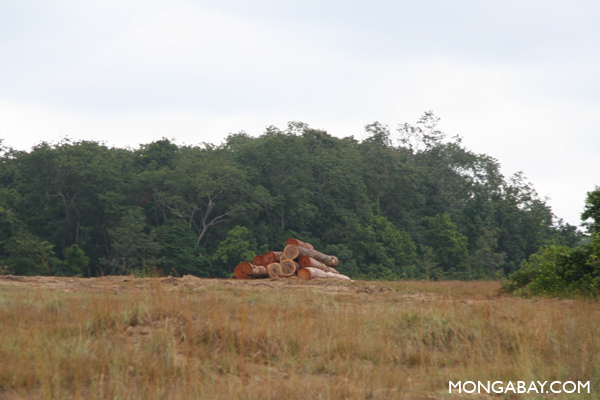 Logging in Gabon. Photos by Rhett A. Butler Selective logging is causing long-term changes to tropical forests in Africa by facilitating the growth of weeds and vines, which reduces plant diversity and diminishes carbon storage, reports a new paper published in the journal Ecological Research. The paper, led by Roberto Cazzolla Gatti of the University […]
Logging in Gabon. Photos by Rhett A. Butler Selective logging is causing long-term changes to tropical forests in Africa by facilitating the growth of weeds and vines, which reduces plant diversity and diminishes carbon storage, reports a new paper published in the journal Ecological Research. The paper, led by Roberto Cazzolla Gatti of the University […]
Scientists call on Obama to stop logging in old growth forests
 Clear-cut logging in Alaska. Photos by Rhett A. Butler. Seven conservation societies have joined a campaign to push the Obama administration to end old-growth forest logging in Alaska’s Tongass National Forest. The American Fisheries Society, American Ornithologists Union, American Society of Mammalogists, Ecological Society of America, Pacific Seabird Group, Society for Conservation Biology, and The […]
Clear-cut logging in Alaska. Photos by Rhett A. Butler. Seven conservation societies have joined a campaign to push the Obama administration to end old-growth forest logging in Alaska’s Tongass National Forest. The American Fisheries Society, American Ornithologists Union, American Society of Mammalogists, Ecological Society of America, Pacific Seabird Group, Society for Conservation Biology, and The […]
Boosting the conservation value of 4M sq km of rainforest logging concessions
 Short of buying back logging concessions, switching from conventional logging approaches to reduced impact logging techniques across existing forestry concessions may be the best way boost biodiversity in areas earmarked for timber extraction, argues paper. Logging in Borneo. Photos by Rhett A Butler. Logging is one of the most important drivers of deforestation. However unlike […]
Short of buying back logging concessions, switching from conventional logging approaches to reduced impact logging techniques across existing forestry concessions may be the best way boost biodiversity in areas earmarked for timber extraction, argues paper. Logging in Borneo. Photos by Rhett A Butler. Logging is one of the most important drivers of deforestation. However unlike […]
Termites suffer in logged forests and palm oil plantations
 Ants appear more resilient to forest degradation than termites Scientists have long studied how birds, mammals, and amphibians respond to forest degradation, but what about the most abundant animals in the forest? Insects. A new study in Biodiversity and Conservation looks at how ants and termites reacted to forest changes in Malaysian Borneo. “It was […]
Ants appear more resilient to forest degradation than termites Scientists have long studied how birds, mammals, and amphibians respond to forest degradation, but what about the most abundant animals in the forest? Insects. A new study in Biodiversity and Conservation looks at how ants and termites reacted to forest changes in Malaysian Borneo. “It was […]
FSC meeting weighs old-growth forest protection, smallholder participation
 Industrial logging operation in Malaysian Borneo in 2012. Photos by Rhett A. Butler. The Forest Stewardship Council (FSC), a body that sets social and environmental certification criteria for forestry products, is weighing measures that could step up protection for old-growth forests and make it easier for indigenous people and traditional forest communities to qualify for […]
Industrial logging operation in Malaysian Borneo in 2012. Photos by Rhett A. Butler. The Forest Stewardship Council (FSC), a body that sets social and environmental certification criteria for forestry products, is weighing measures that could step up protection for old-growth forests and make it easier for indigenous people and traditional forest communities to qualify for […]
Canada, Russia, Brazil lead world in old-growth forest loss
 World lost nearly 10 percent of its untouched forests in just over 10 years, according to new analysis Every day, the world loses about 50,000 hectares of forest to agricultural clearing, road development, and other human activities, constricting true wilderness into smaller and smaller areas – along with the species that inhabit them. New analysis […]
World lost nearly 10 percent of its untouched forests in just over 10 years, according to new analysis Every day, the world loses about 50,000 hectares of forest to agricultural clearing, road development, and other human activities, constricting true wilderness into smaller and smaller areas – along with the species that inhabit them. New analysis […]
A path to becoming a conservation scientist
 An interview with Zuzana Burivalova, a part of our on-going Interviews with Young Scientists series. The path to finding a career often involves twists and turns. Serendipity is important — one rarely anticipates what small events, chance occurrences, and seeds of inspiration will spur decisions that lead to pursuing one job or another. For Zuzana […]
An interview with Zuzana Burivalova, a part of our on-going Interviews with Young Scientists series. The path to finding a career often involves twists and turns. Serendipity is important — one rarely anticipates what small events, chance occurrences, and seeds of inspiration will spur decisions that lead to pursuing one job or another. For Zuzana […]
How do we save the world’s vanishing old-growth forests?
 Scientists say both rich and developing countries must recognize primary forests as a conservation priority. Primary rainforest in Imbak Canyon in the state of Sabah, Malaysian Borneo. The forest is home to pygmy elephants, clouded leopard, orangutans, banteng, and proboscis monkeys among thousands of other species. Photo by: Rhett A. Butler. There’s nothing in the […]
Scientists say both rich and developing countries must recognize primary forests as a conservation priority. Primary rainforest in Imbak Canyon in the state of Sabah, Malaysian Borneo. The forest is home to pygmy elephants, clouded leopard, orangutans, banteng, and proboscis monkeys among thousands of other species. Photo by: Rhett A. Butler. There’s nothing in the […]
Selective logging hurts rainforest frogs
 Bob Inger’s Bush Frog (Raorchestes bobingeri), a species found in the study site. Photo by K.S. Seshadri Selective logging in India’s Western Ghats forests continues to affect frogs decades after harvesting ended, finds a new study published in Biotropica. The research, conducted by K. S. Seshadri of Pondicherry University and the Ashoka Trust for Research […]
Bob Inger’s Bush Frog (Raorchestes bobingeri), a species found in the study site. Photo by K.S. Seshadri Selective logging in India’s Western Ghats forests continues to affect frogs decades after harvesting ended, finds a new study published in Biotropica. The research, conducted by K. S. Seshadri of Pondicherry University and the Ashoka Trust for Research […]
Nothing else left to log: are eco-certified timber companies stripping Russia of its last old growth forests?
-WCS-Russia.600.jpg) Russian ‘intact forest landscape’ loses 100,000 hectares in 12 years due in part to FSC-certified timber companies Russia’s trees fuel our increasing demand for wood-based products. The country’s vast forests, which cover over 800 million hectares or almost half its land area, are a major source of wood for global timber, paper and pulp industries. […]
Russian ‘intact forest landscape’ loses 100,000 hectares in 12 years due in part to FSC-certified timber companies Russia’s trees fuel our increasing demand for wood-based products. The country’s vast forests, which cover over 800 million hectares or almost half its land area, are a major source of wood for global timber, paper and pulp industries. […]
Ecologists are underestimating the impacts of rainforest logging
- Ecologists may be underestimating the impact of logging in old-growth tropical forests by failing to account for subtleties in how different animal groups respond to the intensity of timber extraction, argues a paper published today in the journal Current Biology.
- The study, led by Zuzana Burivalova of ETH Zurich, is based on a meta-analysis of 48 studies that evaluated the impact of selective logging on mammals, birds, amphibians, and invertebrates in tropical forests.
- “Sustainable forestry” may be far from sustainable for biodiversity at current intensities in some forests.
Stuff of fairy tales: stepping into Europe’s last old-growth forest
 On bison, wolves, and woodpeckers: the wonder of Europe’s only lowland virgin forest. Bialowieza Forest at dawn. Old-growth forest is characterized by ancient trees, tall canopies, little undergrowth, and a huge amount of dead wood. Photo by: Lukasz Mazurek/Wild Poland There is almost nothing left of Europe’s famed forests, those that provided for human communities […]
On bison, wolves, and woodpeckers: the wonder of Europe’s only lowland virgin forest. Bialowieza Forest at dawn. Old-growth forest is characterized by ancient trees, tall canopies, little undergrowth, and a huge amount of dead wood. Photo by: Lukasz Mazurek/Wild Poland There is almost nothing left of Europe’s famed forests, those that provided for human communities […]
A fine line: new program predicts when human impact becomes too much
 Modeling program could be used to better manage areas held by indigenous communities Indigenous groups control approximately half of the world’s vegetated areas. As globalization changes the ways in which traditional communities interact with the land on which they live, it is important to be able to predict how the surrounding environment will respond. Scientists […]
Modeling program could be used to better manage areas held by indigenous communities Indigenous groups control approximately half of the world’s vegetated areas. As globalization changes the ways in which traditional communities interact with the land on which they live, it is important to be able to predict how the surrounding environment will respond. Scientists […]
Despite moratorium, Indonesia now has world’s highest deforestation rate
 Indonesia now has the highest deforestation rate in the world, topping even Brazil which has more than five times the natural forest cover. Background photo: rainforest in Sumatra. Despite a high-level pledge to combat deforestation and a nationwide moratorium on new logging and plantation concessions, deforestation has continued to rise in Indonesia, according to a […]
Indonesia now has the highest deforestation rate in the world, topping even Brazil which has more than five times the natural forest cover. Background photo: rainforest in Sumatra. Despite a high-level pledge to combat deforestation and a nationwide moratorium on new logging and plantation concessions, deforestation has continued to rise in Indonesia, according to a […]
Protecting rainforests could sequester equivalent of a third of global emissions annually
 Global carbon emissions from human activities. Eliminating deforestation, peatlands and forest degradation, and forest fires in the tropics could reduce global carbon emissions by two billion tons a year, or nearly a fifth, argues a new study published in Global Change Biology. The research, authored by John Grace and Edward Mitchard of the University of […]
Global carbon emissions from human activities. Eliminating deforestation, peatlands and forest degradation, and forest fires in the tropics could reduce global carbon emissions by two billion tons a year, or nearly a fifth, argues a new study published in Global Change Biology. The research, authored by John Grace and Edward Mitchard of the University of […]
Logging, fires take a hidden toll on Amazon rainforest
 Selective logging in Brazil. Photo by Luke Parry. Selective logging and small sub-canopy fires are degrading vast areas of rainforest across the Brazilian Amazon, contributing to largely hidden carbon emissions, argues a study published today in Global Change Biology. The research, published by ten researchers from 11 institutions, is based on field data from some […]
Selective logging in Brazil. Photo by Luke Parry. Selective logging and small sub-canopy fires are degrading vast areas of rainforest across the Brazilian Amazon, contributing to largely hidden carbon emissions, argues a study published today in Global Change Biology. The research, published by ten researchers from 11 institutions, is based on field data from some […]
Borneo bests Amazon in terms of giant tree growth rates
 Trees in the rainforests of Borneo have faster growth rates than those in the Amazon, finds a study published in the Journal of Ecology. The research compared wood production among various trees in forests on the Asian island and in South America. It found that dipterocarps are the champions when it comes to woody growth. […]
Trees in the rainforests of Borneo have faster growth rates than those in the Amazon, finds a study published in the Journal of Ecology. The research compared wood production among various trees in forests on the Asian island and in South America. It found that dipterocarps are the champions when it comes to woody growth. […]
Reduced impact logging failing to cut emissions in Indonesia
 Advocates for reduced impact logging in tropical forests often make a case that better forest management cuts carbon emissions relative to traditional forms of timber harvesting. While the argument for altering logging approaches to limit forest damage makes intuitive sense, a new study suggests that the carbon benefits may not bear out in practice. Bronson […]
Advocates for reduced impact logging in tropical forests often make a case that better forest management cuts carbon emissions relative to traditional forms of timber harvesting. While the argument for altering logging approaches to limit forest damage makes intuitive sense, a new study suggests that the carbon benefits may not bear out in practice. Bronson […]
Next big idea in forest conservation? Incentivizing keeping primary forests intact
 Innovation in Tropical Forest Conservation: Q&A with Corey Bradshaw Primary peat forest in Sumatra. Photo by Rhett A. Butler. Much of Dr. Corey Bradshaw’s work has a singular aim: to keep primary habitats and functioning ecosystems intact. According to Bradshaw, the existing system of carbon trading rules needs to be changed so that primary forests […]
Innovation in Tropical Forest Conservation: Q&A with Corey Bradshaw Primary peat forest in Sumatra. Photo by Rhett A. Butler. Much of Dr. Corey Bradshaw’s work has a singular aim: to keep primary habitats and functioning ecosystems intact. According to Bradshaw, the existing system of carbon trading rules needs to be changed so that primary forests […]
How hunters have become key to saving Bulgaria’s capercaillie
 A version of this article appeared in National Geographic Bulgaria. Surprising clatter cuts through the silence in the snowy forest shortly before sunrise. The powerful clicking sounds like a dropping Ping-Pong ball before culminating in a loud pop resembling the opening of a champagne bottle. This sound is heard clearly and far. Propped on a […]
A version of this article appeared in National Geographic Bulgaria. Surprising clatter cuts through the silence in the snowy forest shortly before sunrise. The powerful clicking sounds like a dropping Ping-Pong ball before culminating in a loud pop resembling the opening of a champagne bottle. This sound is heard clearly and far. Propped on a […]
The next best thing: how well do secondary forests preserve biodiversity?
 Secondary forests, which are areas that were previously cleared of old-growth cover, now comprise the majority of the forested areas in the United States, Europe, and elsewhere. A heavily debated issue is to what extent secondary forests are able to contribute to the preservation of biodiversity. In an article published in PLOS ONE, a group […]
Secondary forests, which are areas that were previously cleared of old-growth cover, now comprise the majority of the forested areas in the United States, Europe, and elsewhere. A heavily debated issue is to what extent secondary forests are able to contribute to the preservation of biodiversity. In an article published in PLOS ONE, a group […]
Tree growth accelerates with age
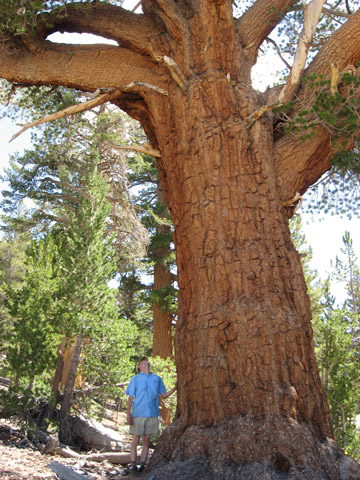 Old, large trees may be even more important ecologically than long-believed, according to a new study in Nature. Looking at over half a million individual trees from over 400 species (both tropical and temperate), scientists have determined that most trees actually grow faster in their dotage than in their youth. “In human terms, it is […]
Old, large trees may be even more important ecologically than long-believed, according to a new study in Nature. Looking at over half a million individual trees from over 400 species (both tropical and temperate), scientists have determined that most trees actually grow faster in their dotage than in their youth. “In human terms, it is […]
Zero net deforestation is the wrong target, warn experts
 Environmental initiatives that target zero net deforestation may miss their mark when it comes to slowing climate change and protecting biodiversity, warns a commentary published in this week’s issue of the journal Science. While zero net deforestation may seem like a worthy target in efforts to curb forest loss, Sandra Brown and Daniel Zarin argue […]
Environmental initiatives that target zero net deforestation may miss their mark when it comes to slowing climate change and protecting biodiversity, warns a commentary published in this week’s issue of the journal Science. While zero net deforestation may seem like a worthy target in efforts to curb forest loss, Sandra Brown and Daniel Zarin argue […]
3.5 million ha of Indonesian and Malaysian forest converted for palm oil in 20 years
 Palm plantations expanding at 7% per year across Malaysia and Indonesia Some 3.5 million hectares (8.7 million acres) of forest in Indonesia, Malaysia, and Papua New Guinea was converted for oil palm plantations between 1990 and 2010, finds a comprehensive set of assessments released by the Roundtable on Sustainable Palm Oil (RSPO). The research, conducted […]
Palm plantations expanding at 7% per year across Malaysia and Indonesia Some 3.5 million hectares (8.7 million acres) of forest in Indonesia, Malaysia, and Papua New Guinea was converted for oil palm plantations between 1990 and 2010, finds a comprehensive set of assessments released by the Roundtable on Sustainable Palm Oil (RSPO). The research, conducted […]
World’s biggest owl depends on large old trees
 The Blakiston fish owl (Bubo Blakistoni) is the world’s largest – and one of the rarest – owl species, with an impressive 6 foot (2 meter) wingspan. The giant owl, found exclusively in northeast Asia, shares its habitat with a menagerie of endangered and impressive animals, including Amur tigers, Amur leopards, Asiatic black bears and […]
The Blakiston fish owl (Bubo Blakistoni) is the world’s largest – and one of the rarest – owl species, with an impressive 6 foot (2 meter) wingspan. The giant owl, found exclusively in northeast Asia, shares its habitat with a menagerie of endangered and impressive animals, including Amur tigers, Amur leopards, Asiatic black bears and […]
Old-growth trees store half rainforest carbon
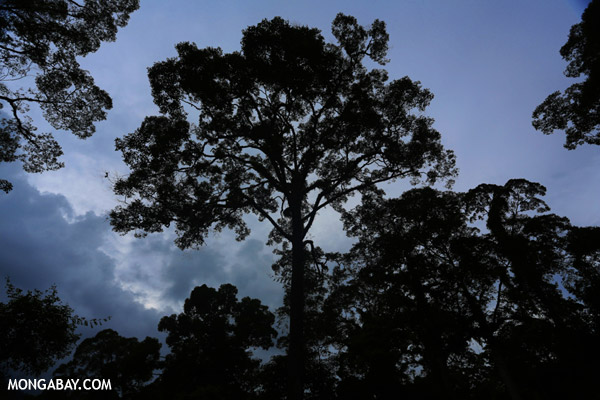 Large trees store store up to half the above-ground biomass in tropical forests, reiterating their importance in buffering against climate change, finds a study published in Global Ecology and Biogeography. The research, which involved dozens of scientists from more than 40 institutions, is based on data from nearly 200,000 individual trees across 120 lowland rainforest […]
Large trees store store up to half the above-ground biomass in tropical forests, reiterating their importance in buffering against climate change, finds a study published in Global Ecology and Biogeography. The research, which involved dozens of scientists from more than 40 institutions, is based on data from nearly 200,000 individual trees across 120 lowland rainforest […]
Deforestation ban working in Costa Rica
 Conversion of primary rainforests for industrial agriculture in Costa Rica slows despite population increase and growing exports. Costa Rica’s ban on clearing of “mature” forests appears to be effective in encouraging agricultural expansion on non-forest lands, finds a study published today in the journal Environmental Research Letters. The research, which was led by Matthew Fagan […]
Conversion of primary rainforests for industrial agriculture in Costa Rica slows despite population increase and growing exports. Costa Rica’s ban on clearing of “mature” forests appears to be effective in encouraging agricultural expansion on non-forest lands, finds a study published today in the journal Environmental Research Letters. The research, which was led by Matthew Fagan […]
Decades-long fight leads to old-growth forest protection in Tasmania
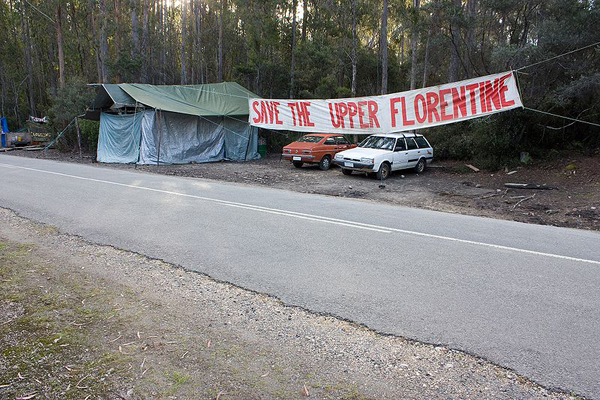 Almost 200,000 hectares of Tasmania’s old growth forest have been world heritage listed, bringing hope that a three-decade fight between environmentalists, politicians and loggers is over. The World Heritage Committee has extended the heritage listed boundary of the Tasmanian Wilderness World Heritage Area by more than 170,000 hectares after accepting a proposal from the Australian […]
Almost 200,000 hectares of Tasmania’s old growth forest have been world heritage listed, bringing hope that a three-decade fight between environmentalists, politicians and loggers is over. The World Heritage Committee has extended the heritage listed boundary of the Tasmanian Wilderness World Heritage Area by more than 170,000 hectares after accepting a proposal from the Australian […]
Southern U.S. logging soars to meet foreign biofuel demand
 In order to meet the European Union’s goal of 20% renewables by 2020, some European utility companies are moving away from coal and replacing it with wood pellet fuel. The idea is simple: trees will regrow and recapture the carbon released in the burning of wood pellets, making the process supposedly carbon-neutral. But just like […]
In order to meet the European Union’s goal of 20% renewables by 2020, some European utility companies are moving away from coal and replacing it with wood pellet fuel. The idea is simple: trees will regrow and recapture the carbon released in the burning of wood pellets, making the process supposedly carbon-neutral. But just like […]
Rodents have lowest diversity in primary forests in the Congo
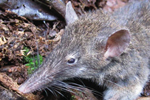 For many animal families, diversity and abundance rises as one moves away from human-impacted landscapes, like agricultural areas, into untouched places, such as primary rainforests. However, a new study in mongabay.com’s open access journal Tropical Conservation Science, shows that the inverse can also be true. In this case, scientists working in the Democratic Republic of […]
For many animal families, diversity and abundance rises as one moves away from human-impacted landscapes, like agricultural areas, into untouched places, such as primary rainforests. However, a new study in mongabay.com’s open access journal Tropical Conservation Science, shows that the inverse can also be true. In this case, scientists working in the Democratic Republic of […]
Cambodia’s largest lowland rainforest spared from new land concessions
 Activists dress as avatars to protest the destruction of Prey Lang forest. Photo courtesy of Prey Lang: It’s Our Forest Too. Four economic land concessions have been cancelled in Cambodia’s Prey Lang forest, known as the largest intact lowland forest in Southeast Asia, reports the Phnom Penh Post. The economic land concessions, totaling over 40,000 […]
Activists dress as avatars to protest the destruction of Prey Lang forest. Photo courtesy of Prey Lang: It’s Our Forest Too. Four economic land concessions have been cancelled in Cambodia’s Prey Lang forest, known as the largest intact lowland forest in Southeast Asia, reports the Phnom Penh Post. The economic land concessions, totaling over 40,000 […]
Saving ‘Avatar Grove’: the battle to preserve old-growth forests in British Columbia
- A picture is worth a thousand words: this common adage comes instantly to mind when viewing T.J. Watt’s unforgettable photos of lost trees.
- For years, Watt has been photographing the beauty of Vancouver Island’s ancient temperate rainforests, and documenting their loss to clearcut logging.
- The photographer and environmental activist recently helped co-found the Ancient Forest Alliance (AFA), a group devoted to saving the island’s and British Columbia’s (BC) last old-growth while working with the logging industry to adopt sustainable practices.
- This February the organization succeeded in saving Avatar Grove—which was only discovered in 2009—from being clearcut.
Experts: sustainable logging in rainforests impossible
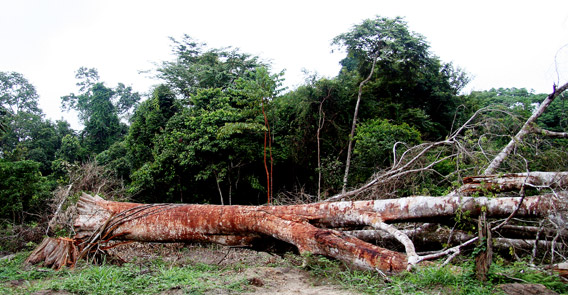 Logging in Gabon, Central Africa. Photo by Rhett A. Butler. Industrial logging in primary tropical forests that is both sustainable and profitable is impossible, argues a new study in Bioscience, which finds that the ecology of tropical hardwoods makes logging with truly sustainable practices not only impractical, but completely unprofitable. Given this, the researchers recommend […]
Logging in Gabon, Central Africa. Photo by Rhett A. Butler. Industrial logging in primary tropical forests that is both sustainable and profitable is impossible, argues a new study in Bioscience, which finds that the ecology of tropical hardwoods makes logging with truly sustainable practices not only impractical, but completely unprofitable. Given this, the researchers recommend […]
Industrial logging leaves a poor legacy in Borneo’s rainforests
 This is an expanded version of an article, titled A Desperate Effort to Save the Rainforest of Borneo, that appeared last month on Yale e360. Rainforest in Sabah. All photo by Rhett A. Butler. For most people “Borneo” conjures up an image of a wild and distant land of rainforests, exotic beasts, and nomadic tribes. […]
This is an expanded version of an article, titled A Desperate Effort to Save the Rainforest of Borneo, that appeared last month on Yale e360. Rainforest in Sabah. All photo by Rhett A. Butler. For most people “Borneo” conjures up an image of a wild and distant land of rainforests, exotic beasts, and nomadic tribes. […]
IKEA logging old-growth forest for low-price furniture in Russia
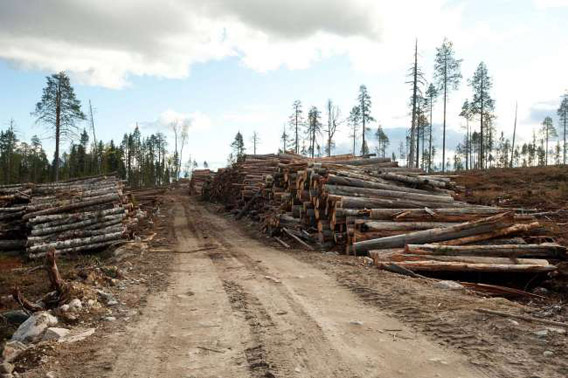 Destroyed old-growth forest with piles of timber on land leased by IKEA/Swedwood in Russian Karelia. Photo © Robert Svensson, Protect the Forest 2011. A new campaign is targeting IKEA, the world’s biggest furniture retailer, for logging old-growth forests in the Karelia region of Russia. An alliance of groups, headed by the Swedish NGO Protect the […]
Destroyed old-growth forest with piles of timber on land leased by IKEA/Swedwood in Russian Karelia. Photo © Robert Svensson, Protect the Forest 2011. A new campaign is targeting IKEA, the world’s biggest furniture retailer, for logging old-growth forests in the Karelia region of Russia. An alliance of groups, headed by the Swedish NGO Protect the […]
Alaskan fishermen tell government to focus on salmon, not logging
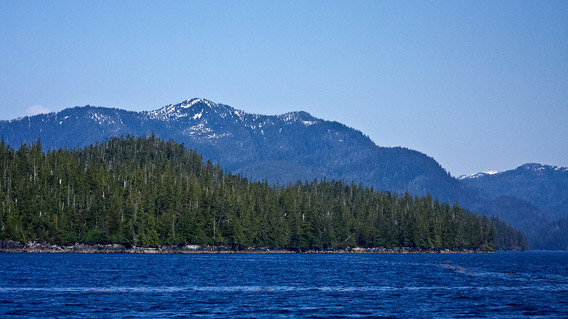 Tongass temperate rainforest. Photo of Southeast Alaska, courtesy of BigStock. Alaskan fishermen and tour operators visited Washington D.C. last week to urge the federal government to shift the focus from logging to conservation in the Tongass rainforest. Local Alaskans along with NGOs Trout Unlimited, Alaska Program, and Sitka Conservation Society, made the case that conservation, […]
Tongass temperate rainforest. Photo of Southeast Alaska, courtesy of BigStock. Alaskan fishermen and tour operators visited Washington D.C. last week to urge the federal government to shift the focus from logging to conservation in the Tongass rainforest. Local Alaskans along with NGOs Trout Unlimited, Alaska Program, and Sitka Conservation Society, made the case that conservation, […]
U.S. legislation threatens oldest, tallest trees in Tongass rainforest
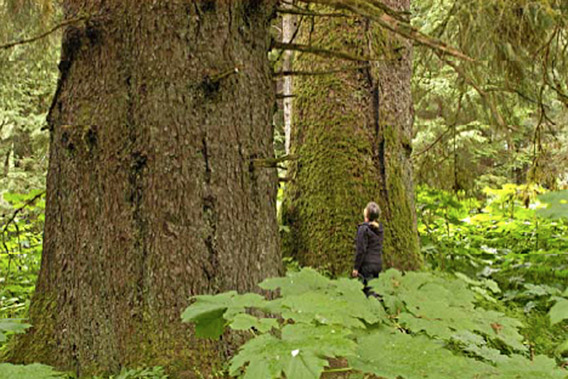 Old-growth tree in Tongass temperate rainforest. Such trees may be as old as 800 years. Photo by: John Schoen. Up to 17 percent of the tallest old-growth trees in the Tongass temperate rainforest could be cut under new U.S. legislation, according to a report by Audubon Alaska. The report argues that the legislation under consideration […]
Old-growth tree in Tongass temperate rainforest. Such trees may be as old as 800 years. Photo by: John Schoen. Up to 17 percent of the tallest old-growth trees in the Tongass temperate rainforest could be cut under new U.S. legislation, according to a report by Audubon Alaska. The report argues that the legislation under consideration […]
NASA satellite image shows extent of logging in Pacific Northwest
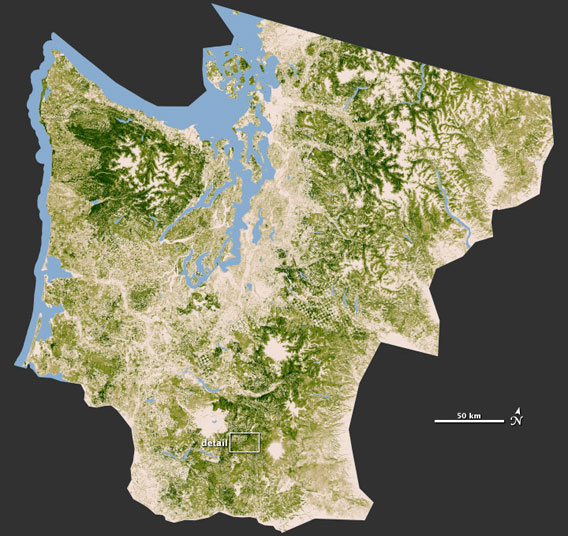 Over 13 percent of old growth forests in Pacific Northwest lost to logging in just over a decade, the vast majority on non-federal lands. NASA map shows forest cover in Washington and parts of Oregon. The greener an area the more carbon the forest stores. Photo by: NASA. New satellite and space radar images by […]
Over 13 percent of old growth forests in Pacific Northwest lost to logging in just over a decade, the vast majority on non-federal lands. NASA map shows forest cover in Washington and parts of Oregon. The greener an area the more carbon the forest stores. Photo by: NASA. New satellite and space radar images by […]
Green groups: government moving too slowly on protecting Canada’s Great Bear rainforest
 Three environmental groups have submitted a letter to British Columbia Premier, Christy Clark, to ask the government to speed up the process of implementing the Great Bear Rainforest Agreement, which is meant to ensure 70 percent of old-growth forest is maintained. “For the communities of the Great Bear Rainforest, a healthy economy depends on a […]
Three environmental groups have submitted a letter to British Columbia Premier, Christy Clark, to ask the government to speed up the process of implementing the Great Bear Rainforest Agreement, which is meant to ensure 70 percent of old-growth forest is maintained. “For the communities of the Great Bear Rainforest, a healthy economy depends on a […]
Big trees, like the old-growth forests they inhabit, are declining globally
 Already on the decline, demise of giant trees may be hastened by global warming. Already on the decline worldwide, big trees face a dire future due to habitat fragmentation, selective harvesting by loggers, exotic invaders, and the effects of climate change, warns an article published this week in New Scientist magazine. Reviewing research from forests […]
Already on the decline, demise of giant trees may be hastened by global warming. Already on the decline worldwide, big trees face a dire future due to habitat fragmentation, selective harvesting by loggers, exotic invaders, and the effects of climate change, warns an article published this week in New Scientist magazine. Reviewing research from forests […]
Logging of primary rainforests not ecologically sustainable, argue scientists
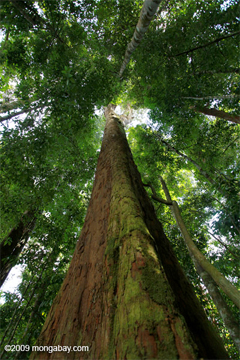 Tropical countries may face a risk of ‘peak timber’ as continued logging of rainforests exceeds the capacity of forests to regenerate timber stocks and substantially increases the risk of outright clearing for agricultural and industrial plantations, argues a trio of scientists writing in the journal Biological Conservation. The implications for climate, biodiversity, and local economies […]
Tropical countries may face a risk of ‘peak timber’ as continued logging of rainforests exceeds the capacity of forests to regenerate timber stocks and substantially increases the risk of outright clearing for agricultural and industrial plantations, argues a trio of scientists writing in the journal Biological Conservation. The implications for climate, biodiversity, and local economies […]
Photos: 46 new species found in little-explored Amazonian nation
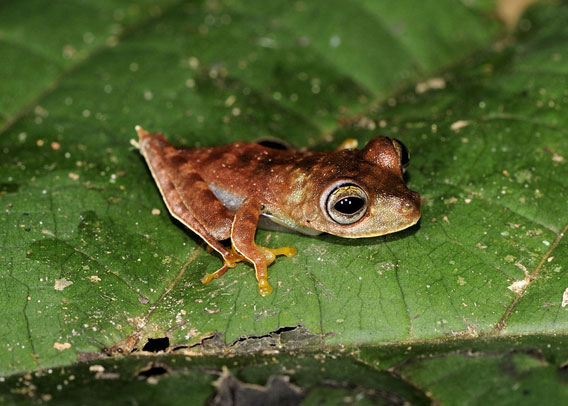 A possible new species of frog: Hypsiboas sp. (nickname “cowboy frog”) has white fringes along the legs and a spur on the heel. The frog was discovered low on a small branch during a night survey in a swampy area west of the RAP base camp at the Koetari River during Conservation International’s Rapid Assessment […]
A possible new species of frog: Hypsiboas sp. (nickname “cowboy frog”) has white fringes along the legs and a spur on the heel. The frog was discovered low on a small branch during a night survey in a swampy area west of the RAP base camp at the Koetari River during Conservation International’s Rapid Assessment […]
Locals key to saving primate-rich wetlands in Cote D’Ivoire
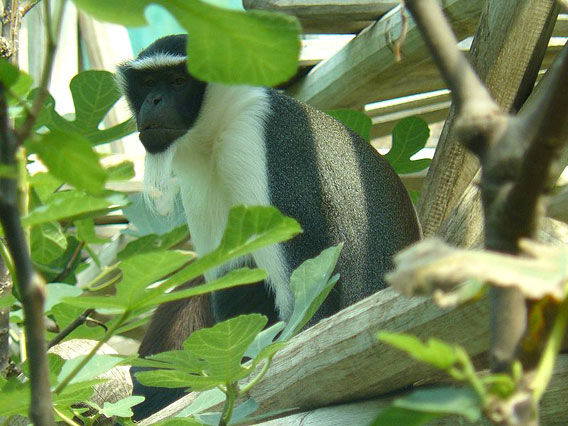 One of the world’s top 25 most endangered primates: the roloway monkey (Cercopithecus diana roloway) photographed in the Munich Zoo. Saved from being converted into a vast palm oil plantation by PALM-CI in 2009, the Ehy Tanoé wetlands and forest in the Cote D’Ivoire (Ivory Coast) is home to three gravely endangered primates and as […]
One of the world’s top 25 most endangered primates: the roloway monkey (Cercopithecus diana roloway) photographed in the Munich Zoo. Saved from being converted into a vast palm oil plantation by PALM-CI in 2009, the Ehy Tanoé wetlands and forest in the Cote D’Ivoire (Ivory Coast) is home to three gravely endangered primates and as […]
Madagascar tree diversity among the highest worldwide
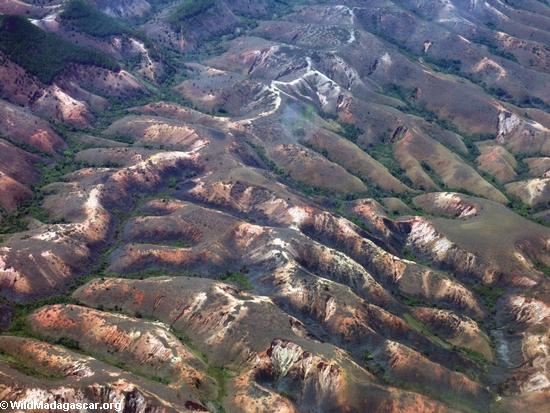 Bare hills: aerial view of deforestation and soil erosion in Madagascar. Photo by: Rhett A. Butler. In terms of biodiversity, the hugely imperiled forests of Madagascar may be among the world’s richest. Researchers estimate that the island off the coast of Africa is home to at least 10,000 tree and shrub species with over 90 […]
Bare hills: aerial view of deforestation and soil erosion in Madagascar. Photo by: Rhett A. Butler. In terms of biodiversity, the hugely imperiled forests of Madagascar may be among the world’s richest. Researchers estimate that the island off the coast of Africa is home to at least 10,000 tree and shrub species with over 90 […]
Featured video: world’s only video of extinct 2-foot-long imperial woodpecker
Newly-discovered video has brought the extinct imperial woodpecker (Campephilus imperialis) back to life—at least for a few seconds. Once the world’s largest woodpecker (even bigger than the ivory-billed woodpecker, which may also be extinction), the imperial woodpecker vanished after it’s native old-growth pine forest habitat in Mexico was logged. It also suffered widespread hunting for […]
Old trees necessary for nesting animals
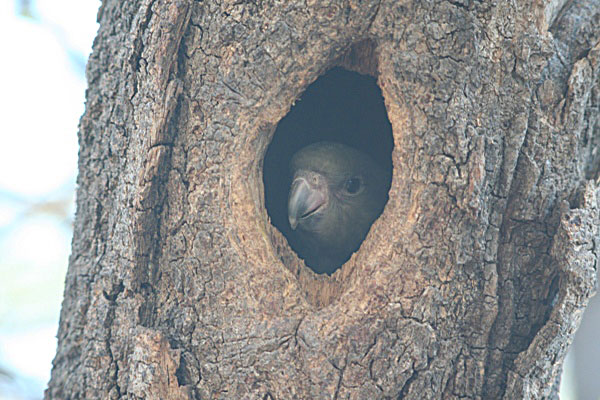 Brown-headed parrot (Poicephalus cryptoxanthus) fledgling in tree cavity in Botswana. Photo by: Tiffany Roufs. Aged, living trees are essential for over 1,000 birds and mammals that depend on such trees for nesting holes, according to a study in Frontiers in Ecology and the Environment. In much of the world, tree-nesting animals depend on holes formed […]
Brown-headed parrot (Poicephalus cryptoxanthus) fledgling in tree cavity in Botswana. Photo by: Tiffany Roufs. Aged, living trees are essential for over 1,000 birds and mammals that depend on such trees for nesting holes, according to a study in Frontiers in Ecology and the Environment. In much of the world, tree-nesting animals depend on holes formed […]
Primary forest best for birds in Papua New Guinea
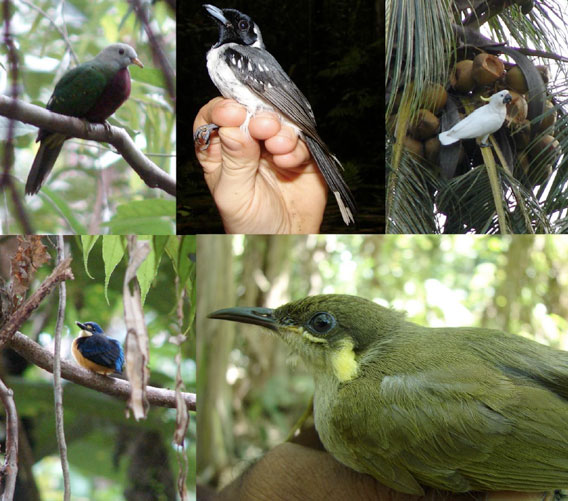 A new survey recorded 125 birds in Papua New Guinea’s Waria Valley, of which an astounding 43 percent were endemic to the island. The survey, published in mongabay.com’s open-access journal Tropical Conservation Science, was the first of its kind for the rainforest-studded valley and found that bird populations were most diverse and abundant in primary […]
A new survey recorded 125 birds in Papua New Guinea’s Waria Valley, of which an astounding 43 percent were endemic to the island. The survey, published in mongabay.com’s open-access journal Tropical Conservation Science, was the first of its kind for the rainforest-studded valley and found that bird populations were most diverse and abundant in primary […]
Old-growth forests are irreplaceable for sustaining biodiversity
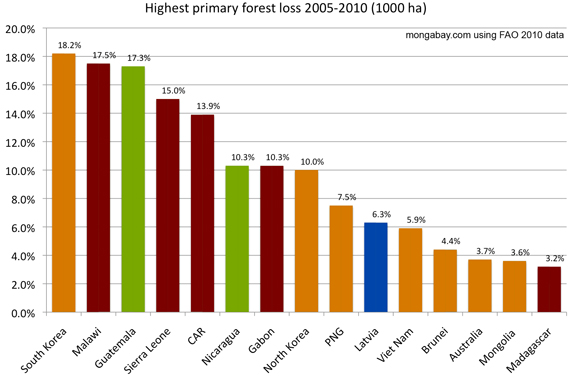 Primary rainforests are top conservation priority Old growth rainforests should be a top conservation priority when it comes to protecting wildlife, reports a new comprehensive assessment published in the journal Nature. The research, which was led by Luke Gibson of the National University of Singapore and Tien Ming Lee of the University of California at […]
Primary rainforests are top conservation priority Old growth rainforests should be a top conservation priority when it comes to protecting wildlife, reports a new comprehensive assessment published in the journal Nature. The research, which was led by Luke Gibson of the National University of Singapore and Tien Ming Lee of the University of California at […]
Photos: Cambodians rally as ‘Avatars’ to save one of the region’s last great rainforests
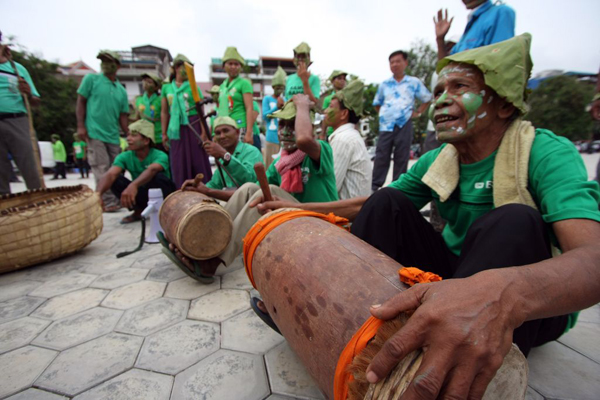 Cambodian villagers dressed as ‘avatars’ to protest the destruction of their forest. Photo courtesy of: Prey Lang Network. Two hundred Cambodians rallied in Phnom Penh last week to protest the widespread destruction of one of Southeast Asia’s last intact lowland rainforests, known as Prey Lang. In an effort to gain wider media attention, protestors donned […]
Cambodian villagers dressed as ‘avatars’ to protest the destruction of their forest. Photo courtesy of: Prey Lang Network. Two hundred Cambodians rallied in Phnom Penh last week to protest the widespread destruction of one of Southeast Asia’s last intact lowland rainforests, known as Prey Lang. In an effort to gain wider media attention, protestors donned […]
Locals clash with ‘sustainable’ FSC logging company in the Congo
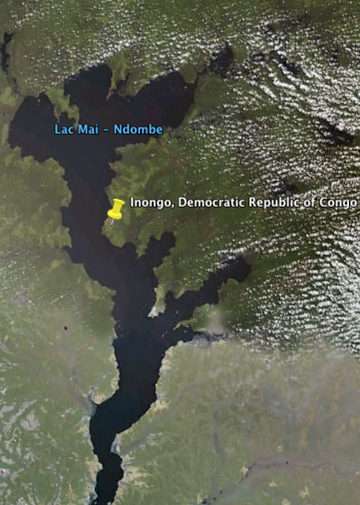 Two separate protests against logging companies by local communities have turned violent in the Democratic Republic of Congo (DRC), leaving at least one dead. According to Greenpeace, one of the companies involved in the violence, Sodefor, is sustainably certified by the Forest Stewardship Council (FSC). Given that the industry in DRC is rife with social […]
Two separate protests against logging companies by local communities have turned violent in the Democratic Republic of Congo (DRC), leaving at least one dead. According to Greenpeace, one of the companies involved in the violence, Sodefor, is sustainably certified by the Forest Stewardship Council (FSC). Given that the industry in DRC is rife with social […]
Indonesia’s forest protection plan at risk, says report
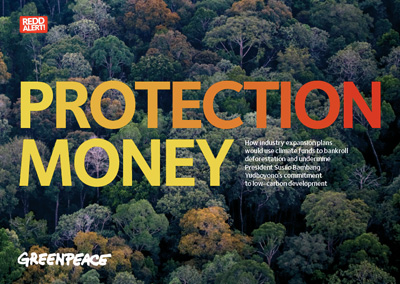 Industrial interests are threatening to undermine Norway’s billion dollar partnership with Indonesia, potentially turning the forest conservation deal into a scheme that subsidizes conversion of rainforests and peatlands for oil palm and pulp and paper plantations, logging concessions, and energy production, claims a new report from Greenpeace. The report, Protection Money [PDF], argues that the […]
Industrial interests are threatening to undermine Norway’s billion dollar partnership with Indonesia, potentially turning the forest conservation deal into a scheme that subsidizes conversion of rainforests and peatlands for oil palm and pulp and paper plantations, logging concessions, and energy production, claims a new report from Greenpeace. The report, Protection Money [PDF], argues that the […]
Good stewards of forests at home outsource deforestation abroad
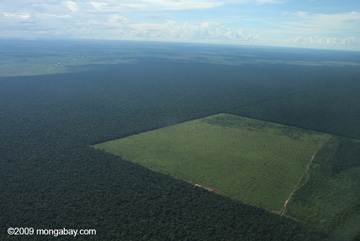 As more nations adopt better laws and policies to save and restore forests at home, they may, in fact, be outsourcing deforestation to other parts of the world, according to a new study in the Proceedings of the National Academy of Sciences (PNAS). Looking at six developing nations where forests are recovering—instead of receding—the study […]
As more nations adopt better laws and policies to save and restore forests at home, they may, in fact, be outsourcing deforestation to other parts of the world, according to a new study in the Proceedings of the National Academy of Sciences (PNAS). Looking at six developing nations where forests are recovering—instead of receding—the study […]
Scientists call upon Indonesia to recognize value of secondary forests
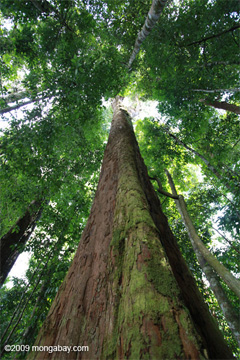 A group of scientists have called upon the governments of Indonesia and Norway to recognize the conservation value of logged-over and “degraded” forests under their partnership on reducing emissions from deforestation and degradation. The letter urges the Indonesian government to extend protection to forest areas that may not be pristine but still serve as important […]
A group of scientists have called upon the governments of Indonesia and Norway to recognize the conservation value of logged-over and “degraded” forests under their partnership on reducing emissions from deforestation and degradation. The letter urges the Indonesian government to extend protection to forest areas that may not be pristine but still serve as important […]
Reforestation effort launched in Borneo with nearly-extinct rhinos in mind
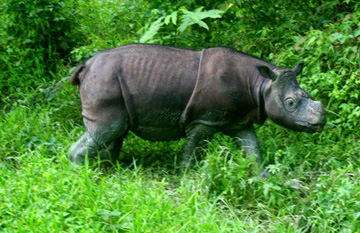 The Rhino and Forest Fund (RFF) has partnered with the Forestry Department of Sabah in northern Borneo to launch a long-term reforestation project to aid Malaysia’s threatened species with particular emphasis on the Bornean rhino (Dicerorhinus sumatrensis harrissoni), one of the world’s most imperiled big mammals. The reforestation project will be occurring in and adjacent […]
The Rhino and Forest Fund (RFF) has partnered with the Forestry Department of Sabah in northern Borneo to launch a long-term reforestation project to aid Malaysia’s threatened species with particular emphasis on the Bornean rhino (Dicerorhinus sumatrensis harrissoni), one of the world’s most imperiled big mammals. The reforestation project will be occurring in and adjacent […]
RSPO to recognize secondary forests as conservation priority
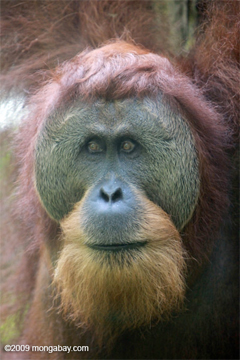 The Roundtable on Sustainable Palm Oil (RSPO), a body that sets environmental standards for palm oil production, has passed a resolution to reconfirm that secondary and degraded forests can classified as High Conservation Value (HCV) areas. The designation could increase the area of forest conserved within oil palm plantations provided it has high conservation significance, […]
The Roundtable on Sustainable Palm Oil (RSPO), a body that sets environmental standards for palm oil production, has passed a resolution to reconfirm that secondary and degraded forests can classified as High Conservation Value (HCV) areas. The designation could increase the area of forest conserved within oil palm plantations provided it has high conservation significance, […]
Corporations, conservation, and the green movement
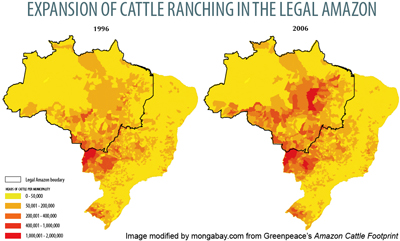 The rise of industrial deforestation and its implications for conservation. The image of rainforests being torn down by giant bulldozers, felled by chainsaw-wielding loggers, and torched by large-scale developers has never been more poignant. Corporations have today replaced small-scale farmers as the prime drivers of deforestation, a shift that has critical implications for conservation. Until […]
The rise of industrial deforestation and its implications for conservation. The image of rainforests being torn down by giant bulldozers, felled by chainsaw-wielding loggers, and torched by large-scale developers has never been more poignant. Corporations have today replaced small-scale farmers as the prime drivers of deforestation, a shift that has critical implications for conservation. Until […]
Loss of old growth forest continues
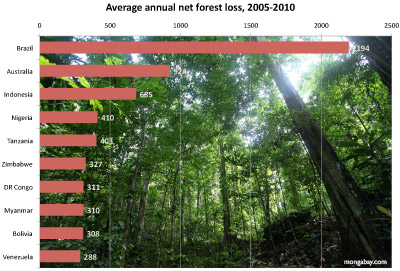 More coverage: Rainforest loss slows A new global assessment of forest stocks by the U.N. Food and Agriculture Organization (FAO) shows continuing loss of primary forests since 2005 despite gains in the extent of protected areas. FAO’s Global Forest Resources Assessment 2010 reveals some 13 million hectares of forest were cleared between 2000 and 2010, […]
More coverage: Rainforest loss slows A new global assessment of forest stocks by the U.N. Food and Agriculture Organization (FAO) shows continuing loss of primary forests since 2005 despite gains in the extent of protected areas. FAO’s Global Forest Resources Assessment 2010 reveals some 13 million hectares of forest were cleared between 2000 and 2010, […]
The effect of forest regeneration strategies on beetles
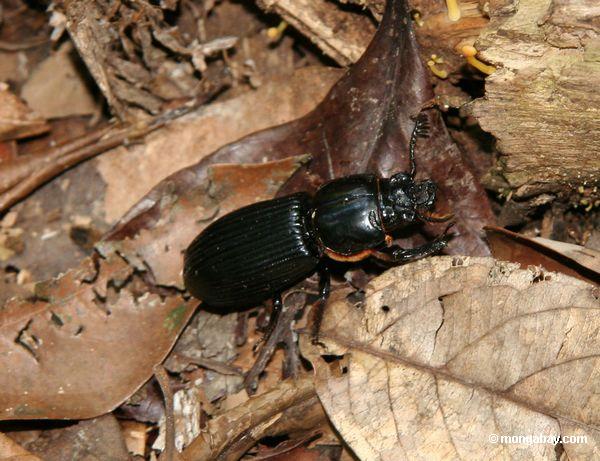 As conservationists attempt to find the best way to re-establish forests in abandoned areas, a new study in the open-access journal Tropical Conservation Science compares the impacts on bess beetles of different method to regeneration forest. Bess beetles are important dead wood-recyclers in the forest. Looking at three different forests in the Colombian Andes—natural regeneration, […]
As conservationists attempt to find the best way to re-establish forests in abandoned areas, a new study in the open-access journal Tropical Conservation Science compares the impacts on bess beetles of different method to regeneration forest. Bess beetles are important dead wood-recyclers in the forest. Looking at three different forests in the Colombian Andes—natural regeneration, […]
Indonesia’s forest conservation plan may not sufficiently reduce emissions
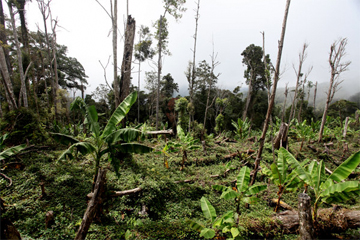 One third of Indonesia’s greenhouse gas emissions from deforestation originate from areas not officially defined as “forest” suggesting that efforts to reduce emissions from deforestation and degradation (REDD+) may fail unless they account for carbon across the country’s entire landscape, warns a new report published by the World Agroforestry Centre (CGIAR). The policy brief finds […]
One third of Indonesia’s greenhouse gas emissions from deforestation originate from areas not officially defined as “forest” suggesting that efforts to reduce emissions from deforestation and degradation (REDD+) may fail unless they account for carbon across the country’s entire landscape, warns a new report published by the World Agroforestry Centre (CGIAR). The policy brief finds […]
Audit finds palm oil company destroyed peatlands, but not primary forest
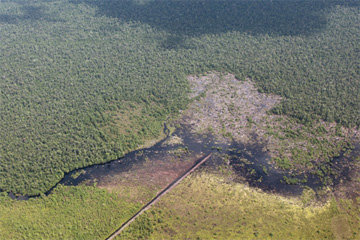 An environmental audit of palm oil company, PT SMART, found that the company had not cut primary rainforest, yet had destroyed carbon-rich peatlands; however the audit analyzed only 40 percent of PT SMART’s holdings and investigated none of its plantations in New Guinea. A subsidiary of agricultural giant Sinar Mas, PT SMART has been accused […]
An environmental audit of palm oil company, PT SMART, found that the company had not cut primary rainforest, yet had destroyed carbon-rich peatlands; however the audit analyzed only 40 percent of PT SMART’s holdings and investigated none of its plantations in New Guinea. A subsidiary of agricultural giant Sinar Mas, PT SMART has been accused […]
Rainforest destruction progresses in waves
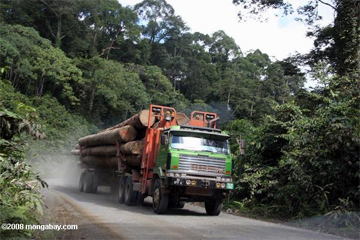 Tropical forest degradation progresses in a series of “waves”, with forests initially exploited for high value products like hardwoods and then eventually used for successively lower value goods like firewood and fodder, reports new research published in the Proceedings of the National Academy of Sciences. The study, which tested economic theory predicting “a systematic allocation […]
Tropical forest degradation progresses in a series of “waves”, with forests initially exploited for high value products like hardwoods and then eventually used for successively lower value goods like firewood and fodder, reports new research published in the Proceedings of the National Academy of Sciences. The study, which tested economic theory predicting “a systematic allocation […]
Reforestation of rainforests sequesters more carbon than plantations
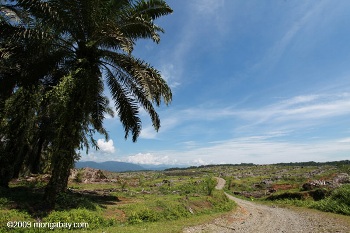 A new study in Ecological Management & Restoration has found that reforesting rainforest captures more carbon than monoculture plantation and even mixed species plantations. The research tested three projects in north-eastern Australia: a rainforest reforesting project using a variety of native trees, a mixed species plantation, and a monoculture plantation of conifers. “Compared to the […]
A new study in Ecological Management & Restoration has found that reforesting rainforest captures more carbon than monoculture plantation and even mixed species plantations. The research tested three projects in north-eastern Australia: a rainforest reforesting project using a variety of native trees, a mixed species plantation, and a monoculture plantation of conifers. “Compared to the […]
Illegal logging declining worldwide, but still ‘major problem’
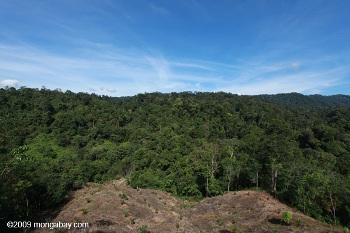 Global production of illegal timber down by 22 percent from 2002. A new report by the Chatham House finds that illegal logging in tropical forest nation is primarily on the decline, providing evidence that new laws and international efforts on the issue are having a positive impact. According to the report, the total global production […]
Global production of illegal timber down by 22 percent from 2002. A new report by the Chatham House finds that illegal logging in tropical forest nation is primarily on the decline, providing evidence that new laws and international efforts on the issue are having a positive impact. According to the report, the total global production […]
Rainforest scientists urge UN to correct “serious loophole” by changing its definition of ‘forest’
 The Association for Tropical Biology and Conservation (ATBC) has released a resolution urging the UN to change its definition for ‘forest’, before the controversial definition undermines conservation efforts, biodiversity preservation, carbon sequestration, and the nascent REDD (Reducing Emissions through Deforestation and forest Degradation). Currently, the UN definition of ‘forest’ doesn’t designate between a natural forest […]
The Association for Tropical Biology and Conservation (ATBC) has released a resolution urging the UN to change its definition for ‘forest’, before the controversial definition undermines conservation efforts, biodiversity preservation, carbon sequestration, and the nascent REDD (Reducing Emissions through Deforestation and forest Degradation). Currently, the UN definition of ‘forest’ doesn’t designate between a natural forest […]
A total ban on primary forest logging needed to save the world, an interview with activist Glen Barry
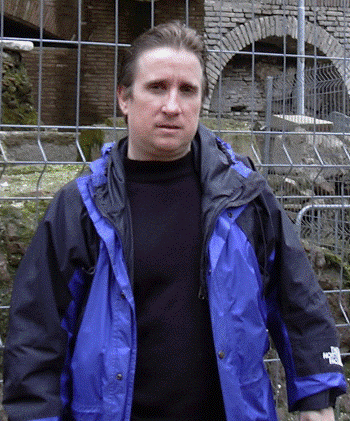 Radical, controversial, ahead-of-his-time, brilliant, or extremist: call Dr. Glen Barry, the head of Ecological Internet, what you will, but there is no question that his environmental advocacy group has achieved major successes in the past years, even if many of these are below the radar of big conservation groups and mainstream media. “We tend to […]
Radical, controversial, ahead-of-his-time, brilliant, or extremist: call Dr. Glen Barry, the head of Ecological Internet, what you will, but there is no question that his environmental advocacy group has achieved major successes in the past years, even if many of these are below the radar of big conservation groups and mainstream media. “We tend to […]
Timber certification is not enough to save rainforests
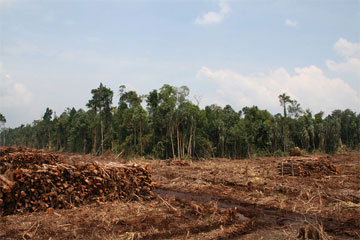 Activists from the Rainforest Action Network voice support for the Forest Stewardship Council (FSC) certification scheme but say stronger policy measures are needed to control deforestation. In the 1980s and 1990s pressure from activist groups led some of the world’s largest forestry products companies and retailers to join forces with environmentalists to form the Forest […]
Activists from the Rainforest Action Network voice support for the Forest Stewardship Council (FSC) certification scheme but say stronger policy measures are needed to control deforestation. In the 1980s and 1990s pressure from activist groups led some of the world’s largest forestry products companies and retailers to join forces with environmentalists to form the Forest […]
New protected areas in Brazil contribute to major drop in Amazon deforestation rate
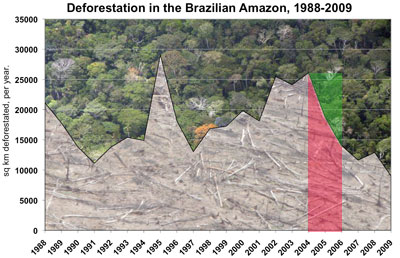 Protected areas in the Brazilian Amazon are proving highly effective in reducing forest loss in Earth’s largest rainforest, reports a new study based on analysis of deforestation trends in and around indigenous territories, parks, military holdings, and sustainable use reserves. The research, published in the early edition of Proceedings of the National Academy of Sciences, […]
Protected areas in the Brazilian Amazon are proving highly effective in reducing forest loss in Earth’s largest rainforest, reports a new study based on analysis of deforestation trends in and around indigenous territories, parks, military holdings, and sustainable use reserves. The research, published in the early edition of Proceedings of the National Academy of Sciences, […]
Taking back the rainforest: Indians in Colombia govern 100,000 square miles of territory
 An interview with Martin von Hildebrand, founder at head of Gaia Amazonas. Indigenous groups in the Colombian Amazon have long suffered deprivations at the hands of outsiders. First came the diseases brought by the European Conquest, then came abuses under colonial rule. In modern times, some Amazonian communities were virtually enslaved by the debt-bondage system […]
An interview with Martin von Hildebrand, founder at head of Gaia Amazonas. Indigenous groups in the Colombian Amazon have long suffered deprivations at the hands of outsiders. First came the diseases brought by the European Conquest, then came abuses under colonial rule. In modern times, some Amazonian communities were virtually enslaved by the debt-bondage system […]
Paper company loses green certification after rainforest destruction in Indonesia
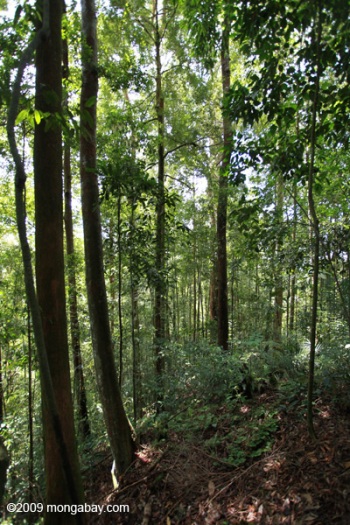 The Forest Stewardship Council (FSC), a global certifier of sustainably managed forest, has dropped another Indonesian company for the destruction of rainforests. Asia Paper Resources International Limited (APRIL), has had its certification suspended due to evidence of conversion of rainforests for acacia plantations, the destruction of ‘High Conservation Value Forest’, draining peatlands, as well as […]
The Forest Stewardship Council (FSC), a global certifier of sustainably managed forest, has dropped another Indonesian company for the destruction of rainforests. Asia Paper Resources International Limited (APRIL), has had its certification suspended due to evidence of conversion of rainforests for acacia plantations, the destruction of ‘High Conservation Value Forest’, draining peatlands, as well as […]
Global deforestation slows
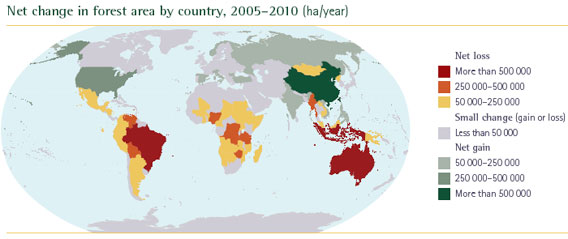 Global forest loss has diminished since the 1990s but still remains “alarmingly high”, according to a preliminary version of a new assessment from the U.N. Food and Agriculture Organization (FAO). The report, Global Forest Resources Assessment 2010 (FRA 2010), shows that global forest loss slowed to around 13 million hectares per year during the 2000s, […]
Global forest loss has diminished since the 1990s but still remains “alarmingly high”, according to a preliminary version of a new assessment from the U.N. Food and Agriculture Organization (FAO). The report, Global Forest Resources Assessment 2010 (FRA 2010), shows that global forest loss slowed to around 13 million hectares per year during the 2000s, […]
Oil palm plantations support fewer ant species than rainforest
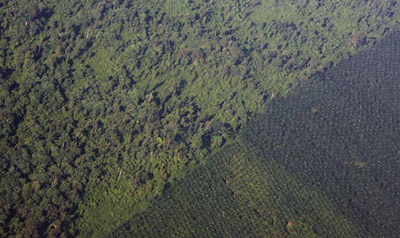 Oil palm plantations support substantially less biodiversity than natural forests when it comes to ant species, reports new research published in Basic and Applied Ecology. Tom Fayle, a Cambridge University biologist, and colleagues sampled ant populations in a rainforest in Danum Valley Conservation Area and nearby oil palm plantations in Sabah, a state in Malaysian […]
Oil palm plantations support substantially less biodiversity than natural forests when it comes to ant species, reports new research published in Basic and Applied Ecology. Tom Fayle, a Cambridge University biologist, and colleagues sampled ant populations in a rainforest in Danum Valley Conservation Area and nearby oil palm plantations in Sabah, a state in Malaysian […]
Rich logging countries open logging loophole in plan to reduce deforestation
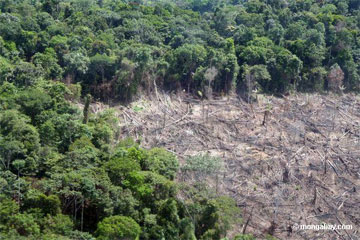 While one tropical forest policy group saw hopeful signs emerging in the most recent revision of the negotiating text on the reducing emissions from deforestation and degradation (REDD) mechanism at climate talks in Copenhagen, activist groups are warning that there remains a substantial logging loophole for developed countries. “The latest proposal from Annex 1 parties […]
While one tropical forest policy group saw hopeful signs emerging in the most recent revision of the negotiating text on the reducing emissions from deforestation and degradation (REDD) mechanism at climate talks in Copenhagen, activist groups are warning that there remains a substantial logging loophole for developed countries. “The latest proposal from Annex 1 parties […]
Destruction of old-growth forests looms over climate talks
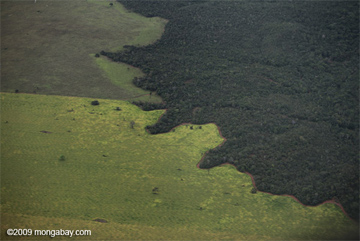 Destruction of old-growth or primary forests looms large in discussions in Copenhagen over a scheme to compensate tropical countries for reducing emissions from deforestation and degradation (REDD). Some environmental groups are pressing for conservation of old-growth forests — the most carbon-dense, and biologically-rich state of forests — to be the centerpiece of REDD, while industry […]
Destruction of old-growth or primary forests looms large in discussions in Copenhagen over a scheme to compensate tropical countries for reducing emissions from deforestation and degradation (REDD). Some environmental groups are pressing for conservation of old-growth forests — the most carbon-dense, and biologically-rich state of forests — to be the centerpiece of REDD, while industry […]
In absence of measures to address consumption, REDD may fail to protect forests
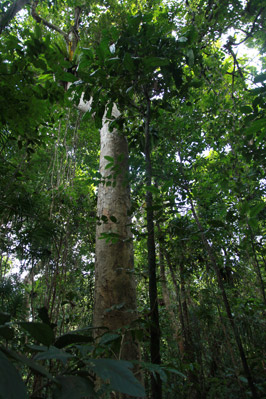 Rising demand for timber and agricultural products could work against a proposed initiative to reduce emissions from deforestation and degradation (REDD), warns a new report from the Environmental Investigation Agency (EIA). The briefing, Putting the Brakes on Drivers of Forest Destruction: A Shared Responsibility, says that investment in REDD will not be enough to protect […]
Rising demand for timber and agricultural products could work against a proposed initiative to reduce emissions from deforestation and degradation (REDD), warns a new report from the Environmental Investigation Agency (EIA). The briefing, Putting the Brakes on Drivers of Forest Destruction: A Shared Responsibility, says that investment in REDD will not be enough to protect […]
REDD may increase the cost of conservation of non-forest ecosystems
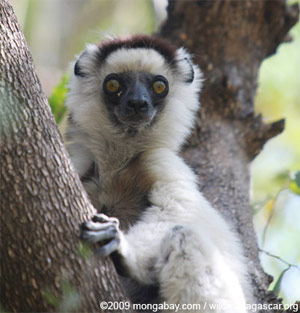 Policy-makers designing a climate change mitigation mechanism that will reduce emissions from deforestation and degradation (REDD) aren’t doing enough to ensure that the scheme protects biodiversity outside carbon-dense ecosystems, argues an editorial published in Current Biology by a prominent group of scientists. The fear is that REDD, which would pay countries for protecting forest carbon […]
Policy-makers designing a climate change mitigation mechanism that will reduce emissions from deforestation and degradation (REDD) aren’t doing enough to ensure that the scheme protects biodiversity outside carbon-dense ecosystems, argues an editorial published in Current Biology by a prominent group of scientists. The fear is that REDD, which would pay countries for protecting forest carbon […]
Important safeguards to protect rainforests lacking in REDD negotiating text
 Important safeguards to protect natural forests are still lacking in negotiating text on REDD, a proposed mechanism for mitigating climate change by paying developing countries to keep trees standing, reports an alliance of activist groups. The Ecosystems Climate Alliance (ECA) — a group made up of Global Witness, the Rainforest Action Network, The Wilderness Society, […]
Important safeguards to protect natural forests are still lacking in negotiating text on REDD, a proposed mechanism for mitigating climate change by paying developing countries to keep trees standing, reports an alliance of activist groups. The Ecosystems Climate Alliance (ECA) — a group made up of Global Witness, the Rainforest Action Network, The Wilderness Society, […]
Without reinstatement of key provision, REDD could subsidize large-scale forest destruction
 The elimination of a key provision from the negotiating text for the Reducing Emissions from Deforestation and Degradation in developing countries (REDD) mechanism could turn the proposed climate change mitigation scheme into a subsidy for large-scale conversion of natural forests to industrial plantations, warned environmentalists today at the resumption of U.N. climate change negotiations in […]
The elimination of a key provision from the negotiating text for the Reducing Emissions from Deforestation and Degradation in developing countries (REDD) mechanism could turn the proposed climate change mitigation scheme into a subsidy for large-scale conversion of natural forests to industrial plantations, warned environmentalists today at the resumption of U.N. climate change negotiations in […]
Logged forests support biodiversity after 15 years of rehabilitation, but not if turned into plantations
 With the world facing global warming and a biodiversity crisis, a new study in Conservation Biology shows that within 15 years logged forests—considered by many to be ‘degraded’—can be managed in order to successfully fight both climate change and extinction. Studying regenerating forests in northeast Borneo, Dr. David Edwards from the University of Leeds, surveyed […]
With the world facing global warming and a biodiversity crisis, a new study in Conservation Biology shows that within 15 years logged forests—considered by many to be ‘degraded’—can be managed in order to successfully fight both climate change and extinction. Studying regenerating forests in northeast Borneo, Dr. David Edwards from the University of Leeds, surveyed […]
Roads are enablers of rainforest destruction
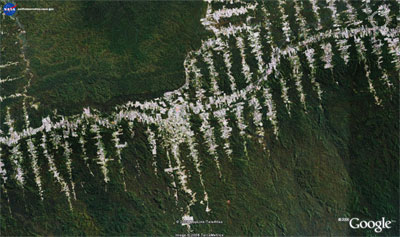 Chainsaws, bulldozers, and fires are tools of rainforest destruction, but roads are enablers. Roads link markets to resources, enabling loggers, farmers, ranchers, miners, and land speculators to convert remote forests into economic opportunities. But the ecological cost is high: 95 percent of deforestation in the Brazilian Amazon occurs within 50-kilometers of a road, while in […]
Chainsaws, bulldozers, and fires are tools of rainforest destruction, but roads are enablers. Roads link markets to resources, enabling loggers, farmers, ranchers, miners, and land speculators to convert remote forests into economic opportunities. But the ecological cost is high: 95 percent of deforestation in the Brazilian Amazon occurs within 50-kilometers of a road, while in […]
Weak forest definition may undermine REDD efforts
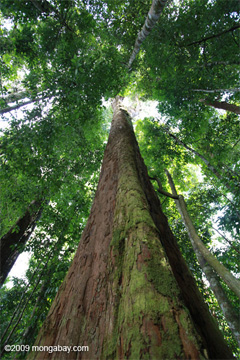 The weak definition of what constitutes forest under the United Nations Framework Convention on Climate Change (UNFCCC) puts the effectiveness of a proposed mechanism for reducing emissions from deforestation and degradation (REDD) at risk, argue researchers writing in the journal Conservation Letters. Lending academic weight to concerns that environmentalists have long voiced, Nophea Sasaki and […]
The weak definition of what constitutes forest under the United Nations Framework Convention on Climate Change (UNFCCC) puts the effectiveness of a proposed mechanism for reducing emissions from deforestation and degradation (REDD) at risk, argue researchers writing in the journal Conservation Letters. Lending academic weight to concerns that environmentalists have long voiced, Nophea Sasaki and […]
Amazon stores 10 billion tons of carbon in ‘dead wood’
Old growth forests in the Amazon store nearly 10 billion tons of carbon in dead trees and branches, a total greater than global annual emissions from fossil fuel combustion, according to scientists who have conducted the first pan-Amazon analysis of “necromass.” The findings, published in Biogeosciences, provide a better picture of carbon dioxide emissions that […]
Emissions from Amazon deforestation to rise as loggers move deeper into the rainforest
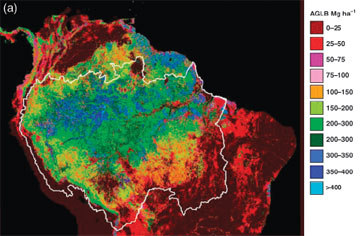 Emissions from Amazon deforestation are growing as developers move deeper into old-growth forest areas where carbon density is higher, report scientists writing in Geophysical Research Letters. Analyzing deforestation data from 2001 through 2007, a team of researchers from the Carnegie Institution’s Department of Global Ecology at Stanford University found the aboveground biomass lost per unit […]
Emissions from Amazon deforestation are growing as developers move deeper into old-growth forest areas where carbon density is higher, report scientists writing in Geophysical Research Letters. Analyzing deforestation data from 2001 through 2007, a team of researchers from the Carnegie Institution’s Department of Global Ecology at Stanford University found the aboveground biomass lost per unit […]
Are we on the brink of saving rainforests?
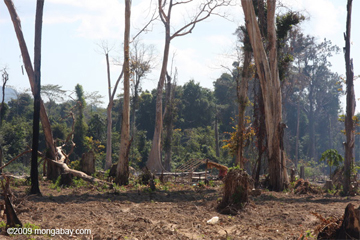 Until now saving rainforests seemed like an impossible mission. But the world is now warming to the idea that a proposed solution to help address climate change could offer a new way to unlock the value of forest without cutting it down. NOTE: See Bigg REDD for a condensed take on this concept. Deep in […]
Until now saving rainforests seemed like an impossible mission. But the world is now warming to the idea that a proposed solution to help address climate change could offer a new way to unlock the value of forest without cutting it down. NOTE: See Bigg REDD for a condensed take on this concept. Deep in […]
Temperate forests store more carbon than tropical forests, finds study
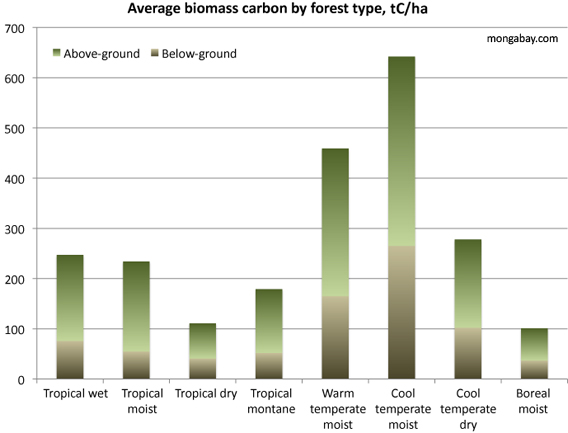 Temperate forests trump rainforests when it comes to storing carbon, reports a new assessment of global forest carbon stocks published July 14th in Proceedings of the National Academy of Sciences (PNAS). The findings have important implications for efforts to mitigate climate change by protecting forests. Sampling and reviewing published data from nearly 100 forest sites […]
Temperate forests trump rainforests when it comes to storing carbon, reports a new assessment of global forest carbon stocks published July 14th in Proceedings of the National Academy of Sciences (PNAS). The findings have important implications for efforts to mitigate climate change by protecting forests. Sampling and reviewing published data from nearly 100 forest sites […]
Climate pact must halt deforestation and industrial logging of old-growth forests, exclude carbon credits for forest conservation, say activists
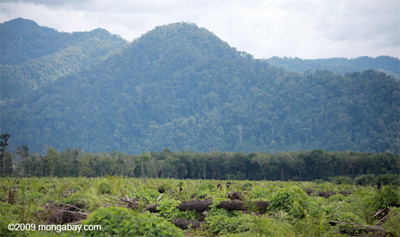 A global framework on climate change must immediately halt deforestation and industrial logging of the world’s old-growth forests, while protecting the rights of forest communities and indigenous groups, said a broad coalition of activist groups in a consensus statement issued today at U.N. climate talks in Bonn Germany. The statement said the successor treaty to […]
A global framework on climate change must immediately halt deforestation and industrial logging of the world’s old-growth forests, while protecting the rights of forest communities and indigenous groups, said a broad coalition of activist groups in a consensus statement issued today at U.N. climate talks in Bonn Germany. The statement said the successor treaty to […]
24% of Papua New Guinea’s rainforest destroyed or degraded by logging in 30 years
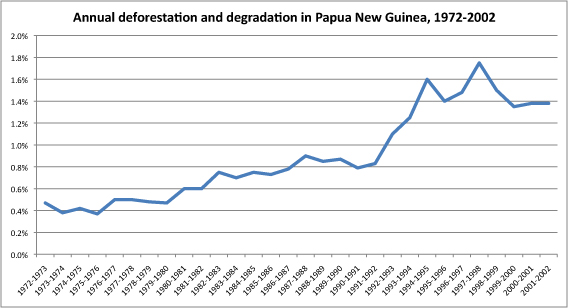 Nearly one quarter of Papua New Guinea’s rainforests were damaged or destroyed between 1972 and 2002, report researchers writing in the journal Biotopica. The results, which were published in a report last June, show that Papua New Guinea is losing forests at a much faster rate than previously believed. Over the 30-year study period 15 […]
Nearly one quarter of Papua New Guinea’s rainforests were damaged or destroyed between 1972 and 2002, report researchers writing in the journal Biotopica. The results, which were published in a report last June, show that Papua New Guinea is losing forests at a much faster rate than previously believed. Over the 30-year study period 15 […]
Rainforests absorb 20% of emissions annually
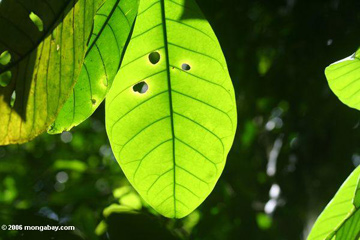
Secondary forest should become new conservation initiative
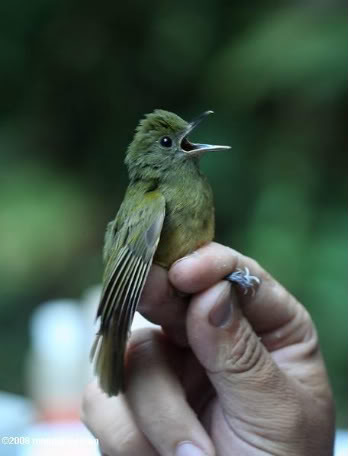 “I want to convince you we need to go beyond primary forests to preserve biodiversity”, Robin Chazdon told an audience at the National Natural History Museum during a symposium on the tropics. Chazdon, a professor of ecology and evolutionary biology at the University of Connecticut, has been studying secondary growth forests for over eighteen years. […]
“I want to convince you we need to go beyond primary forests to preserve biodiversity”, Robin Chazdon told an audience at the National Natural History Museum during a symposium on the tropics. Chazdon, a professor of ecology and evolutionary biology at the University of Connecticut, has been studying secondary growth forests for over eighteen years. […]
Symposium tackles big question: how many species will survive our generation
 An overview of the Smithsonian’s Symposium: “Will the rainforests survive? New Threats and Realities in the Tropical Extinction Crisis”
An overview of the Smithsonian’s Symposium: “Will the rainforests survive? New Threats and Realities in the Tropical Extinction Crisis”
What is the greatest threat to rainforests: habitat destruction or climate change?
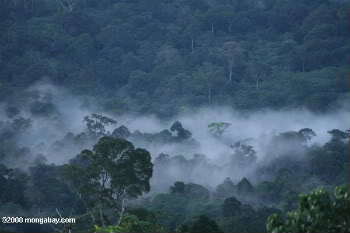 Renowned scientists discuss threats to rainforests at symposium
Renowned scientists discuss threats to rainforests at symposium
Selective logging occurs in 28 percent of world’s rainforests
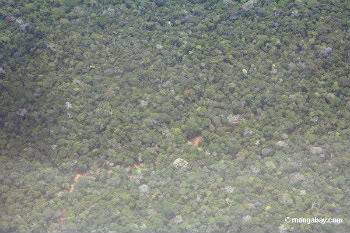 using satellite imagery. Satellites could detect clear-cutting of the rainforest with great accuracy, but detecting the subtle changes caused by selective logging, which Asner describes as “cryptic”, has only been achieved in recent years with more sophisticated satellite technology.. Asner noted that despite decades of attention from the conservation community, deforestation decade-by-decade has risen, not […]
using satellite imagery. Satellites could detect clear-cutting of the rainforest with great accuracy, but detecting the subtle changes caused by selective logging, which Asner describes as “cryptic”, has only been achieved in recent years with more sophisticated satellite technology.. Asner noted that despite decades of attention from the conservation community, deforestation decade-by-decade has risen, not […]
Rainforest conversion to oil palm causes 83% of wildlife to disappear
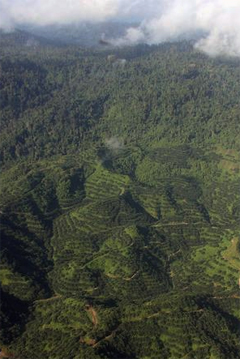 Rainforest conversion to oil palm causes 83% of wildlife to disappear Rainforest conversion to oil palm causes 83% of wildlife to disappear mongabay.com September 15, 2008 Conversion of primary rainforest to an oil palm plantation results in a loss of more than 80 percent of species, reports a new comprehensive review of the impacts of […]
Rainforest conversion to oil palm causes 83% of wildlife to disappear Rainforest conversion to oil palm causes 83% of wildlife to disappear mongabay.com September 15, 2008 Conversion of primary rainforest to an oil palm plantation results in a loss of more than 80 percent of species, reports a new comprehensive review of the impacts of […]
Old growth forests are giant carbon sinks, helping offset emissions
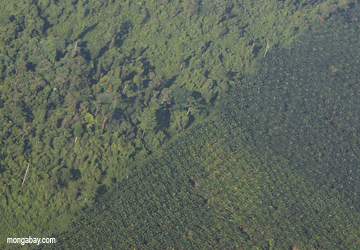 Old growth forests are carbon sinks for centuries, helping offset emissions Old growth forests are carbon sinks for centuries, helping offset emissions Rhett A. Butler, mongabay.com September 11, 2008 Old growth forests are important carbon sinks that help global warming, reports a study published in the journal Nature. The results run counter to claims by […]
Old growth forests are carbon sinks for centuries, helping offset emissions Old growth forests are carbon sinks for centuries, helping offset emissions Rhett A. Butler, mongabay.com September 11, 2008 Old growth forests are important carbon sinks that help global warming, reports a study published in the journal Nature. The results run counter to claims by […]
In the Amazon, primary forest biodiversity tops that of secondary forest, plantations
 In the Amazon, primary forest biodiversity tops that of secondary forest, plantations In the Amazon, primary forest biodiversity tops that of secondary forest, plantations Rhett A. Butler, mongabay.com November 12, 2007 Plantations and secondary forests are no match for primary Amazon rainforest in terms of biodiversity, reports the largest ever assessment of the biodiversity conservation […]
In the Amazon, primary forest biodiversity tops that of secondary forest, plantations In the Amazon, primary forest biodiversity tops that of secondary forest, plantations Rhett A. Butler, mongabay.com November 12, 2007 Plantations and secondary forests are no match for primary Amazon rainforest in terms of biodiversity, reports the largest ever assessment of the biodiversity conservation […]
Feeds: news | india | latam | brasil | indonesia
 This is the wrap-up article for our four-part series “The Congo Basin peatlands.” Read Part One, Part Two, Part Three and Part Four. In the first half of December, Mongabay published a four-part series on the peatlands of the Congo Basin. Only in 2017 did a team of Congolese and British scientists discover that a […]
This is the wrap-up article for our four-part series “The Congo Basin peatlands.” Read Part One, Part Two, Part Three and Part Four. In the first half of December, Mongabay published a four-part series on the peatlands of the Congo Basin. Only in 2017 did a team of Congolese and British scientists discover that a […] Two palm oil plantations have recently been established in Peru, supplanting primary forest. Satellite imagery analysis shows extent of the massive development, which is led by a group of companies tied to plantation entrepreneur and United Cacao CEO Dennis Melka. Photo courtesy of the Environmental Investigation Agency. More than 9,400 hectares of closed-canopy Amazonian rainforest […]
Two palm oil plantations have recently been established in Peru, supplanting primary forest. Satellite imagery analysis shows extent of the massive development, which is led by a group of companies tied to plantation entrepreneur and United Cacao CEO Dennis Melka. Photo courtesy of the Environmental Investigation Agency. More than 9,400 hectares of closed-canopy Amazonian rainforest […] Reaching 1,450 meters (4,750 feet) above the surrounding sea, Cleopatra’s Needle is one of Palawan’s tallest mountain peaks. Photo by Jonah van Beijnen. Palawan, an island-province of the Philippines near Borneo, is home to many species of plants and animals found nowhere else in the world. Considered the Philippines’ “last biodiversity frontier” by many researchers […]
Reaching 1,450 meters (4,750 feet) above the surrounding sea, Cleopatra’s Needle is one of Palawan’s tallest mountain peaks. Photo by Jonah van Beijnen. Palawan, an island-province of the Philippines near Borneo, is home to many species of plants and animals found nowhere else in the world. Considered the Philippines’ “last biodiversity frontier” by many researchers […] One of the world’s largest fabric makers for the fashion industry today announced a policy to exclude fiber produced at the expense of endangered forests, reports Canopy, an environmental group that helped broker the commitment. Aditya Birla, an Indian conglomerate with operations in 36 countries and 120,000 employees, accounts for about a fifth of global […]
One of the world’s largest fabric makers for the fashion industry today announced a policy to exclude fiber produced at the expense of endangered forests, reports Canopy, an environmental group that helped broker the commitment. Aditya Birla, an Indian conglomerate with operations in 36 countries and 120,000 employees, accounts for about a fifth of global […] World leaders are continuing to overlook the worsening condition of tropical forests despite the biome’s vast potential to help mitigate climate change, support local livelihoods and ecosystem services, and stabilize global agriculture, warns a comprehensive review published by a body founded by Prince Charles. Synthesizing a large body of reports and academic research, The Prince […]
World leaders are continuing to overlook the worsening condition of tropical forests despite the biome’s vast potential to help mitigate climate change, support local livelihoods and ecosystem services, and stabilize global agriculture, warns a comprehensive review published by a body founded by Prince Charles. Synthesizing a large body of reports and academic research, The Prince […] Logging in Gabon. Photos by Rhett A. Butler Selective logging is causing long-term changes to tropical forests in Africa by facilitating the growth of weeds and vines, which reduces plant diversity and diminishes carbon storage, reports a new paper published in the journal Ecological Research. The paper, led by Roberto Cazzolla Gatti of the University […]
Logging in Gabon. Photos by Rhett A. Butler Selective logging is causing long-term changes to tropical forests in Africa by facilitating the growth of weeds and vines, which reduces plant diversity and diminishes carbon storage, reports a new paper published in the journal Ecological Research. The paper, led by Roberto Cazzolla Gatti of the University […] Clear-cut logging in Alaska. Photos by Rhett A. Butler. Seven conservation societies have joined a campaign to push the Obama administration to end old-growth forest logging in Alaska’s Tongass National Forest. The American Fisheries Society, American Ornithologists Union, American Society of Mammalogists, Ecological Society of America, Pacific Seabird Group, Society for Conservation Biology, and The […]
Clear-cut logging in Alaska. Photos by Rhett A. Butler. Seven conservation societies have joined a campaign to push the Obama administration to end old-growth forest logging in Alaska’s Tongass National Forest. The American Fisheries Society, American Ornithologists Union, American Society of Mammalogists, Ecological Society of America, Pacific Seabird Group, Society for Conservation Biology, and The […] Short of buying back logging concessions, switching from conventional logging approaches to reduced impact logging techniques across existing forestry concessions may be the best way boost biodiversity in areas earmarked for timber extraction, argues paper. Logging in Borneo. Photos by Rhett A Butler. Logging is one of the most important drivers of deforestation. However unlike […]
Short of buying back logging concessions, switching from conventional logging approaches to reduced impact logging techniques across existing forestry concessions may be the best way boost biodiversity in areas earmarked for timber extraction, argues paper. Logging in Borneo. Photos by Rhett A Butler. Logging is one of the most important drivers of deforestation. However unlike […] Ants appear more resilient to forest degradation than termites Scientists have long studied how birds, mammals, and amphibians respond to forest degradation, but what about the most abundant animals in the forest? Insects. A new study in Biodiversity and Conservation looks at how ants and termites reacted to forest changes in Malaysian Borneo. “It was […]
Ants appear more resilient to forest degradation than termites Scientists have long studied how birds, mammals, and amphibians respond to forest degradation, but what about the most abundant animals in the forest? Insects. A new study in Biodiversity and Conservation looks at how ants and termites reacted to forest changes in Malaysian Borneo. “It was […] Industrial logging operation in Malaysian Borneo in 2012. Photos by Rhett A. Butler. The Forest Stewardship Council (FSC), a body that sets social and environmental certification criteria for forestry products, is weighing measures that could step up protection for old-growth forests and make it easier for indigenous people and traditional forest communities to qualify for […]
Industrial logging operation in Malaysian Borneo in 2012. Photos by Rhett A. Butler. The Forest Stewardship Council (FSC), a body that sets social and environmental certification criteria for forestry products, is weighing measures that could step up protection for old-growth forests and make it easier for indigenous people and traditional forest communities to qualify for […] World lost nearly 10 percent of its untouched forests in just over 10 years, according to new analysis Every day, the world loses about 50,000 hectares of forest to agricultural clearing, road development, and other human activities, constricting true wilderness into smaller and smaller areas – along with the species that inhabit them. New analysis […]
World lost nearly 10 percent of its untouched forests in just over 10 years, according to new analysis Every day, the world loses about 50,000 hectares of forest to agricultural clearing, road development, and other human activities, constricting true wilderness into smaller and smaller areas – along with the species that inhabit them. New analysis […] An interview with Zuzana Burivalova, a part of our on-going Interviews with Young Scientists series. The path to finding a career often involves twists and turns. Serendipity is important — one rarely anticipates what small events, chance occurrences, and seeds of inspiration will spur decisions that lead to pursuing one job or another. For Zuzana […]
An interview with Zuzana Burivalova, a part of our on-going Interviews with Young Scientists series. The path to finding a career often involves twists and turns. Serendipity is important — one rarely anticipates what small events, chance occurrences, and seeds of inspiration will spur decisions that lead to pursuing one job or another. For Zuzana […] Scientists say both rich and developing countries must recognize primary forests as a conservation priority. Primary rainforest in Imbak Canyon in the state of Sabah, Malaysian Borneo. The forest is home to pygmy elephants, clouded leopard, orangutans, banteng, and proboscis monkeys among thousands of other species. Photo by: Rhett A. Butler. There’s nothing in the […]
Scientists say both rich and developing countries must recognize primary forests as a conservation priority. Primary rainforest in Imbak Canyon in the state of Sabah, Malaysian Borneo. The forest is home to pygmy elephants, clouded leopard, orangutans, banteng, and proboscis monkeys among thousands of other species. Photo by: Rhett A. Butler. There’s nothing in the […] Bob Inger’s Bush Frog (Raorchestes bobingeri), a species found in the study site. Photo by K.S. Seshadri Selective logging in India’s Western Ghats forests continues to affect frogs decades after harvesting ended, finds a new study published in Biotropica. The research, conducted by K. S. Seshadri of Pondicherry University and the Ashoka Trust for Research […]
Bob Inger’s Bush Frog (Raorchestes bobingeri), a species found in the study site. Photo by K.S. Seshadri Selective logging in India’s Western Ghats forests continues to affect frogs decades after harvesting ended, finds a new study published in Biotropica. The research, conducted by K. S. Seshadri of Pondicherry University and the Ashoka Trust for Research […]-WCS-Russia.600.jpg) Russian ‘intact forest landscape’ loses 100,000 hectares in 12 years due in part to FSC-certified timber companies Russia’s trees fuel our increasing demand for wood-based products. The country’s vast forests, which cover over 800 million hectares or almost half its land area, are a major source of wood for global timber, paper and pulp industries. […]
Russian ‘intact forest landscape’ loses 100,000 hectares in 12 years due in part to FSC-certified timber companies Russia’s trees fuel our increasing demand for wood-based products. The country’s vast forests, which cover over 800 million hectares or almost half its land area, are a major source of wood for global timber, paper and pulp industries. […] On bison, wolves, and woodpeckers: the wonder of Europe’s only lowland virgin forest. Bialowieza Forest at dawn. Old-growth forest is characterized by ancient trees, tall canopies, little undergrowth, and a huge amount of dead wood. Photo by: Lukasz Mazurek/Wild Poland There is almost nothing left of Europe’s famed forests, those that provided for human communities […]
On bison, wolves, and woodpeckers: the wonder of Europe’s only lowland virgin forest. Bialowieza Forest at dawn. Old-growth forest is characterized by ancient trees, tall canopies, little undergrowth, and a huge amount of dead wood. Photo by: Lukasz Mazurek/Wild Poland There is almost nothing left of Europe’s famed forests, those that provided for human communities […] Modeling program could be used to better manage areas held by indigenous communities Indigenous groups control approximately half of the world’s vegetated areas. As globalization changes the ways in which traditional communities interact with the land on which they live, it is important to be able to predict how the surrounding environment will respond. Scientists […]
Modeling program could be used to better manage areas held by indigenous communities Indigenous groups control approximately half of the world’s vegetated areas. As globalization changes the ways in which traditional communities interact with the land on which they live, it is important to be able to predict how the surrounding environment will respond. Scientists […] Indonesia now has the highest deforestation rate in the world, topping even Brazil which has more than five times the natural forest cover. Background photo: rainforest in Sumatra. Despite a high-level pledge to combat deforestation and a nationwide moratorium on new logging and plantation concessions, deforestation has continued to rise in Indonesia, according to a […]
Indonesia now has the highest deforestation rate in the world, topping even Brazil which has more than five times the natural forest cover. Background photo: rainforest in Sumatra. Despite a high-level pledge to combat deforestation and a nationwide moratorium on new logging and plantation concessions, deforestation has continued to rise in Indonesia, according to a […] Global carbon emissions from human activities. Eliminating deforestation, peatlands and forest degradation, and forest fires in the tropics could reduce global carbon emissions by two billion tons a year, or nearly a fifth, argues a new study published in Global Change Biology. The research, authored by John Grace and Edward Mitchard of the University of […]
Global carbon emissions from human activities. Eliminating deforestation, peatlands and forest degradation, and forest fires in the tropics could reduce global carbon emissions by two billion tons a year, or nearly a fifth, argues a new study published in Global Change Biology. The research, authored by John Grace and Edward Mitchard of the University of […] Selective logging in Brazil. Photo by Luke Parry. Selective logging and small sub-canopy fires are degrading vast areas of rainforest across the Brazilian Amazon, contributing to largely hidden carbon emissions, argues a study published today in Global Change Biology. The research, published by ten researchers from 11 institutions, is based on field data from some […]
Selective logging in Brazil. Photo by Luke Parry. Selective logging and small sub-canopy fires are degrading vast areas of rainforest across the Brazilian Amazon, contributing to largely hidden carbon emissions, argues a study published today in Global Change Biology. The research, published by ten researchers from 11 institutions, is based on field data from some […] Trees in the rainforests of Borneo have faster growth rates than those in the Amazon, finds a study published in the Journal of Ecology. The research compared wood production among various trees in forests on the Asian island and in South America. It found that dipterocarps are the champions when it comes to woody growth. […]
Trees in the rainforests of Borneo have faster growth rates than those in the Amazon, finds a study published in the Journal of Ecology. The research compared wood production among various trees in forests on the Asian island and in South America. It found that dipterocarps are the champions when it comes to woody growth. […] Advocates for reduced impact logging in tropical forests often make a case that better forest management cuts carbon emissions relative to traditional forms of timber harvesting. While the argument for altering logging approaches to limit forest damage makes intuitive sense, a new study suggests that the carbon benefits may not bear out in practice. Bronson […]
Advocates for reduced impact logging in tropical forests often make a case that better forest management cuts carbon emissions relative to traditional forms of timber harvesting. While the argument for altering logging approaches to limit forest damage makes intuitive sense, a new study suggests that the carbon benefits may not bear out in practice. Bronson […] Innovation in Tropical Forest Conservation: Q&A with Corey Bradshaw Primary peat forest in Sumatra. Photo by Rhett A. Butler. Much of Dr. Corey Bradshaw’s work has a singular aim: to keep primary habitats and functioning ecosystems intact. According to Bradshaw, the existing system of carbon trading rules needs to be changed so that primary forests […]
Innovation in Tropical Forest Conservation: Q&A with Corey Bradshaw Primary peat forest in Sumatra. Photo by Rhett A. Butler. Much of Dr. Corey Bradshaw’s work has a singular aim: to keep primary habitats and functioning ecosystems intact. According to Bradshaw, the existing system of carbon trading rules needs to be changed so that primary forests […] A version of this article appeared in National Geographic Bulgaria. Surprising clatter cuts through the silence in the snowy forest shortly before sunrise. The powerful clicking sounds like a dropping Ping-Pong ball before culminating in a loud pop resembling the opening of a champagne bottle. This sound is heard clearly and far. Propped on a […]
A version of this article appeared in National Geographic Bulgaria. Surprising clatter cuts through the silence in the snowy forest shortly before sunrise. The powerful clicking sounds like a dropping Ping-Pong ball before culminating in a loud pop resembling the opening of a champagne bottle. This sound is heard clearly and far. Propped on a […] Secondary forests, which are areas that were previously cleared of old-growth cover, now comprise the majority of the forested areas in the United States, Europe, and elsewhere. A heavily debated issue is to what extent secondary forests are able to contribute to the preservation of biodiversity. In an article published in PLOS ONE, a group […]
Secondary forests, which are areas that were previously cleared of old-growth cover, now comprise the majority of the forested areas in the United States, Europe, and elsewhere. A heavily debated issue is to what extent secondary forests are able to contribute to the preservation of biodiversity. In an article published in PLOS ONE, a group […] Old, large trees may be even more important ecologically than long-believed, according to a new study in Nature. Looking at over half a million individual trees from over 400 species (both tropical and temperate), scientists have determined that most trees actually grow faster in their dotage than in their youth. “In human terms, it is […]
Old, large trees may be even more important ecologically than long-believed, according to a new study in Nature. Looking at over half a million individual trees from over 400 species (both tropical and temperate), scientists have determined that most trees actually grow faster in their dotage than in their youth. “In human terms, it is […] Environmental initiatives that target zero net deforestation may miss their mark when it comes to slowing climate change and protecting biodiversity, warns a commentary published in this week’s issue of the journal Science. While zero net deforestation may seem like a worthy target in efforts to curb forest loss, Sandra Brown and Daniel Zarin argue […]
Environmental initiatives that target zero net deforestation may miss their mark when it comes to slowing climate change and protecting biodiversity, warns a commentary published in this week’s issue of the journal Science. While zero net deforestation may seem like a worthy target in efforts to curb forest loss, Sandra Brown and Daniel Zarin argue […] Palm plantations expanding at 7% per year across Malaysia and Indonesia Some 3.5 million hectares (8.7 million acres) of forest in Indonesia, Malaysia, and Papua New Guinea was converted for oil palm plantations between 1990 and 2010, finds a comprehensive set of assessments released by the Roundtable on Sustainable Palm Oil (RSPO). The research, conducted […]
Palm plantations expanding at 7% per year across Malaysia and Indonesia Some 3.5 million hectares (8.7 million acres) of forest in Indonesia, Malaysia, and Papua New Guinea was converted for oil palm plantations between 1990 and 2010, finds a comprehensive set of assessments released by the Roundtable on Sustainable Palm Oil (RSPO). The research, conducted […] The Blakiston fish owl (Bubo Blakistoni) is the world’s largest – and one of the rarest – owl species, with an impressive 6 foot (2 meter) wingspan. The giant owl, found exclusively in northeast Asia, shares its habitat with a menagerie of endangered and impressive animals, including Amur tigers, Amur leopards, Asiatic black bears and […]
The Blakiston fish owl (Bubo Blakistoni) is the world’s largest – and one of the rarest – owl species, with an impressive 6 foot (2 meter) wingspan. The giant owl, found exclusively in northeast Asia, shares its habitat with a menagerie of endangered and impressive animals, including Amur tigers, Amur leopards, Asiatic black bears and […] Large trees store store up to half the above-ground biomass in tropical forests, reiterating their importance in buffering against climate change, finds a study published in Global Ecology and Biogeography. The research, which involved dozens of scientists from more than 40 institutions, is based on data from nearly 200,000 individual trees across 120 lowland rainforest […]
Large trees store store up to half the above-ground biomass in tropical forests, reiterating their importance in buffering against climate change, finds a study published in Global Ecology and Biogeography. The research, which involved dozens of scientists from more than 40 institutions, is based on data from nearly 200,000 individual trees across 120 lowland rainforest […] Conversion of primary rainforests for industrial agriculture in Costa Rica slows despite population increase and growing exports. Costa Rica’s ban on clearing of “mature” forests appears to be effective in encouraging agricultural expansion on non-forest lands, finds a study published today in the journal Environmental Research Letters. The research, which was led by Matthew Fagan […]
Conversion of primary rainforests for industrial agriculture in Costa Rica slows despite population increase and growing exports. Costa Rica’s ban on clearing of “mature” forests appears to be effective in encouraging agricultural expansion on non-forest lands, finds a study published today in the journal Environmental Research Letters. The research, which was led by Matthew Fagan […] Almost 200,000 hectares of Tasmania’s old growth forest have been world heritage listed, bringing hope that a three-decade fight between environmentalists, politicians and loggers is over. The World Heritage Committee has extended the heritage listed boundary of the Tasmanian Wilderness World Heritage Area by more than 170,000 hectares after accepting a proposal from the Australian […]
Almost 200,000 hectares of Tasmania’s old growth forest have been world heritage listed, bringing hope that a three-decade fight between environmentalists, politicians and loggers is over. The World Heritage Committee has extended the heritage listed boundary of the Tasmanian Wilderness World Heritage Area by more than 170,000 hectares after accepting a proposal from the Australian […] In order to meet the European Union’s goal of 20% renewables by 2020, some European utility companies are moving away from coal and replacing it with wood pellet fuel. The idea is simple: trees will regrow and recapture the carbon released in the burning of wood pellets, making the process supposedly carbon-neutral. But just like […]
In order to meet the European Union’s goal of 20% renewables by 2020, some European utility companies are moving away from coal and replacing it with wood pellet fuel. The idea is simple: trees will regrow and recapture the carbon released in the burning of wood pellets, making the process supposedly carbon-neutral. But just like […] For many animal families, diversity and abundance rises as one moves away from human-impacted landscapes, like agricultural areas, into untouched places, such as primary rainforests. However, a new study in mongabay.com’s open access journal Tropical Conservation Science, shows that the inverse can also be true. In this case, scientists working in the Democratic Republic of […]
For many animal families, diversity and abundance rises as one moves away from human-impacted landscapes, like agricultural areas, into untouched places, such as primary rainforests. However, a new study in mongabay.com’s open access journal Tropical Conservation Science, shows that the inverse can also be true. In this case, scientists working in the Democratic Republic of […] Logging in Gabon, Central Africa. Photo by Rhett A. Butler. Industrial logging in primary tropical forests that is both sustainable and profitable is impossible, argues a new study in Bioscience, which finds that the ecology of tropical hardwoods makes logging with truly sustainable practices not only impractical, but completely unprofitable. Given this, the researchers recommend […]
Logging in Gabon, Central Africa. Photo by Rhett A. Butler. Industrial logging in primary tropical forests that is both sustainable and profitable is impossible, argues a new study in Bioscience, which finds that the ecology of tropical hardwoods makes logging with truly sustainable practices not only impractical, but completely unprofitable. Given this, the researchers recommend […] This is an expanded version of an article, titled A Desperate Effort to Save the Rainforest of Borneo, that appeared last month on Yale e360. Rainforest in Sabah. All photo by Rhett A. Butler. For most people “Borneo” conjures up an image of a wild and distant land of rainforests, exotic beasts, and nomadic tribes. […]
This is an expanded version of an article, titled A Desperate Effort to Save the Rainforest of Borneo, that appeared last month on Yale e360. Rainforest in Sabah. All photo by Rhett A. Butler. For most people “Borneo” conjures up an image of a wild and distant land of rainforests, exotic beasts, and nomadic tribes. […] Destroyed old-growth forest with piles of timber on land leased by IKEA/Swedwood in Russian Karelia. Photo © Robert Svensson, Protect the Forest 2011. A new campaign is targeting IKEA, the world’s biggest furniture retailer, for logging old-growth forests in the Karelia region of Russia. An alliance of groups, headed by the Swedish NGO Protect the […]
Destroyed old-growth forest with piles of timber on land leased by IKEA/Swedwood in Russian Karelia. Photo © Robert Svensson, Protect the Forest 2011. A new campaign is targeting IKEA, the world’s biggest furniture retailer, for logging old-growth forests in the Karelia region of Russia. An alliance of groups, headed by the Swedish NGO Protect the […] Tongass temperate rainforest. Photo of Southeast Alaska, courtesy of BigStock. Alaskan fishermen and tour operators visited Washington D.C. last week to urge the federal government to shift the focus from logging to conservation in the Tongass rainforest. Local Alaskans along with NGOs Trout Unlimited, Alaska Program, and Sitka Conservation Society, made the case that conservation, […]
Tongass temperate rainforest. Photo of Southeast Alaska, courtesy of BigStock. Alaskan fishermen and tour operators visited Washington D.C. last week to urge the federal government to shift the focus from logging to conservation in the Tongass rainforest. Local Alaskans along with NGOs Trout Unlimited, Alaska Program, and Sitka Conservation Society, made the case that conservation, […] Old-growth tree in Tongass temperate rainforest. Such trees may be as old as 800 years. Photo by: John Schoen. Up to 17 percent of the tallest old-growth trees in the Tongass temperate rainforest could be cut under new U.S. legislation, according to a report by Audubon Alaska. The report argues that the legislation under consideration […]
Old-growth tree in Tongass temperate rainforest. Such trees may be as old as 800 years. Photo by: John Schoen. Up to 17 percent of the tallest old-growth trees in the Tongass temperate rainforest could be cut under new U.S. legislation, according to a report by Audubon Alaska. The report argues that the legislation under consideration […] Over 13 percent of old growth forests in Pacific Northwest lost to logging in just over a decade, the vast majority on non-federal lands. NASA map shows forest cover in Washington and parts of Oregon. The greener an area the more carbon the forest stores. Photo by: NASA. New satellite and space radar images by […]
Over 13 percent of old growth forests in Pacific Northwest lost to logging in just over a decade, the vast majority on non-federal lands. NASA map shows forest cover in Washington and parts of Oregon. The greener an area the more carbon the forest stores. Photo by: NASA. New satellite and space radar images by […] Three environmental groups have submitted a letter to British Columbia Premier, Christy Clark, to ask the government to speed up the process of implementing the Great Bear Rainforest Agreement, which is meant to ensure 70 percent of old-growth forest is maintained. “For the communities of the Great Bear Rainforest, a healthy economy depends on a […]
Three environmental groups have submitted a letter to British Columbia Premier, Christy Clark, to ask the government to speed up the process of implementing the Great Bear Rainforest Agreement, which is meant to ensure 70 percent of old-growth forest is maintained. “For the communities of the Great Bear Rainforest, a healthy economy depends on a […] Already on the decline, demise of giant trees may be hastened by global warming. Already on the decline worldwide, big trees face a dire future due to habitat fragmentation, selective harvesting by loggers, exotic invaders, and the effects of climate change, warns an article published this week in New Scientist magazine. Reviewing research from forests […]
Already on the decline, demise of giant trees may be hastened by global warming. Already on the decline worldwide, big trees face a dire future due to habitat fragmentation, selective harvesting by loggers, exotic invaders, and the effects of climate change, warns an article published this week in New Scientist magazine. Reviewing research from forests […] Tropical countries may face a risk of ‘peak timber’ as continued logging of rainforests exceeds the capacity of forests to regenerate timber stocks and substantially increases the risk of outright clearing for agricultural and industrial plantations, argues a trio of scientists writing in the journal Biological Conservation. The implications for climate, biodiversity, and local economies […]
Tropical countries may face a risk of ‘peak timber’ as continued logging of rainforests exceeds the capacity of forests to regenerate timber stocks and substantially increases the risk of outright clearing for agricultural and industrial plantations, argues a trio of scientists writing in the journal Biological Conservation. The implications for climate, biodiversity, and local economies […] A possible new species of frog: Hypsiboas sp. (nickname “cowboy frog”) has white fringes along the legs and a spur on the heel. The frog was discovered low on a small branch during a night survey in a swampy area west of the RAP base camp at the Koetari River during Conservation International’s Rapid Assessment […]
A possible new species of frog: Hypsiboas sp. (nickname “cowboy frog”) has white fringes along the legs and a spur on the heel. The frog was discovered low on a small branch during a night survey in a swampy area west of the RAP base camp at the Koetari River during Conservation International’s Rapid Assessment […] One of the world’s top 25 most endangered primates: the roloway monkey (Cercopithecus diana roloway) photographed in the Munich Zoo. Saved from being converted into a vast palm oil plantation by PALM-CI in 2009, the Ehy Tanoé wetlands and forest in the Cote D’Ivoire (Ivory Coast) is home to three gravely endangered primates and as […]
One of the world’s top 25 most endangered primates: the roloway monkey (Cercopithecus diana roloway) photographed in the Munich Zoo. Saved from being converted into a vast palm oil plantation by PALM-CI in 2009, the Ehy Tanoé wetlands and forest in the Cote D’Ivoire (Ivory Coast) is home to three gravely endangered primates and as […] Bare hills: aerial view of deforestation and soil erosion in Madagascar. Photo by: Rhett A. Butler. In terms of biodiversity, the hugely imperiled forests of Madagascar may be among the world’s richest. Researchers estimate that the island off the coast of Africa is home to at least 10,000 tree and shrub species with over 90 […]
Bare hills: aerial view of deforestation and soil erosion in Madagascar. Photo by: Rhett A. Butler. In terms of biodiversity, the hugely imperiled forests of Madagascar may be among the world’s richest. Researchers estimate that the island off the coast of Africa is home to at least 10,000 tree and shrub species with over 90 […] Brown-headed parrot (Poicephalus cryptoxanthus) fledgling in tree cavity in Botswana. Photo by: Tiffany Roufs. Aged, living trees are essential for over 1,000 birds and mammals that depend on such trees for nesting holes, according to a study in Frontiers in Ecology and the Environment. In much of the world, tree-nesting animals depend on holes formed […]
Brown-headed parrot (Poicephalus cryptoxanthus) fledgling in tree cavity in Botswana. Photo by: Tiffany Roufs. Aged, living trees are essential for over 1,000 birds and mammals that depend on such trees for nesting holes, according to a study in Frontiers in Ecology and the Environment. In much of the world, tree-nesting animals depend on holes formed […] A new survey recorded 125 birds in Papua New Guinea’s Waria Valley, of which an astounding 43 percent were endemic to the island. The survey, published in mongabay.com’s open-access journal Tropical Conservation Science, was the first of its kind for the rainforest-studded valley and found that bird populations were most diverse and abundant in primary […]
A new survey recorded 125 birds in Papua New Guinea’s Waria Valley, of which an astounding 43 percent were endemic to the island. The survey, published in mongabay.com’s open-access journal Tropical Conservation Science, was the first of its kind for the rainforest-studded valley and found that bird populations were most diverse and abundant in primary […] Primary rainforests are top conservation priority Old growth rainforests should be a top conservation priority when it comes to protecting wildlife, reports a new comprehensive assessment published in the journal Nature. The research, which was led by Luke Gibson of the National University of Singapore and Tien Ming Lee of the University of California at […]
Primary rainforests are top conservation priority Old growth rainforests should be a top conservation priority when it comes to protecting wildlife, reports a new comprehensive assessment published in the journal Nature. The research, which was led by Luke Gibson of the National University of Singapore and Tien Ming Lee of the University of California at […] Cambodian villagers dressed as ‘avatars’ to protest the destruction of their forest. Photo courtesy of: Prey Lang Network. Two hundred Cambodians rallied in Phnom Penh last week to protest the widespread destruction of one of Southeast Asia’s last intact lowland rainforests, known as Prey Lang. In an effort to gain wider media attention, protestors donned […]
Cambodian villagers dressed as ‘avatars’ to protest the destruction of their forest. Photo courtesy of: Prey Lang Network. Two hundred Cambodians rallied in Phnom Penh last week to protest the widespread destruction of one of Southeast Asia’s last intact lowland rainforests, known as Prey Lang. In an effort to gain wider media attention, protestors donned […] Two separate protests against logging companies by local communities have turned violent in the Democratic Republic of Congo (DRC), leaving at least one dead. According to Greenpeace, one of the companies involved in the violence, Sodefor, is sustainably certified by the Forest Stewardship Council (FSC). Given that the industry in DRC is rife with social […]
Two separate protests against logging companies by local communities have turned violent in the Democratic Republic of Congo (DRC), leaving at least one dead. According to Greenpeace, one of the companies involved in the violence, Sodefor, is sustainably certified by the Forest Stewardship Council (FSC). Given that the industry in DRC is rife with social […] Industrial interests are threatening to undermine Norway’s billion dollar partnership with Indonesia, potentially turning the forest conservation deal into a scheme that subsidizes conversion of rainforests and peatlands for oil palm and pulp and paper plantations, logging concessions, and energy production, claims a new report from Greenpeace. The report, Protection Money [PDF], argues that the […]
Industrial interests are threatening to undermine Norway’s billion dollar partnership with Indonesia, potentially turning the forest conservation deal into a scheme that subsidizes conversion of rainforests and peatlands for oil palm and pulp and paper plantations, logging concessions, and energy production, claims a new report from Greenpeace. The report, Protection Money [PDF], argues that the […] As more nations adopt better laws and policies to save and restore forests at home, they may, in fact, be outsourcing deforestation to other parts of the world, according to a new study in the Proceedings of the National Academy of Sciences (PNAS). Looking at six developing nations where forests are recovering—instead of receding—the study […]
As more nations adopt better laws and policies to save and restore forests at home, they may, in fact, be outsourcing deforestation to other parts of the world, according to a new study in the Proceedings of the National Academy of Sciences (PNAS). Looking at six developing nations where forests are recovering—instead of receding—the study […] A group of scientists have called upon the governments of Indonesia and Norway to recognize the conservation value of logged-over and “degraded” forests under their partnership on reducing emissions from deforestation and degradation. The letter urges the Indonesian government to extend protection to forest areas that may not be pristine but still serve as important […]
A group of scientists have called upon the governments of Indonesia and Norway to recognize the conservation value of logged-over and “degraded” forests under their partnership on reducing emissions from deforestation and degradation. The letter urges the Indonesian government to extend protection to forest areas that may not be pristine but still serve as important […] The Rhino and Forest Fund (RFF) has partnered with the Forestry Department of Sabah in northern Borneo to launch a long-term reforestation project to aid Malaysia’s threatened species with particular emphasis on the Bornean rhino (Dicerorhinus sumatrensis harrissoni), one of the world’s most imperiled big mammals. The reforestation project will be occurring in and adjacent […]
The Rhino and Forest Fund (RFF) has partnered with the Forestry Department of Sabah in northern Borneo to launch a long-term reforestation project to aid Malaysia’s threatened species with particular emphasis on the Bornean rhino (Dicerorhinus sumatrensis harrissoni), one of the world’s most imperiled big mammals. The reforestation project will be occurring in and adjacent […] The Roundtable on Sustainable Palm Oil (RSPO), a body that sets environmental standards for palm oil production, has passed a resolution to reconfirm that secondary and degraded forests can classified as High Conservation Value (HCV) areas. The designation could increase the area of forest conserved within oil palm plantations provided it has high conservation significance, […]
The Roundtable on Sustainable Palm Oil (RSPO), a body that sets environmental standards for palm oil production, has passed a resolution to reconfirm that secondary and degraded forests can classified as High Conservation Value (HCV) areas. The designation could increase the area of forest conserved within oil palm plantations provided it has high conservation significance, […] The rise of industrial deforestation and its implications for conservation. The image of rainforests being torn down by giant bulldozers, felled by chainsaw-wielding loggers, and torched by large-scale developers has never been more poignant. Corporations have today replaced small-scale farmers as the prime drivers of deforestation, a shift that has critical implications for conservation. Until […]
The rise of industrial deforestation and its implications for conservation. The image of rainforests being torn down by giant bulldozers, felled by chainsaw-wielding loggers, and torched by large-scale developers has never been more poignant. Corporations have today replaced small-scale farmers as the prime drivers of deforestation, a shift that has critical implications for conservation. Until […] More coverage: Rainforest loss slows A new global assessment of forest stocks by the U.N. Food and Agriculture Organization (FAO) shows continuing loss of primary forests since 2005 despite gains in the extent of protected areas. FAO’s Global Forest Resources Assessment 2010 reveals some 13 million hectares of forest were cleared between 2000 and 2010, […]
More coverage: Rainforest loss slows A new global assessment of forest stocks by the U.N. Food and Agriculture Organization (FAO) shows continuing loss of primary forests since 2005 despite gains in the extent of protected areas. FAO’s Global Forest Resources Assessment 2010 reveals some 13 million hectares of forest were cleared between 2000 and 2010, […] As conservationists attempt to find the best way to re-establish forests in abandoned areas, a new study in the open-access journal Tropical Conservation Science compares the impacts on bess beetles of different method to regeneration forest. Bess beetles are important dead wood-recyclers in the forest. Looking at three different forests in the Colombian Andes—natural regeneration, […]
As conservationists attempt to find the best way to re-establish forests in abandoned areas, a new study in the open-access journal Tropical Conservation Science compares the impacts on bess beetles of different method to regeneration forest. Bess beetles are important dead wood-recyclers in the forest. Looking at three different forests in the Colombian Andes—natural regeneration, […] One third of Indonesia’s greenhouse gas emissions from deforestation originate from areas not officially defined as “forest” suggesting that efforts to reduce emissions from deforestation and degradation (REDD+) may fail unless they account for carbon across the country’s entire landscape, warns a new report published by the World Agroforestry Centre (CGIAR). The policy brief finds […]
One third of Indonesia’s greenhouse gas emissions from deforestation originate from areas not officially defined as “forest” suggesting that efforts to reduce emissions from deforestation and degradation (REDD+) may fail unless they account for carbon across the country’s entire landscape, warns a new report published by the World Agroforestry Centre (CGIAR). The policy brief finds […] An environmental audit of palm oil company, PT SMART, found that the company had not cut primary rainforest, yet had destroyed carbon-rich peatlands; however the audit analyzed only 40 percent of PT SMART’s holdings and investigated none of its plantations in New Guinea. A subsidiary of agricultural giant Sinar Mas, PT SMART has been accused […]
An environmental audit of palm oil company, PT SMART, found that the company had not cut primary rainforest, yet had destroyed carbon-rich peatlands; however the audit analyzed only 40 percent of PT SMART’s holdings and investigated none of its plantations in New Guinea. A subsidiary of agricultural giant Sinar Mas, PT SMART has been accused […] Tropical forest degradation progresses in a series of “waves”, with forests initially exploited for high value products like hardwoods and then eventually used for successively lower value goods like firewood and fodder, reports new research published in the Proceedings of the National Academy of Sciences. The study, which tested economic theory predicting “a systematic allocation […]
Tropical forest degradation progresses in a series of “waves”, with forests initially exploited for high value products like hardwoods and then eventually used for successively lower value goods like firewood and fodder, reports new research published in the Proceedings of the National Academy of Sciences. The study, which tested economic theory predicting “a systematic allocation […] A new study in Ecological Management & Restoration has found that reforesting rainforest captures more carbon than monoculture plantation and even mixed species plantations. The research tested three projects in north-eastern Australia: a rainforest reforesting project using a variety of native trees, a mixed species plantation, and a monoculture plantation of conifers. “Compared to the […]
A new study in Ecological Management & Restoration has found that reforesting rainforest captures more carbon than monoculture plantation and even mixed species plantations. The research tested three projects in north-eastern Australia: a rainforest reforesting project using a variety of native trees, a mixed species plantation, and a monoculture plantation of conifers. “Compared to the […] Global production of illegal timber down by 22 percent from 2002. A new report by the Chatham House finds that illegal logging in tropical forest nation is primarily on the decline, providing evidence that new laws and international efforts on the issue are having a positive impact. According to the report, the total global production […]
Global production of illegal timber down by 22 percent from 2002. A new report by the Chatham House finds that illegal logging in tropical forest nation is primarily on the decline, providing evidence that new laws and international efforts on the issue are having a positive impact. According to the report, the total global production […] The Association for Tropical Biology and Conservation (ATBC) has released a resolution urging the UN to change its definition for ‘forest’, before the controversial definition undermines conservation efforts, biodiversity preservation, carbon sequestration, and the nascent REDD (Reducing Emissions through Deforestation and forest Degradation). Currently, the UN definition of ‘forest’ doesn’t designate between a natural forest […]
The Association for Tropical Biology and Conservation (ATBC) has released a resolution urging the UN to change its definition for ‘forest’, before the controversial definition undermines conservation efforts, biodiversity preservation, carbon sequestration, and the nascent REDD (Reducing Emissions through Deforestation and forest Degradation). Currently, the UN definition of ‘forest’ doesn’t designate between a natural forest […] Radical, controversial, ahead-of-his-time, brilliant, or extremist: call Dr. Glen Barry, the head of Ecological Internet, what you will, but there is no question that his environmental advocacy group has achieved major successes in the past years, even if many of these are below the radar of big conservation groups and mainstream media. “We tend to […]
Radical, controversial, ahead-of-his-time, brilliant, or extremist: call Dr. Glen Barry, the head of Ecological Internet, what you will, but there is no question that his environmental advocacy group has achieved major successes in the past years, even if many of these are below the radar of big conservation groups and mainstream media. “We tend to […] Activists from the Rainforest Action Network voice support for the Forest Stewardship Council (FSC) certification scheme but say stronger policy measures are needed to control deforestation. In the 1980s and 1990s pressure from activist groups led some of the world’s largest forestry products companies and retailers to join forces with environmentalists to form the Forest […]
Activists from the Rainforest Action Network voice support for the Forest Stewardship Council (FSC) certification scheme but say stronger policy measures are needed to control deforestation. In the 1980s and 1990s pressure from activist groups led some of the world’s largest forestry products companies and retailers to join forces with environmentalists to form the Forest […] Protected areas in the Brazilian Amazon are proving highly effective in reducing forest loss in Earth’s largest rainforest, reports a new study based on analysis of deforestation trends in and around indigenous territories, parks, military holdings, and sustainable use reserves. The research, published in the early edition of Proceedings of the National Academy of Sciences, […]
Protected areas in the Brazilian Amazon are proving highly effective in reducing forest loss in Earth’s largest rainforest, reports a new study based on analysis of deforestation trends in and around indigenous territories, parks, military holdings, and sustainable use reserves. The research, published in the early edition of Proceedings of the National Academy of Sciences, […] An interview with Martin von Hildebrand, founder at head of Gaia Amazonas. Indigenous groups in the Colombian Amazon have long suffered deprivations at the hands of outsiders. First came the diseases brought by the European Conquest, then came abuses under colonial rule. In modern times, some Amazonian communities were virtually enslaved by the debt-bondage system […]
An interview with Martin von Hildebrand, founder at head of Gaia Amazonas. Indigenous groups in the Colombian Amazon have long suffered deprivations at the hands of outsiders. First came the diseases brought by the European Conquest, then came abuses under colonial rule. In modern times, some Amazonian communities were virtually enslaved by the debt-bondage system […] The Forest Stewardship Council (FSC), a global certifier of sustainably managed forest, has dropped another Indonesian company for the destruction of rainforests. Asia Paper Resources International Limited (APRIL), has had its certification suspended due to evidence of conversion of rainforests for acacia plantations, the destruction of ‘High Conservation Value Forest’, draining peatlands, as well as […]
The Forest Stewardship Council (FSC), a global certifier of sustainably managed forest, has dropped another Indonesian company for the destruction of rainforests. Asia Paper Resources International Limited (APRIL), has had its certification suspended due to evidence of conversion of rainforests for acacia plantations, the destruction of ‘High Conservation Value Forest’, draining peatlands, as well as […] Global forest loss has diminished since the 1990s but still remains “alarmingly high”, according to a preliminary version of a new assessment from the U.N. Food and Agriculture Organization (FAO). The report, Global Forest Resources Assessment 2010 (FRA 2010), shows that global forest loss slowed to around 13 million hectares per year during the 2000s, […]
Global forest loss has diminished since the 1990s but still remains “alarmingly high”, according to a preliminary version of a new assessment from the U.N. Food and Agriculture Organization (FAO). The report, Global Forest Resources Assessment 2010 (FRA 2010), shows that global forest loss slowed to around 13 million hectares per year during the 2000s, […] Oil palm plantations support substantially less biodiversity than natural forests when it comes to ant species, reports new research published in Basic and Applied Ecology. Tom Fayle, a Cambridge University biologist, and colleagues sampled ant populations in a rainforest in Danum Valley Conservation Area and nearby oil palm plantations in Sabah, a state in Malaysian […]
Oil palm plantations support substantially less biodiversity than natural forests when it comes to ant species, reports new research published in Basic and Applied Ecology. Tom Fayle, a Cambridge University biologist, and colleagues sampled ant populations in a rainforest in Danum Valley Conservation Area and nearby oil palm plantations in Sabah, a state in Malaysian […] While one tropical forest policy group saw hopeful signs emerging in the most recent revision of the negotiating text on the reducing emissions from deforestation and degradation (REDD) mechanism at climate talks in Copenhagen, activist groups are warning that there remains a substantial logging loophole for developed countries. “The latest proposal from Annex 1 parties […]
While one tropical forest policy group saw hopeful signs emerging in the most recent revision of the negotiating text on the reducing emissions from deforestation and degradation (REDD) mechanism at climate talks in Copenhagen, activist groups are warning that there remains a substantial logging loophole for developed countries. “The latest proposal from Annex 1 parties […] Destruction of old-growth or primary forests looms large in discussions in Copenhagen over a scheme to compensate tropical countries for reducing emissions from deforestation and degradation (REDD). Some environmental groups are pressing for conservation of old-growth forests — the most carbon-dense, and biologically-rich state of forests — to be the centerpiece of REDD, while industry […]
Destruction of old-growth or primary forests looms large in discussions in Copenhagen over a scheme to compensate tropical countries for reducing emissions from deforestation and degradation (REDD). Some environmental groups are pressing for conservation of old-growth forests — the most carbon-dense, and biologically-rich state of forests — to be the centerpiece of REDD, while industry […] Rising demand for timber and agricultural products could work against a proposed initiative to reduce emissions from deforestation and degradation (REDD), warns a new report from the Environmental Investigation Agency (EIA). The briefing, Putting the Brakes on Drivers of Forest Destruction: A Shared Responsibility, says that investment in REDD will not be enough to protect […]
Rising demand for timber and agricultural products could work against a proposed initiative to reduce emissions from deforestation and degradation (REDD), warns a new report from the Environmental Investigation Agency (EIA). The briefing, Putting the Brakes on Drivers of Forest Destruction: A Shared Responsibility, says that investment in REDD will not be enough to protect […] Policy-makers designing a climate change mitigation mechanism that will reduce emissions from deforestation and degradation (REDD) aren’t doing enough to ensure that the scheme protects biodiversity outside carbon-dense ecosystems, argues an editorial published in Current Biology by a prominent group of scientists. The fear is that REDD, which would pay countries for protecting forest carbon […]
Policy-makers designing a climate change mitigation mechanism that will reduce emissions from deforestation and degradation (REDD) aren’t doing enough to ensure that the scheme protects biodiversity outside carbon-dense ecosystems, argues an editorial published in Current Biology by a prominent group of scientists. The fear is that REDD, which would pay countries for protecting forest carbon […] Important safeguards to protect natural forests are still lacking in negotiating text on REDD, a proposed mechanism for mitigating climate change by paying developing countries to keep trees standing, reports an alliance of activist groups. The Ecosystems Climate Alliance (ECA) — a group made up of Global Witness, the Rainforest Action Network, The Wilderness Society, […]
Important safeguards to protect natural forests are still lacking in negotiating text on REDD, a proposed mechanism for mitigating climate change by paying developing countries to keep trees standing, reports an alliance of activist groups. The Ecosystems Climate Alliance (ECA) — a group made up of Global Witness, the Rainforest Action Network, The Wilderness Society, […] The elimination of a key provision from the negotiating text for the Reducing Emissions from Deforestation and Degradation in developing countries (REDD) mechanism could turn the proposed climate change mitigation scheme into a subsidy for large-scale conversion of natural forests to industrial plantations, warned environmentalists today at the resumption of U.N. climate change negotiations in […]
The elimination of a key provision from the negotiating text for the Reducing Emissions from Deforestation and Degradation in developing countries (REDD) mechanism could turn the proposed climate change mitigation scheme into a subsidy for large-scale conversion of natural forests to industrial plantations, warned environmentalists today at the resumption of U.N. climate change negotiations in […] With the world facing global warming and a biodiversity crisis, a new study in Conservation Biology shows that within 15 years logged forests—considered by many to be ‘degraded’—can be managed in order to successfully fight both climate change and extinction. Studying regenerating forests in northeast Borneo, Dr. David Edwards from the University of Leeds, surveyed […]
With the world facing global warming and a biodiversity crisis, a new study in Conservation Biology shows that within 15 years logged forests—considered by many to be ‘degraded’—can be managed in order to successfully fight both climate change and extinction. Studying regenerating forests in northeast Borneo, Dr. David Edwards from the University of Leeds, surveyed […] Chainsaws, bulldozers, and fires are tools of rainforest destruction, but roads are enablers. Roads link markets to resources, enabling loggers, farmers, ranchers, miners, and land speculators to convert remote forests into economic opportunities. But the ecological cost is high: 95 percent of deforestation in the Brazilian Amazon occurs within 50-kilometers of a road, while in […]
Chainsaws, bulldozers, and fires are tools of rainforest destruction, but roads are enablers. Roads link markets to resources, enabling loggers, farmers, ranchers, miners, and land speculators to convert remote forests into economic opportunities. But the ecological cost is high: 95 percent of deforestation in the Brazilian Amazon occurs within 50-kilometers of a road, while in […] The weak definition of what constitutes forest under the United Nations Framework Convention on Climate Change (UNFCCC) puts the effectiveness of a proposed mechanism for reducing emissions from deforestation and degradation (REDD) at risk, argue researchers writing in the journal Conservation Letters. Lending academic weight to concerns that environmentalists have long voiced, Nophea Sasaki and […]
The weak definition of what constitutes forest under the United Nations Framework Convention on Climate Change (UNFCCC) puts the effectiveness of a proposed mechanism for reducing emissions from deforestation and degradation (REDD) at risk, argue researchers writing in the journal Conservation Letters. Lending academic weight to concerns that environmentalists have long voiced, Nophea Sasaki and […] Emissions from Amazon deforestation are growing as developers move deeper into old-growth forest areas where carbon density is higher, report scientists writing in Geophysical Research Letters. Analyzing deforestation data from 2001 through 2007, a team of researchers from the Carnegie Institution’s Department of Global Ecology at Stanford University found the aboveground biomass lost per unit […]
Emissions from Amazon deforestation are growing as developers move deeper into old-growth forest areas where carbon density is higher, report scientists writing in Geophysical Research Letters. Analyzing deforestation data from 2001 through 2007, a team of researchers from the Carnegie Institution’s Department of Global Ecology at Stanford University found the aboveground biomass lost per unit […] Until now saving rainforests seemed like an impossible mission. But the world is now warming to the idea that a proposed solution to help address climate change could offer a new way to unlock the value of forest without cutting it down. NOTE: See Bigg REDD for a condensed take on this concept. Deep in […]
Until now saving rainforests seemed like an impossible mission. But the world is now warming to the idea that a proposed solution to help address climate change could offer a new way to unlock the value of forest without cutting it down. NOTE: See Bigg REDD for a condensed take on this concept. Deep in […] Temperate forests trump rainforests when it comes to storing carbon, reports a new assessment of global forest carbon stocks published July 14th in Proceedings of the National Academy of Sciences (PNAS). The findings have important implications for efforts to mitigate climate change by protecting forests. Sampling and reviewing published data from nearly 100 forest sites […]
Temperate forests trump rainforests when it comes to storing carbon, reports a new assessment of global forest carbon stocks published July 14th in Proceedings of the National Academy of Sciences (PNAS). The findings have important implications for efforts to mitigate climate change by protecting forests. Sampling and reviewing published data from nearly 100 forest sites […] A global framework on climate change must immediately halt deforestation and industrial logging of the world’s old-growth forests, while protecting the rights of forest communities and indigenous groups, said a broad coalition of activist groups in a consensus statement issued today at U.N. climate talks in Bonn Germany. The statement said the successor treaty to […]
A global framework on climate change must immediately halt deforestation and industrial logging of the world’s old-growth forests, while protecting the rights of forest communities and indigenous groups, said a broad coalition of activist groups in a consensus statement issued today at U.N. climate talks in Bonn Germany. The statement said the successor treaty to […] Nearly one quarter of Papua New Guinea’s rainforests were damaged or destroyed between 1972 and 2002, report researchers writing in the journal Biotopica. The results, which were published in a report last June, show that Papua New Guinea is losing forests at a much faster rate than previously believed. Over the 30-year study period 15 […]
Nearly one quarter of Papua New Guinea’s rainforests were damaged or destroyed between 1972 and 2002, report researchers writing in the journal Biotopica. The results, which were published in a report last June, show that Papua New Guinea is losing forests at a much faster rate than previously believed. Over the 30-year study period 15 […]
 “I want to convince you we need to go beyond primary forests to preserve biodiversity”, Robin Chazdon told an audience at the National Natural History Museum during a symposium on the tropics. Chazdon, a professor of ecology and evolutionary biology at the University of Connecticut, has been studying secondary growth forests for over eighteen years. […]
“I want to convince you we need to go beyond primary forests to preserve biodiversity”, Robin Chazdon told an audience at the National Natural History Museum during a symposium on the tropics. Chazdon, a professor of ecology and evolutionary biology at the University of Connecticut, has been studying secondary growth forests for over eighteen years. […] An overview of the Smithsonian’s Symposium: “Will the rainforests survive? New Threats and Realities in the Tropical Extinction Crisis”
An overview of the Smithsonian’s Symposium: “Will the rainforests survive? New Threats and Realities in the Tropical Extinction Crisis” Renowned scientists discuss threats to rainforests at symposium
Renowned scientists discuss threats to rainforests at symposium using satellite imagery. Satellites could detect clear-cutting of the rainforest with great accuracy, but detecting the subtle changes caused by selective logging, which Asner describes as “cryptic”, has only been achieved in recent years with more sophisticated satellite technology.. Asner noted that despite decades of attention from the conservation community, deforestation decade-by-decade has risen, not […]
using satellite imagery. Satellites could detect clear-cutting of the rainforest with great accuracy, but detecting the subtle changes caused by selective logging, which Asner describes as “cryptic”, has only been achieved in recent years with more sophisticated satellite technology.. Asner noted that despite decades of attention from the conservation community, deforestation decade-by-decade has risen, not […] Rainforest conversion to oil palm causes 83% of wildlife to disappear Rainforest conversion to oil palm causes 83% of wildlife to disappear mongabay.com September 15, 2008 Conversion of primary rainforest to an oil palm plantation results in a loss of more than 80 percent of species, reports a new comprehensive review of the impacts of […]
Rainforest conversion to oil palm causes 83% of wildlife to disappear Rainforest conversion to oil palm causes 83% of wildlife to disappear mongabay.com September 15, 2008 Conversion of primary rainforest to an oil palm plantation results in a loss of more than 80 percent of species, reports a new comprehensive review of the impacts of […] Old growth forests are carbon sinks for centuries, helping offset emissions Old growth forests are carbon sinks for centuries, helping offset emissions Rhett A. Butler, mongabay.com September 11, 2008 Old growth forests are important carbon sinks that help global warming, reports a study published in the journal Nature. The results run counter to claims by […]
Old growth forests are carbon sinks for centuries, helping offset emissions Old growth forests are carbon sinks for centuries, helping offset emissions Rhett A. Butler, mongabay.com September 11, 2008 Old growth forests are important carbon sinks that help global warming, reports a study published in the journal Nature. The results run counter to claims by […] In the Amazon, primary forest biodiversity tops that of secondary forest, plantations In the Amazon, primary forest biodiversity tops that of secondary forest, plantations Rhett A. Butler, mongabay.com November 12, 2007 Plantations and secondary forests are no match for primary Amazon rainforest in terms of biodiversity, reports the largest ever assessment of the biodiversity conservation […]
In the Amazon, primary forest biodiversity tops that of secondary forest, plantations In the Amazon, primary forest biodiversity tops that of secondary forest, plantations Rhett A. Butler, mongabay.com November 12, 2007 Plantations and secondary forests are no match for primary Amazon rainforest in terms of biodiversity, reports the largest ever assessment of the biodiversity conservation […]